Chemistry and Chemists № 3 2025
Journal of Chemists-Enthusiasts
| Content | Chemistry experiments - video | Physics experiments - video | Home Page - Chemistry and Chemists |
|
Chemistry and Chemists № 3 2025 Journal of Chemists-Enthusiasts |
Experiments with Phenol - pt.6, 7 Chemist |
|
Having noticed a mistake in the text, allocate it and press Ctrl-Enter
Nitration of Phenol: Synthesis of Picric Acid - Part 6
The previous parts of this article described the preparation of an iron-phenol complex. That is a fairly simple experiment, yet as a not-so-young chemist, I performed it only recently. Inspired by this, I decided to carry out another straightforward experiment with phenol that I had never tried before - the nitration of phenol to form picric acid (2,4,6-trinitrophenol).
Нитрование фенола: синтез пикриновой кислоты - Часть 6 Nitration is the process of producing nitro derivatives or nitric acid esters. Typically, it is carried out using a mixture of concentrated sulfuric and nitric acids, known as an "acid mixture." Less commonly, concentrated nitric acid alone or other nitrating agents are used. However, this standard method is unsuitable for certain compounds. Phenol is one such example. As we have seen, phenol oxidizes even on exposure to air; it is therefore unsurprising that nitric acid readily oxidizes phenol. Direct nitration of phenol with an acid mixture - or with nitric acid alone - is unacceptable for this reason. To overcome the problem of oxidation, the procedure is modified as follows. First, phenol is dissolved in concentrated sulfuric acid and heated, converting it into a mixture of mono- and disulfophenols - in other words, the phenol is sulfonated. These sulfophenols are far more resistant to oxidation than phenol itself. The resulting solution in sulfuric acid is then added slowly, with vigorous stirring, into nitric acid. Under these conditions, the sulfonic acids are transformed into nitrophenols. To achieve full nitration - the introduction of three nitro groups - the reaction mixture is heated in a water bath. Crystals of trinitrophenol form and are separated by filtration and washed with cold water. Alternatively, the entire reaction mixture can be poured into water, and the product then filtered off. Many nitration methods for phenol are described in the literature. Some of these have been reproduced by colleagues, who published their results in our journal. I selected the method given in the monograph [1], partly for subjective reasons - I liked the author's style, which inspired confidence in his competence. "In a 200 cm3 glass beaker, 50 g of crystalline phenol is mixed with 200 g of sulfuric acid of specific gravity 1.84 ( = 109 cm3); the mixture is stirred with a thermometer. The temperature rises to 65-70°C, and a greenish solution is formed. If the phenol is not completely pure and contains water, the temperature rises to 80°C, and the solution becomes opaque and takes on a greenish-black color. After cooling the solution to room temperature, it is added dropwise or in a thin stream to 350 g (about 250 cm3) of nitric acid of specific gravity 1.38-1.40, i.e. the nitric acid is used in a 2.26-fold excess. This operation is best performed in an 800 cm3 glass beaker. With continuous stirring using a thermometer, the temperature slowly rises, the reaction mixture turns red, and reddish-brown nitrous gases begin to appear. At 50°C gas evolution begins, causing the liquid to appear to boil. At 70-80°C dense nitrogen oxides fumes are released, so good ventilation is necessary. The preparation of picric acid is safe and easily controlled: the phenolsulfonic acid is added in such a way that the temperature reaches 90-100°C by the end of the addition. Then, with occasional stirring using the thermometer, the mixture is heated on a water bath until gas evolution ceases, and subsequently heated on a sand bath or asbestos mesh to 112°C. After 5-15 minutes the nitration is complete, as indicated by the marked decrease in nitrogen oxides evolution; simultaneously, picric acid begins to precipitate, floating to the surface, and as the beaker contents cool, they gradually turn into a slurry of large, shiny crystals. The spent acid can be separated directly, but it is preferable to pour the reaction mass into 6-7 times its volume of water (2-2.5 L), then filter it on a Büchner funnel and wash with cold water, using decantation if necessary. The yield is 88-89 g of almost pure trinitrophenol (= maximum 178%) with a melting point of 120-121°C. If the nitration temperature is kept below 100°C, the yield is still lower. On the other hand, heating to 110-112°C does not produce the 200-205% yield of picric acid reported by Marquérol. Achieving such a yield requires more vigorous sulfonation at the very beginning. In general, there are many wholly unsatisfactory procedures for preparing picric acid, which ought finally to disappear from the literature." 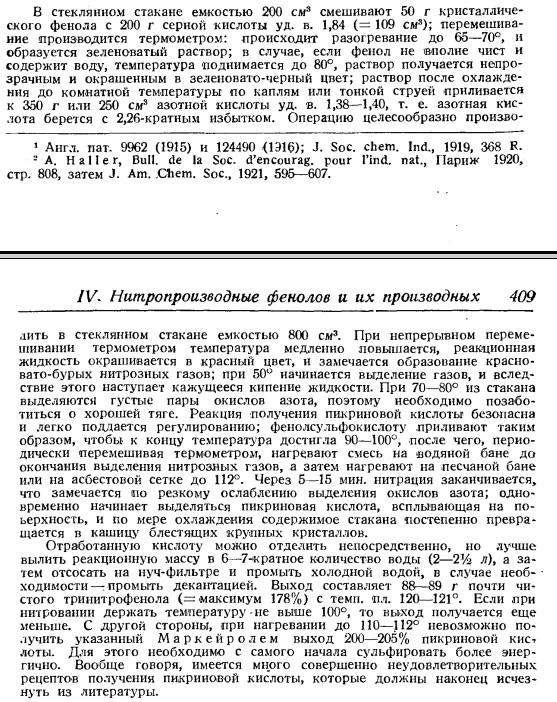 In a 300-ml conical flask, I weighed out 20 g of phenol. The phenol had turned slightly pink from partial oxidation during storage, but this is acceptable for the synthesis. Next, 44 ml (80 g) of sulfuric acid with a density of 1.84 g/cm3 was required. I measured the density of my available sulfuric acid at 1.835 g/cm3 and decided to increase the volume to 55 ml. I placed a magnetic stir bar into the flask containing phenol, closed the flask, and stirred it manually. Most of the phenol dissolved rapidly, forming a dark green liquid, while some melted and floated on the surface of the acid. I then placed the flask on a magnetic stirrer and switched it on. The stirrer broke after just a few seconds! Later, I learned that two identical stirrers belonging to my colleague had failed, and despite being a qualified physicist, he had never been able to repair them. This one also proved beyond repair - I now use it simply as an electric hotplate. Fortunately, I had another stirrer - an old one from the former Czechoslovakia. However, it could stir but not heat. While heating is nominally provided, these devices quickly fail if used as heaters because they lack any protection against acids or other aggressive liquids seeping inside. At first, I stirred the mixture by rotating the flask manually. The phenol dissolved quickly. I then placed the flask on the working stirrer, shielding it from the acids with a plastic bag and a paper instrument manual used as a barrier. Next, I poured 100 ml (141 g) of nitric acid with a density of 1.41 g/cm3 into a separate flask and placed it on the stirrer. The phenol-sulfuric acid solution was transferred to a separatory funnel fixed above the flask. I opened the tap so that the solution dripped slowly into the nitric acid. The acid in the flask gradually turned yellow. The stirrer's heating function was off, but the mixture warmed up due to the heat of the reaction. As the process continued, the solution in the flask became red-brown and increasingly intense in color. Brown nitrous gases began to evolve, slowly at first, then more vigorously. In time, the gas space above the liquid turned dark brown, and the solution itself became hot. The evolution of nitrogen oxides intensified. It should be emphasized that the entire synthesis was carried out under a switched-on fume hood. Inhalation of these caustic and toxic gases must be strictly avoided. Then, quite unexpectedly, picric acid began to crystallize. The brown solution transformed within seconds into a golden-yellow suspension while still releasing brown gas. When all the solution had drained from the funnel, the first stage of the synthesis was complete. __________________________________________________ 1 See the monograph: А. Штетбахер Пороха и взрывчатые вещества, ОНТИ, 1936 / A. Stettbacher Powders and Explosives, ONTI, 1936 [link]. |
|
Нитрование фенола: синтез пикриновой кислоты - Часть 6
В предыдущих частях статьи описано получение комплекса железо-фенол. Это исключительно простой эксперимент, однако, будучи уже немолодым химиком, я его провел только недавно. Вдохновившись, решил осуществить другой простой эксперимент с фенолом, который мне не приходилось видеть - нитрование фенола с образованием пикриновой кислоты (2,4,6-тринитрофенол).
Нитрование - процесс получения нитропроизводных или эфиров азотной кислоты. Обычно нитрование проводят с помощью смеси концентрированной серной кислоты с концентрированной азотной кислотой, которая называется "нитрующая смесь". Реже используют концентрированную азотную кислоту или другие нитрующие агенты. Однако, этот распространенный метод подходит не для всех соединений. Один из примеров такого соединения является фенол. Как мы убедились, фенол окисляется даже при контакте с воздухом. Не удивительно, что азотная кислота легко окисляет фенол. Поэтому прямое нитрование фенола смесью серной и азотной кислот (или одной азотной кислотой) в данном случае неприемлемо. Чтобы решить проблему окисления фенола, поступают следующим образом. Сначала фенол растворяют в концентрированной серной кислоте. Происходит разогрев смеси, фенол превращается в смесь моно- и дисульфофенолов. Другими словами, происходит сульфирование фенола. Сульфофенолы гораздо более устойчивы к окислению, чем фенол. Затем раствор фенола в серной кислоте медленно приливают к азотной кислоте при тщательном перемешивании. В результате сульфокислоты переходят в смесь нитрофенолов. Для полного нитрования (введения трех нитрогрупп в молекулу фенола) реакционную смесь нагревают и выдерживают на водяной бане. Образуются кристаллы тринитрофенола, которые фильтруют и промывают холодной водой. Как вариант, реакционную массу выливают в воду, а затем фильтруют. В литературе описаны различные методики нитрования фенола, некоторые из них воспроизвели коллеги, опубликовав результаты в нашем журнале. Я выбрал методику, приведенную в монографии [1]. Такой выбор был сделан скорее из субъективных соображений - мне понравился стиль автора, который вселял надежду на его компетентность. "В стеклянном стакане емкостью 200 см3 смешивают 50 г кристаллического фенола с 200 г серной кислоты уд. в. 1.84 (= 109 см3); перемешивание производится термометром: происходит разогревание до 65-70°С, и образуется зеленоватый раствор; в случае, если фенол не вполне чист и содержит воду, температура поднимается до 80°С, раствор получается непрозрачным и окрашенным в зеленовато-черный цвет; раствор после охлаждения до комнатной температуры по каплям или тонкой струей приливается к 350 г или 250 см3 азотной кислоты уд. в. 1.38-1.40, т. е. азотная кислота берется с 2.26-кратным избытком. Операцию целесообразно производить в стеклянном стакане емкостью 800 см3. При непрерывном перемешивании термометром температура медленно повышается, реакционная жидкость окрашивается в красный цвет, и замечается образование красновато-бурых нитрозных газов; при 50°С начинается выделение газов, и вследствие этого наступает кажущееся кипение жидкости. При 70-80°С из стакана выделяются густые пары окислов азота, поэтому необходимо позаботиться о хорошей тяге. Реакция получения пикриновой кислоты безопасна и легко поддается регулированию; фенолсульфокислоту приливают таким образом, чтобы к концу температура достигла 90-100°С, после чего, периодически перемешивая термометром, нагревают смесь на водяной бане до окончания выделения нитрозных газов, а затем нагревают на песчаной бане или на асбестовой сетке до 112°С. Через 5-15 мин. нитрация заканчивается, что замечается по резкому ослаблению выделения окислов азота; одновременно начинает выделяться пикриновая кислота, всплывающая на поверхность, и по мере охлаждения содержимое стакана постепенно превращается в кашицу блестящих крупных кристаллов. Отработанную кислоту можно отделить непосредственно, но лучше вылить реакционную массу в 6-7-кратное количество воды (2-2.5 л), а затем отсосать на нуч-фильтре и промыть холодной водой, в случае необходимости - промыть декантацией. Выход составляет 88-89 г почти чистого тринитрофенола (= максимум 178%) с темп. пл. 120-121°С. Если при нитровании держать температуру не выше 100°С, то выход получается еще меньше. С другой стороны, при нагревании до 110-112°С невозможно получить указанный Маркейролем выход 200-205% пикриновой кислоты. Для этого необходимо с самого начала сульфировать более энергично. Вообще говоря, имеется много совершенно неудовлетворительных рецептов получения пикриновой кислоты, которые должны наконец исчезнуть из литературы."  В конической колбе на 300 мл взвесил 20 г фенола. Фенол был розовым (частичное окисление при хранении), но для данного синтеза это допустимо. Далее было необходимо добавить 44 мл (80 г) серной кислоты с плотностью 1.84 г/см3. Измерил плотность имеющейся серной кислоты, она равна была 1.835 г/см3, поэтому решил увеличить количество кислоты до 55 мл. В колбу с фенолом поместил магнитный якорь (от мешалки), закрыл колбу, перемешал вручную. Большая часть фенола быстро растворилась, образовав темно-зеленую жидкость. Часть фенола расплавилась и всплыла на поверхность кислоты. Поставил колбу на магнитную мешалку, включил перемешивание. Мешалка через несколько секунд поломалась! Позже выяснилось, что у коллеги сломались две точно такие же мешалки, и он так и не смог их подчинить, будучи квалифицированным физиком. Эту мешалку также не удалось привести в рабочее состояние. Сейчас я использую ее как электроплитку. У меня была еще одна мешалка, старая, изготовленная еще в бывшей Чехословакии. Однако эта мешалка могла осуществлять только перемешивание без нагрева. Нагрев предусмотрен, но при попытке использовать такие мешалки в качестве нагревателей, они быстро выходят из строя. Причина в том, что данные магнитные мешалки абсолютно не защищены от попадания кислот и других агрессивных жидкостей внутрь корпуса. Сначала перемешивать пришлось вручную, вращая колбу. Фенол быстро растворился. Затем поставил колбу на исправную мешалку, предварительно защитив мешалку от попадания кислот с помощью полиэтиленового пакета и бумажной инструкции от прибора (которые служили физическим барьером). Налил в колбу 100 мл (141 г) азотной кислоты с плотностью 1.41 g/cm3, поставил на магнитную мешалку. Раствор фенола в серной кислоте перелил в делительную воронку, воронку закрепил над колбой и приоткрыл кран, чтобы раствор медленно капал в азотную кислоту. Кислота в колбе стала желтой. Как я уже отметил, мешалка не работала в качестве нагревателя, однако, смесь постепенно разогревалась за счет тепла химической реакции. Раствор в колбе стал красно-коричневым, его окраска становилась все более интенсивной. Началось выделение бурых нитрозных газов, которое постепенно усиливалось. Со временем газ над жидкостью стал темно-коричневым, раствор - бурым и горячим. Выделение оксидов азота все усиливалось. Не лишним будет напомнить, что синтез проводился внутри включенного вытяжного шкафа. Вдыхать едкие и токсичные оксиды азота недопустимо. Неожиданно начала кристаллизоваться пикриновая кислота - бурый раствор за несколько секунд превратился в золотисто-желтую суспензию, продолжая выделять бурый газ. Весь раствор из воронки постепенно стек в колбу. Первый этап синтеза завершен. |
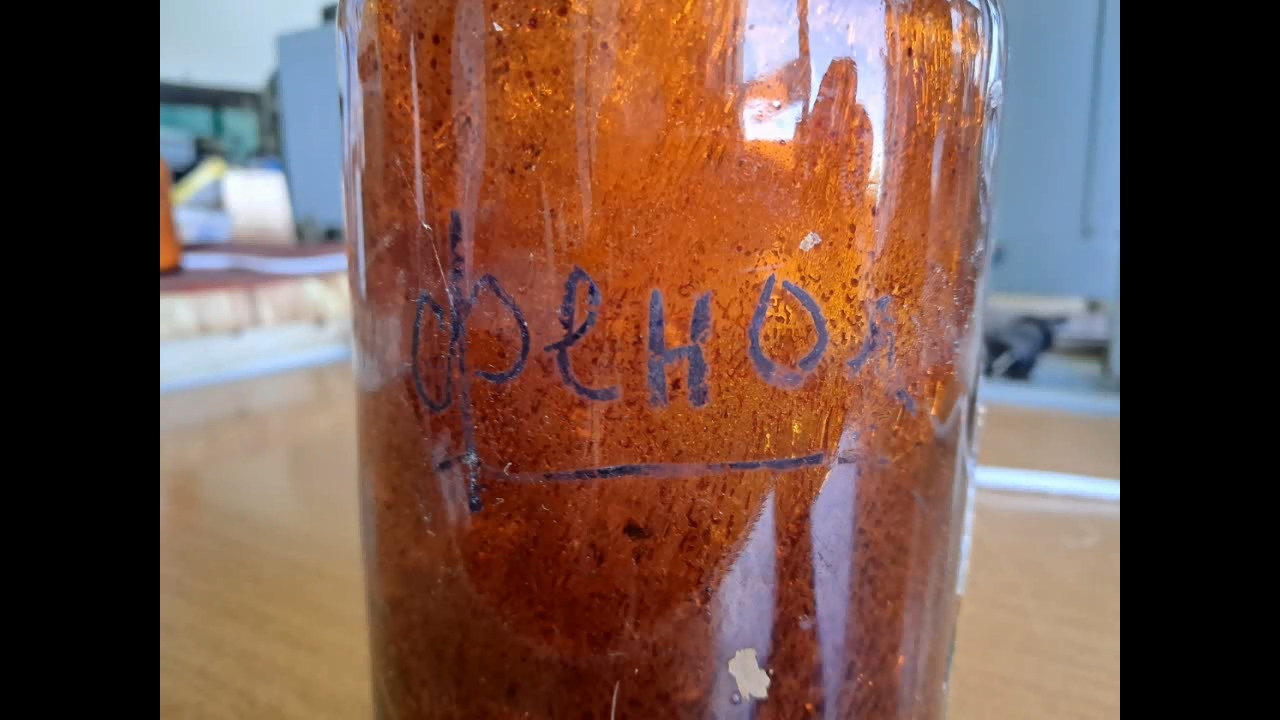
Nitration of Phenol: Synthesis of Picric Acid |
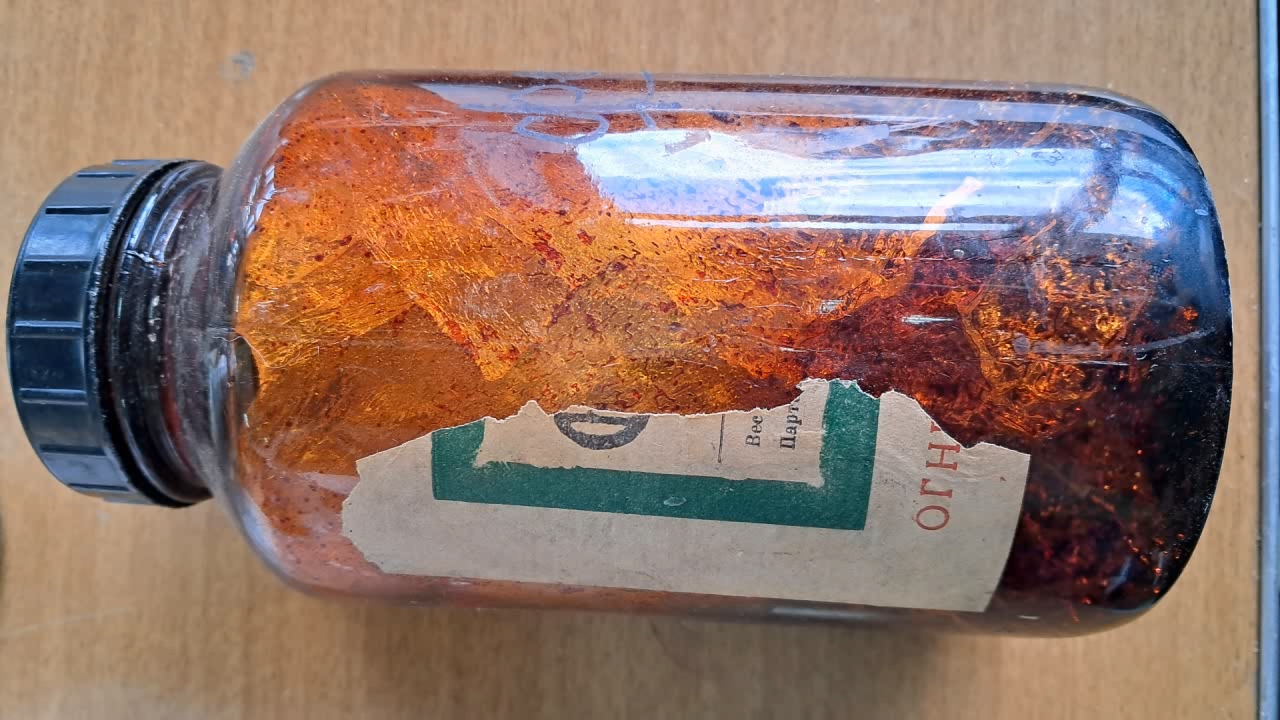
|
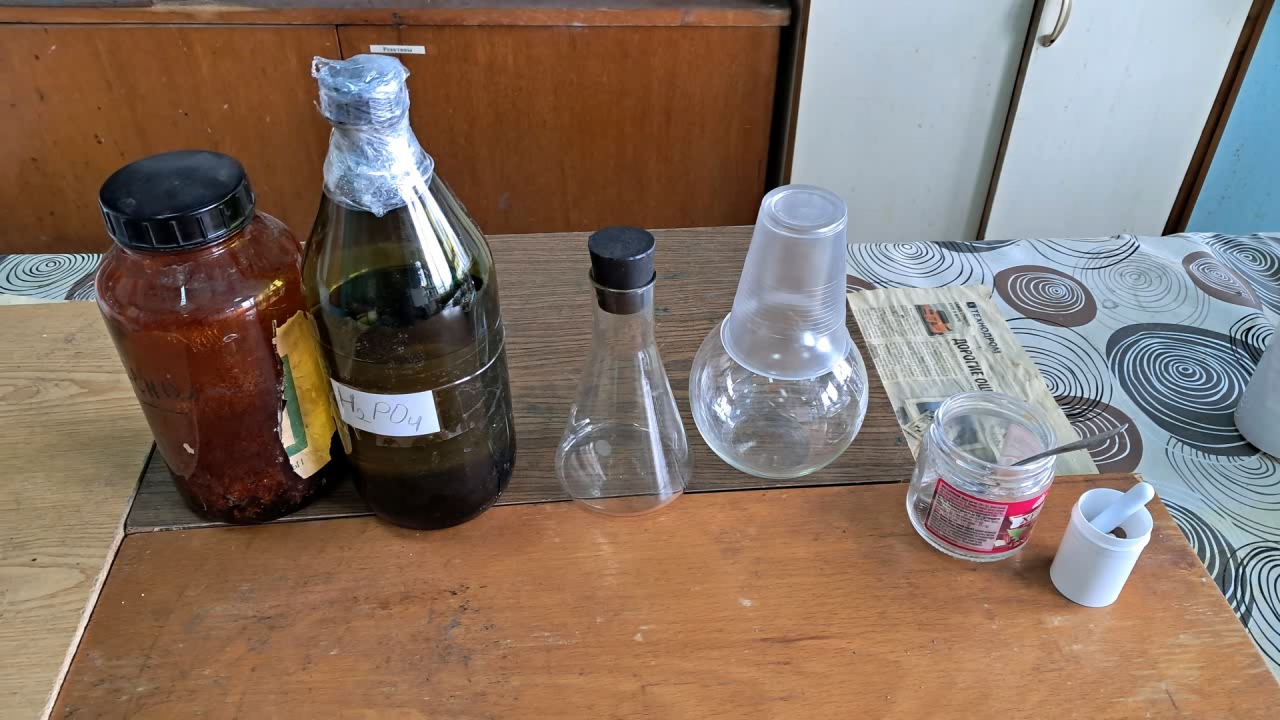
|
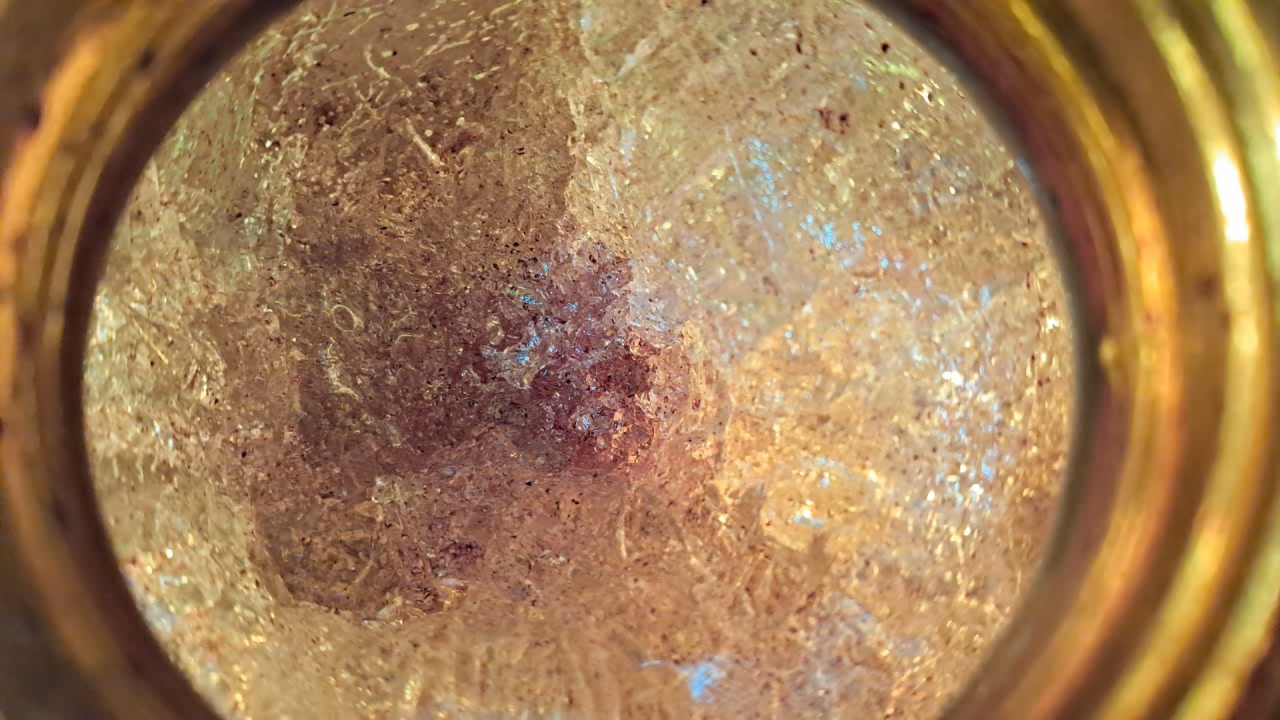
|
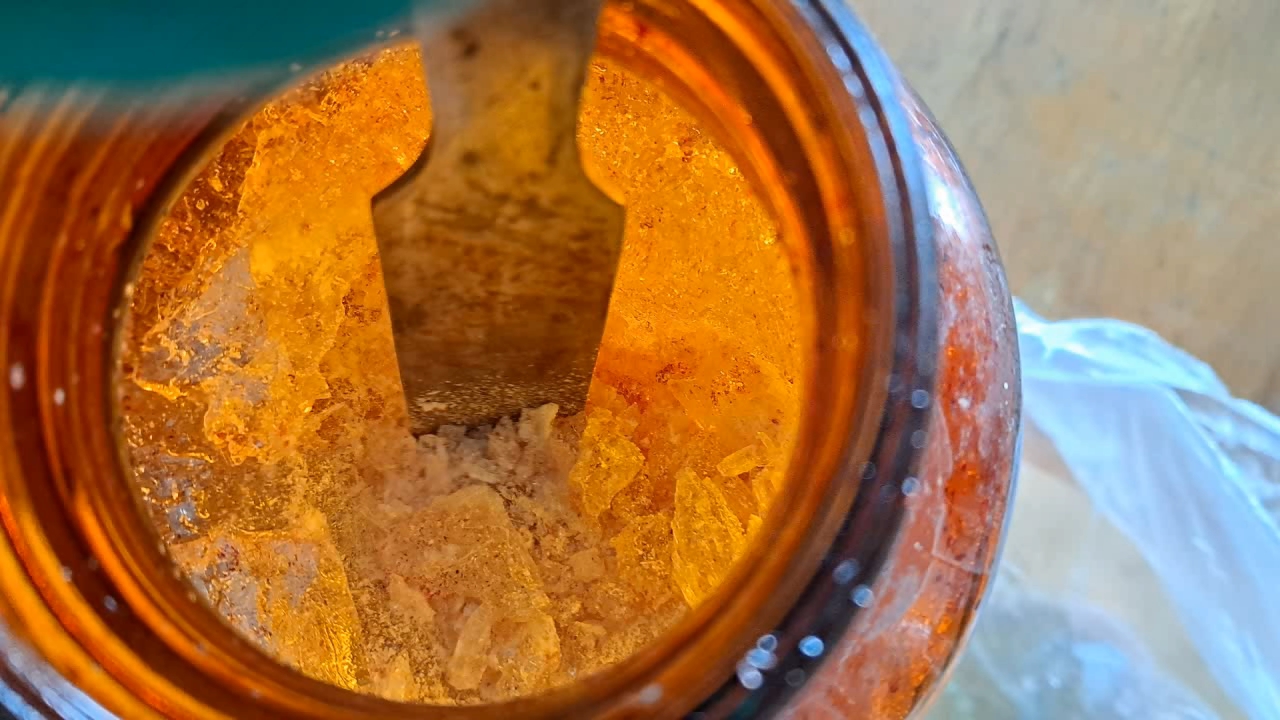
|
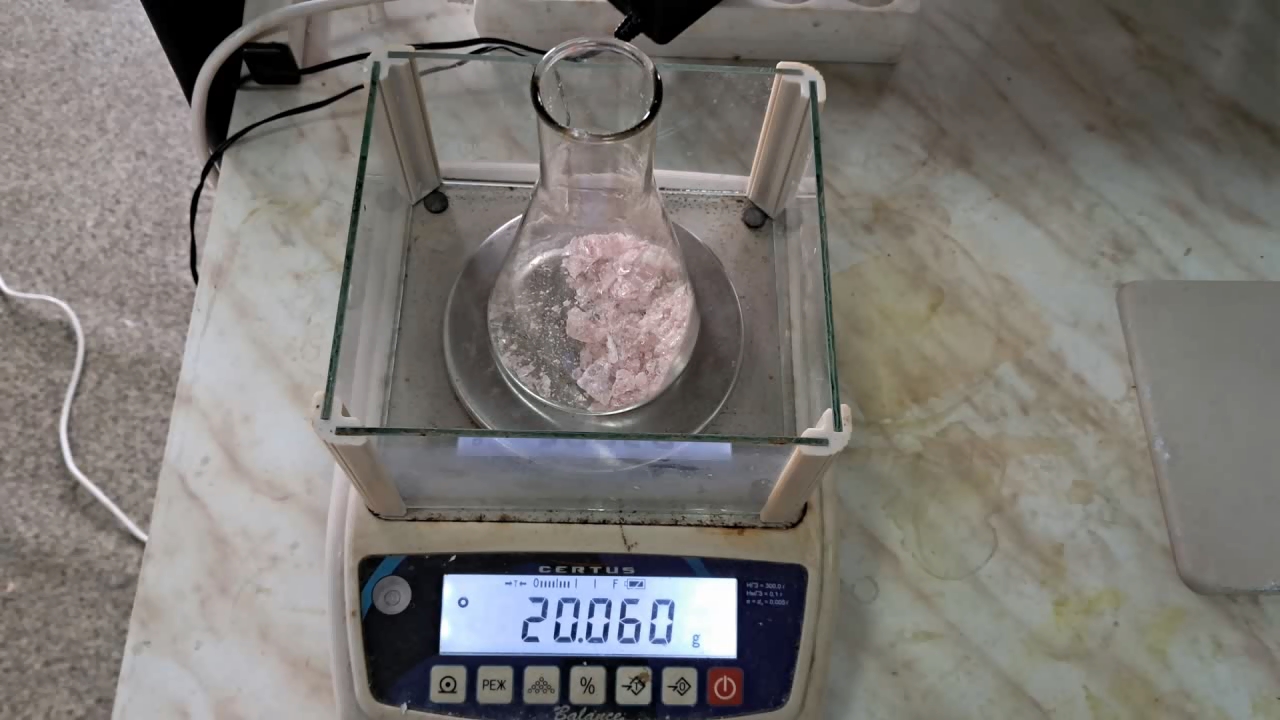
|
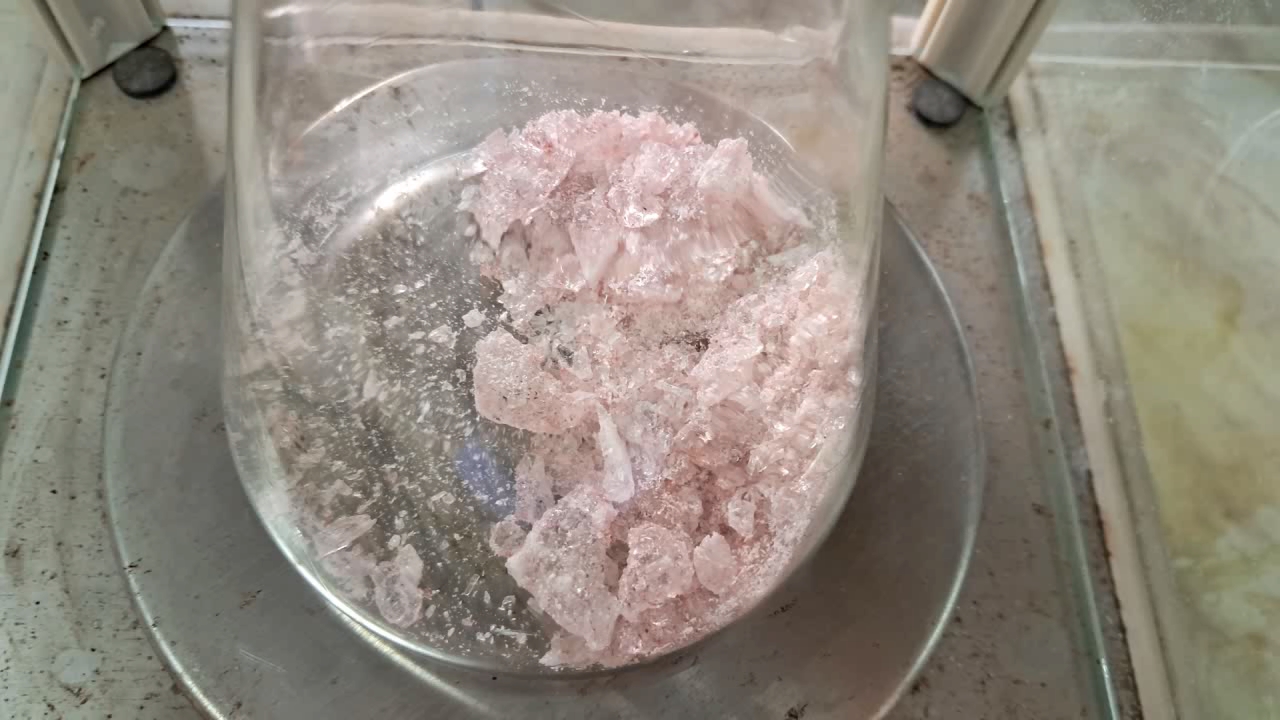
|
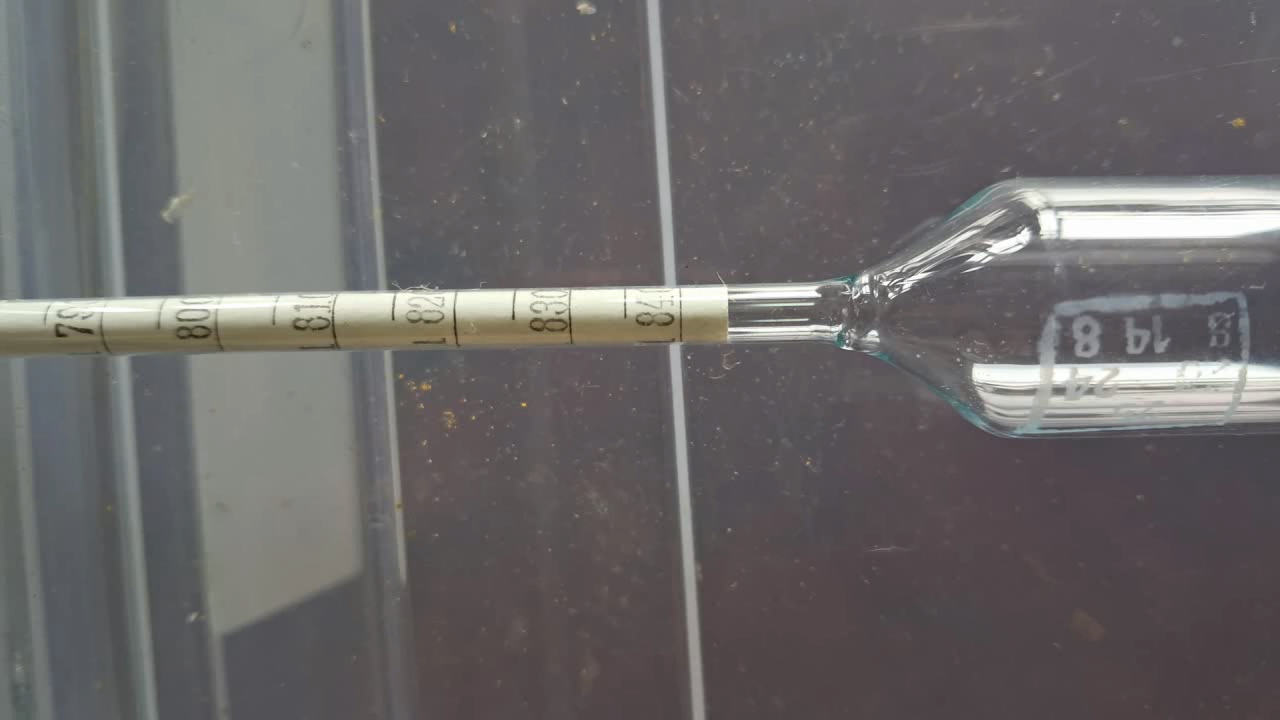
|
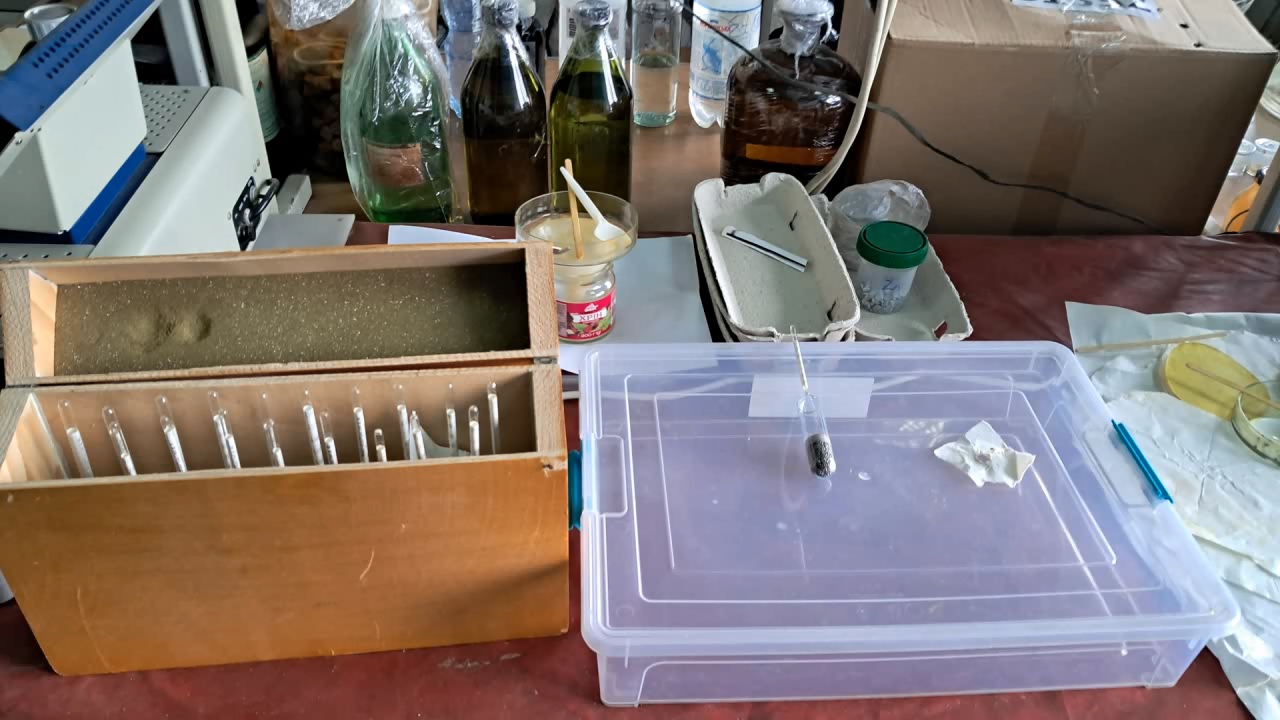
|
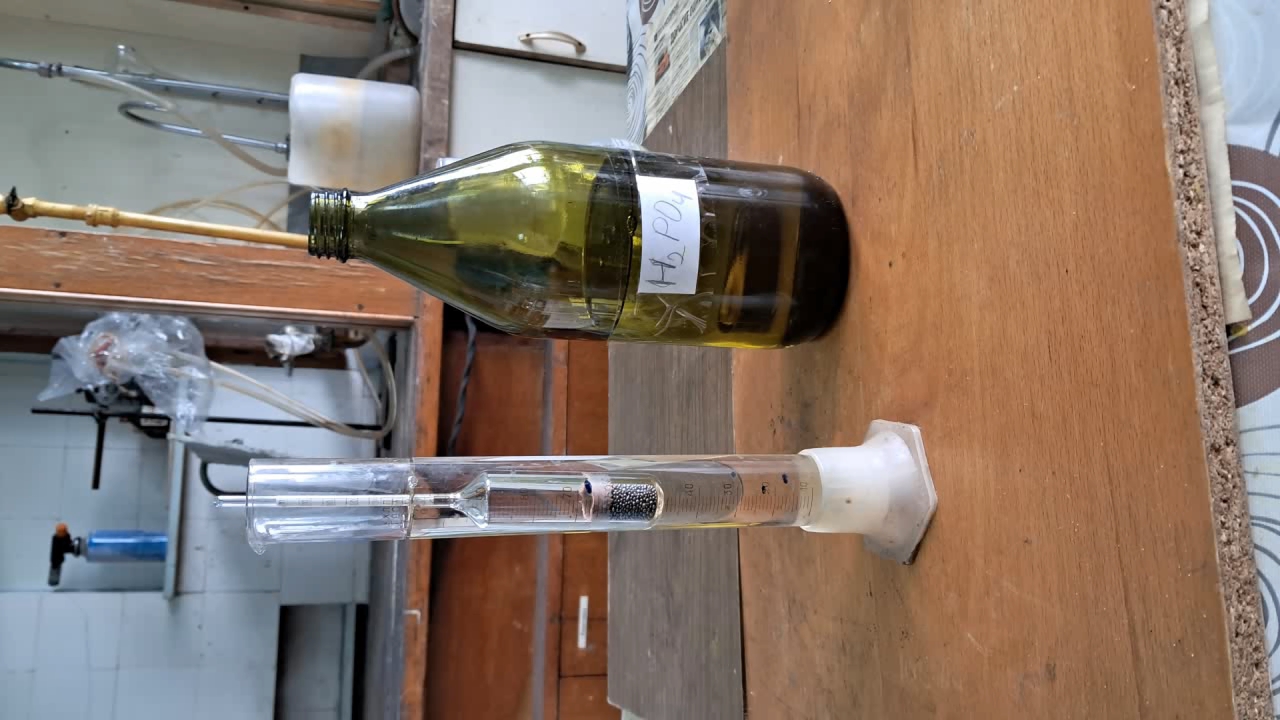
|

|
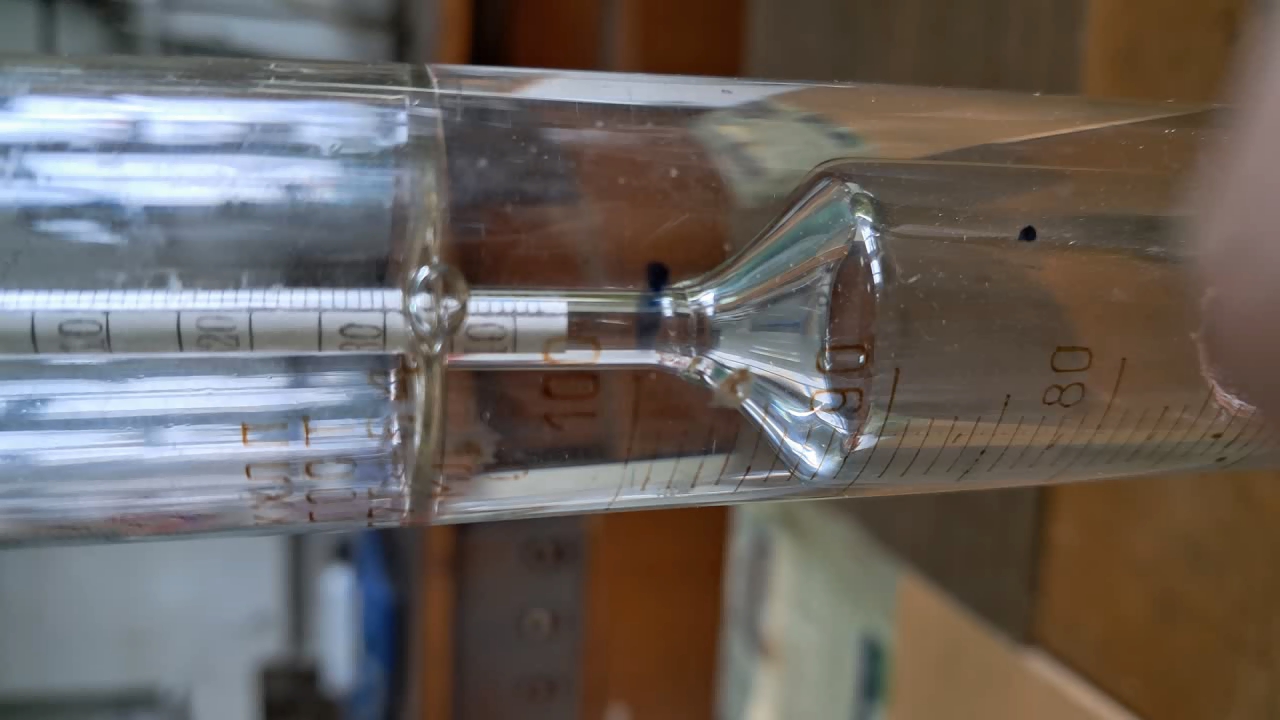
|
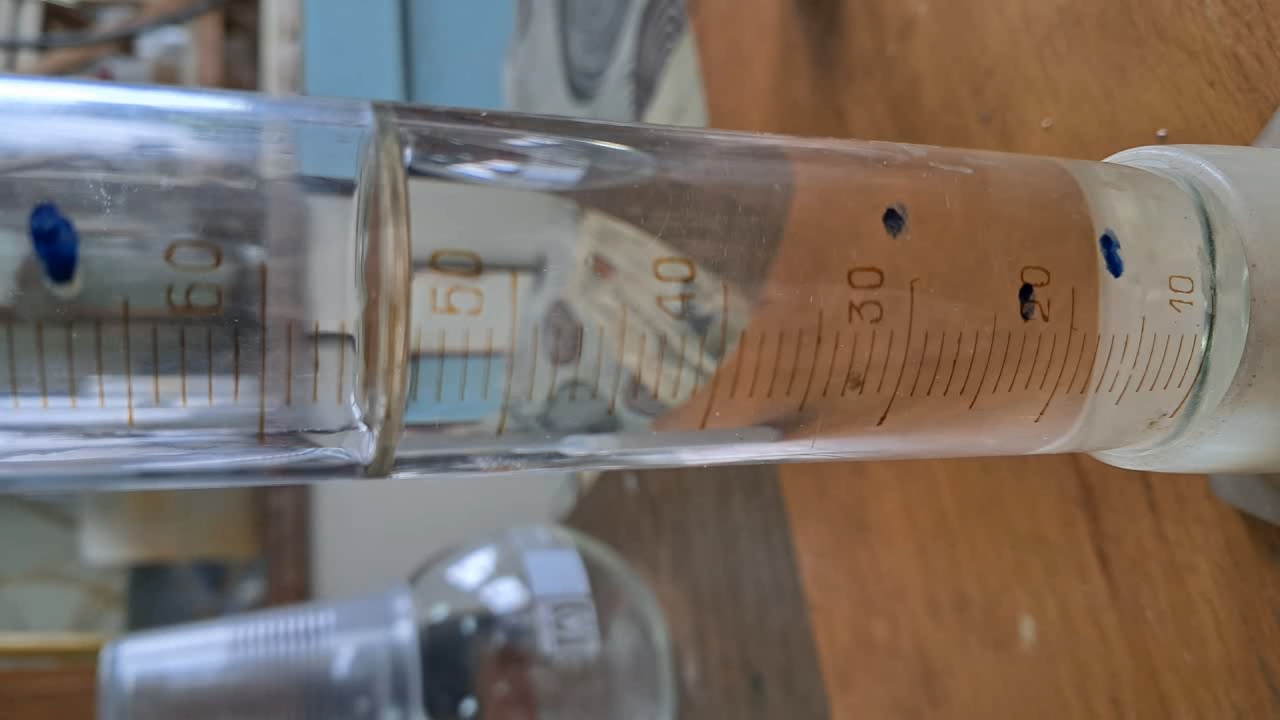
|
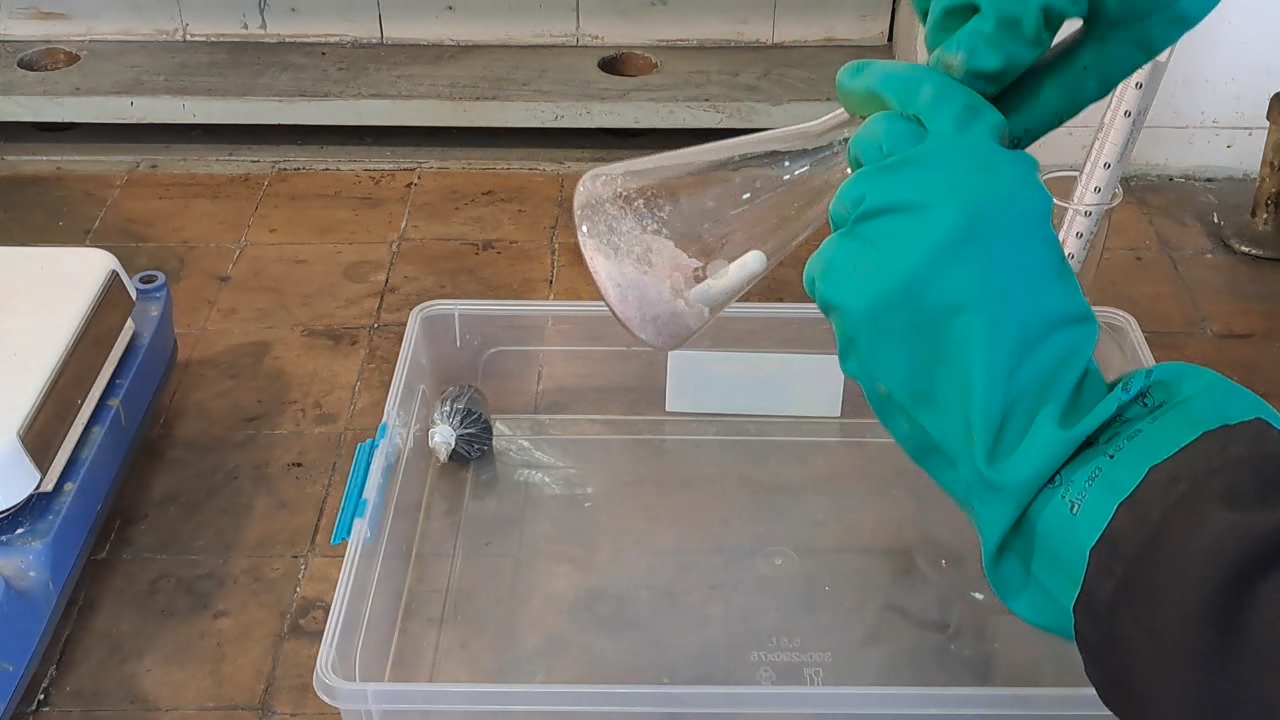
|
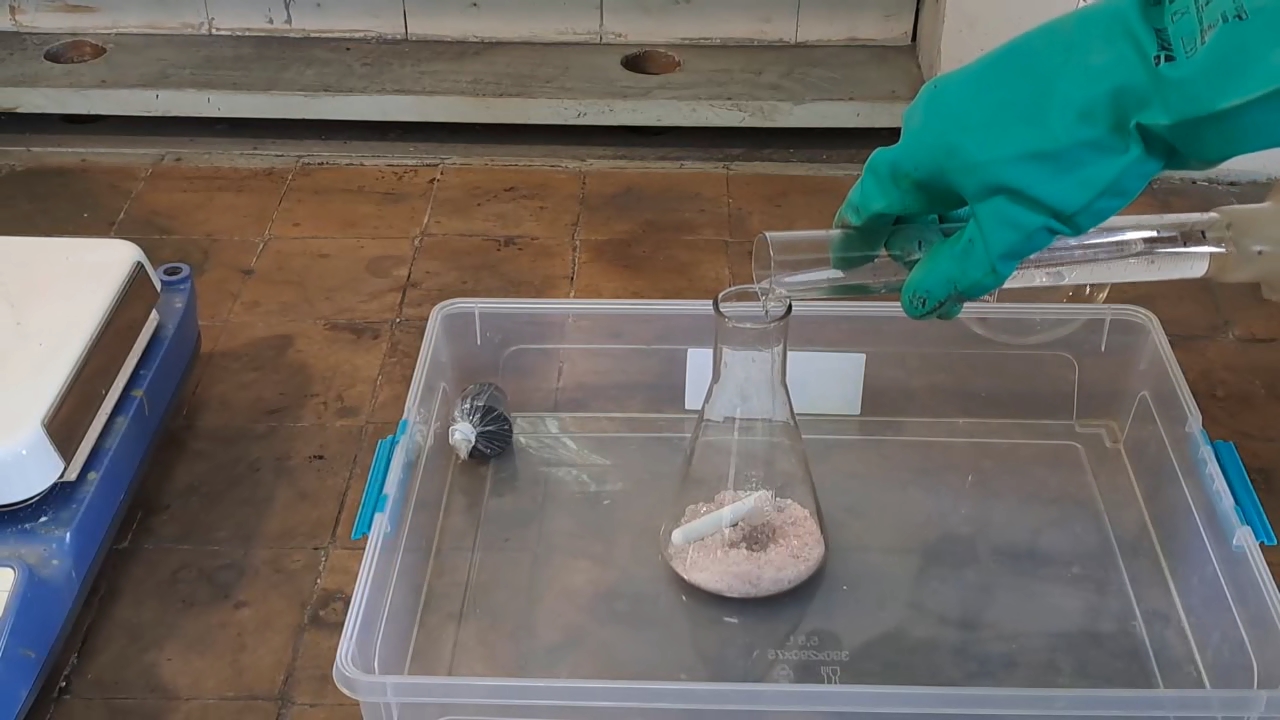
|
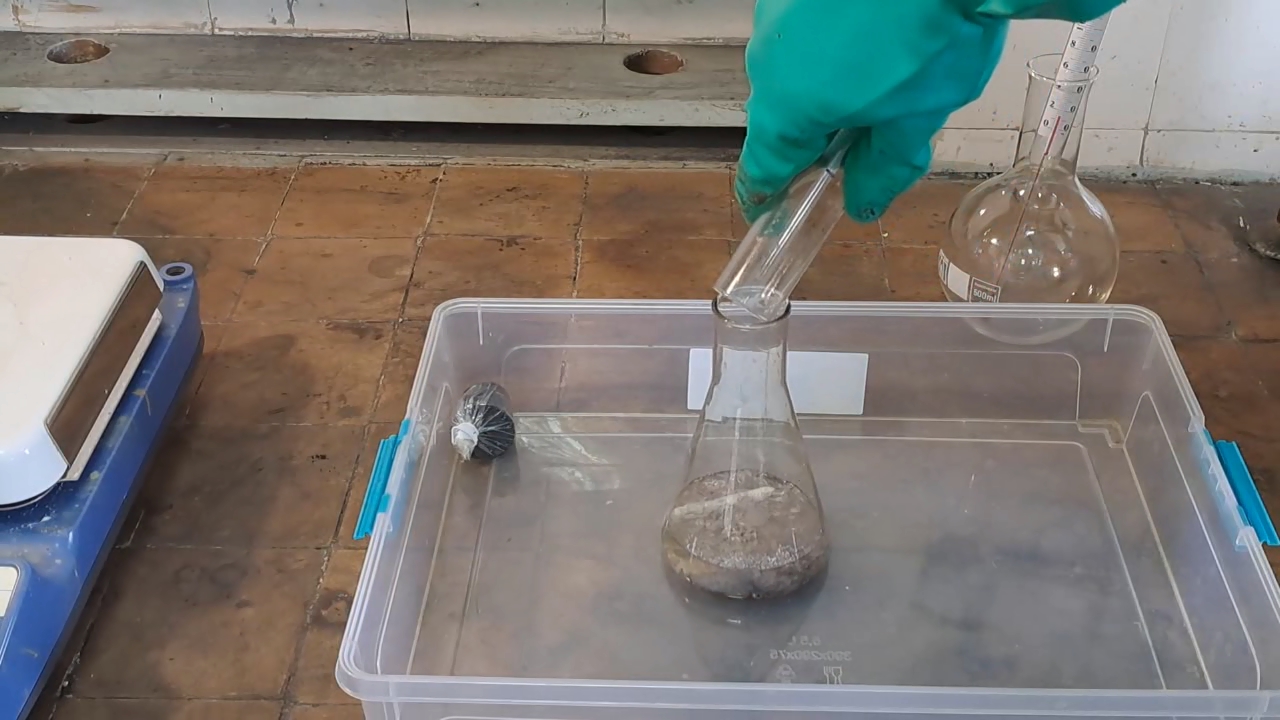
|
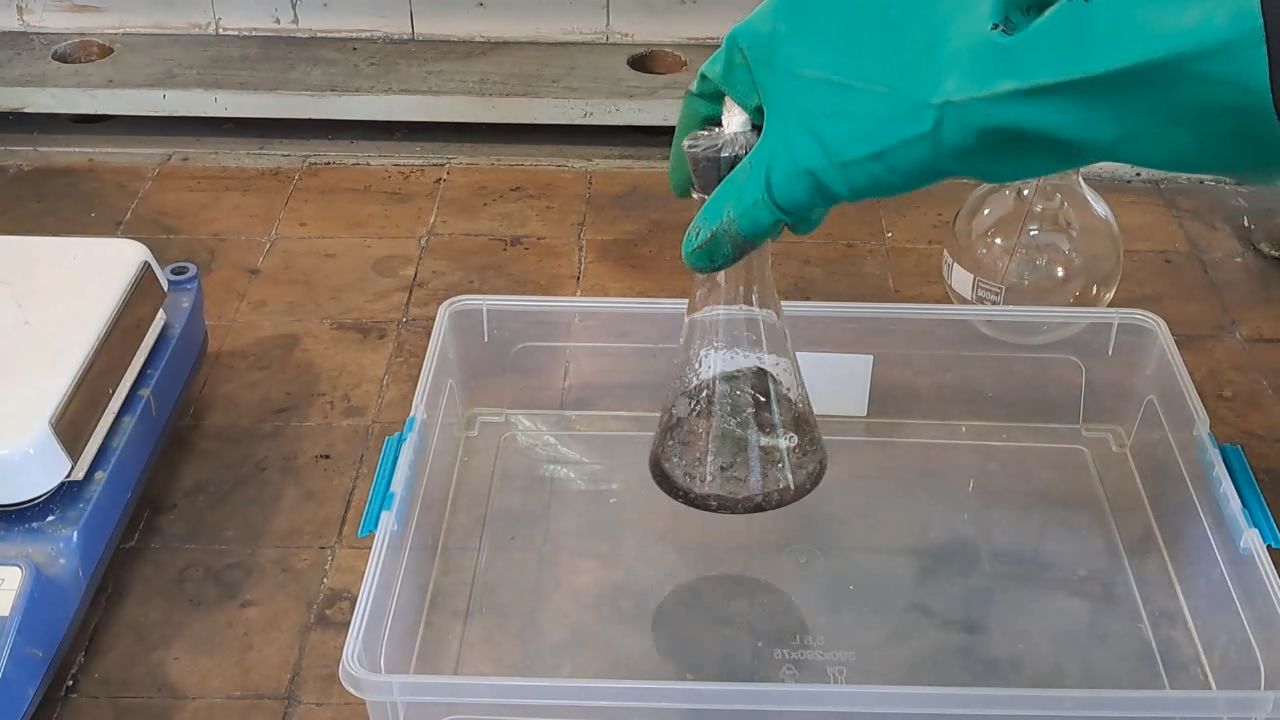
|
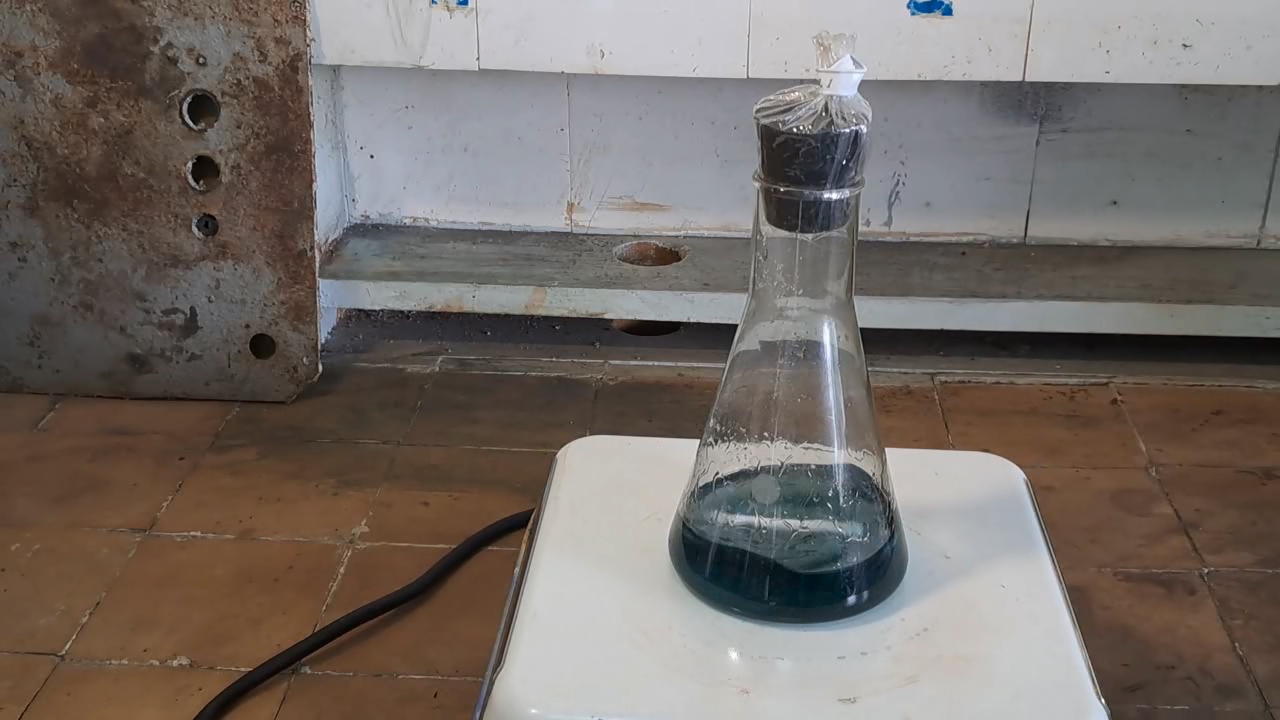
|

|
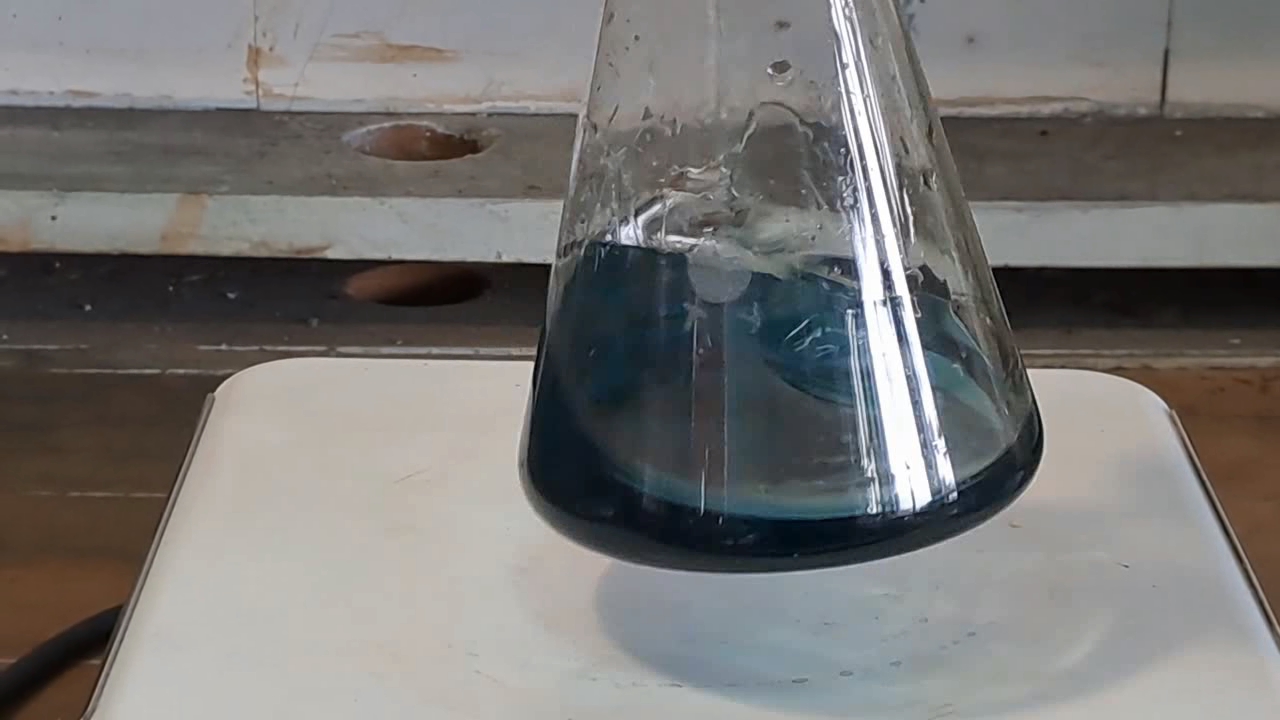
|
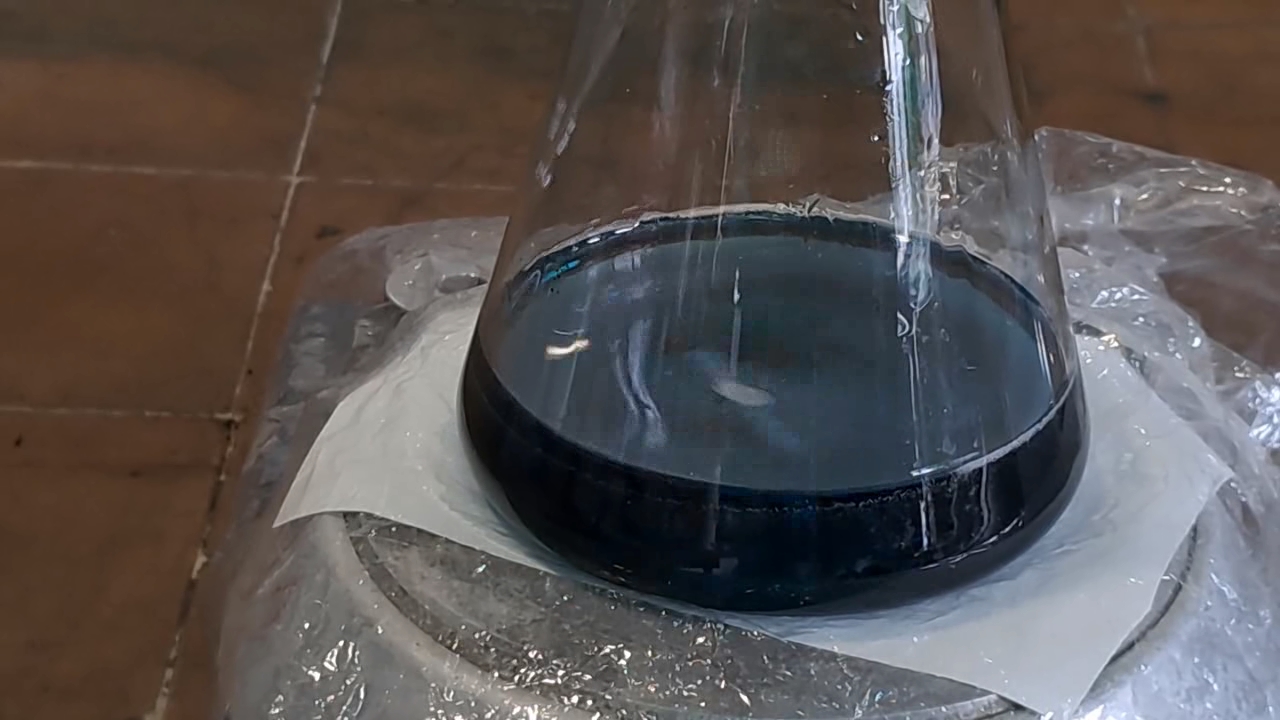
|
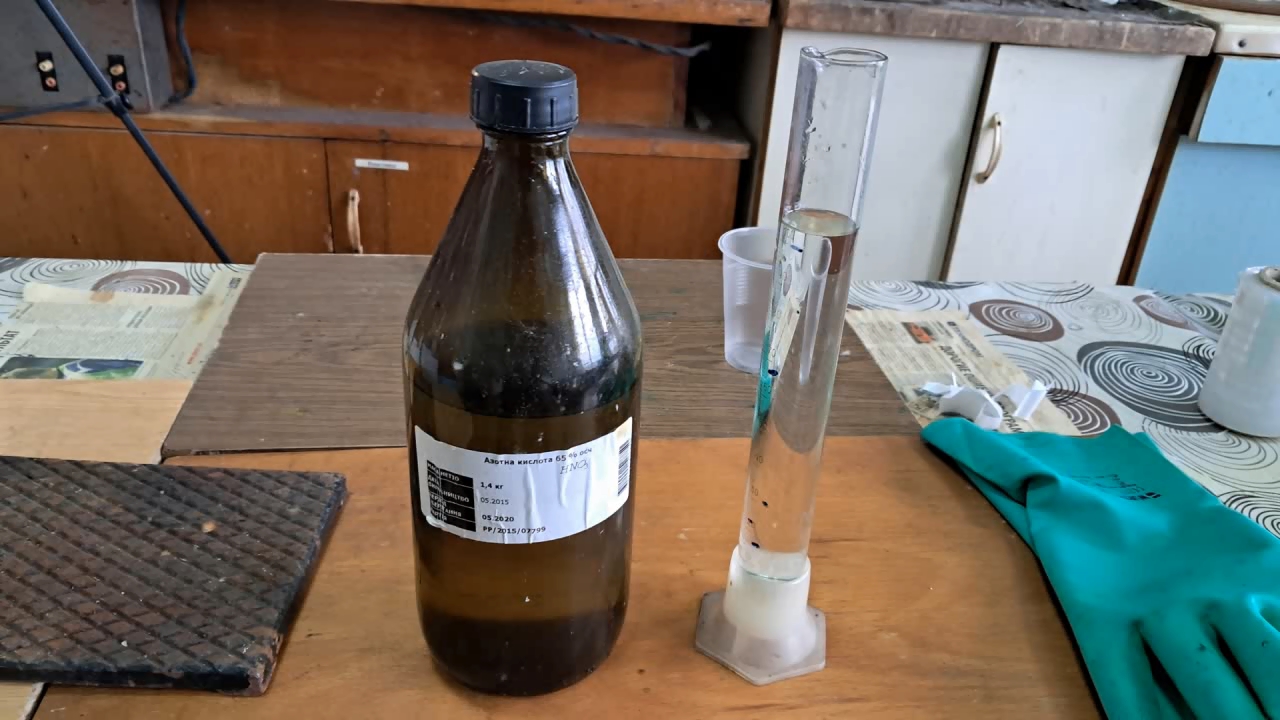
|
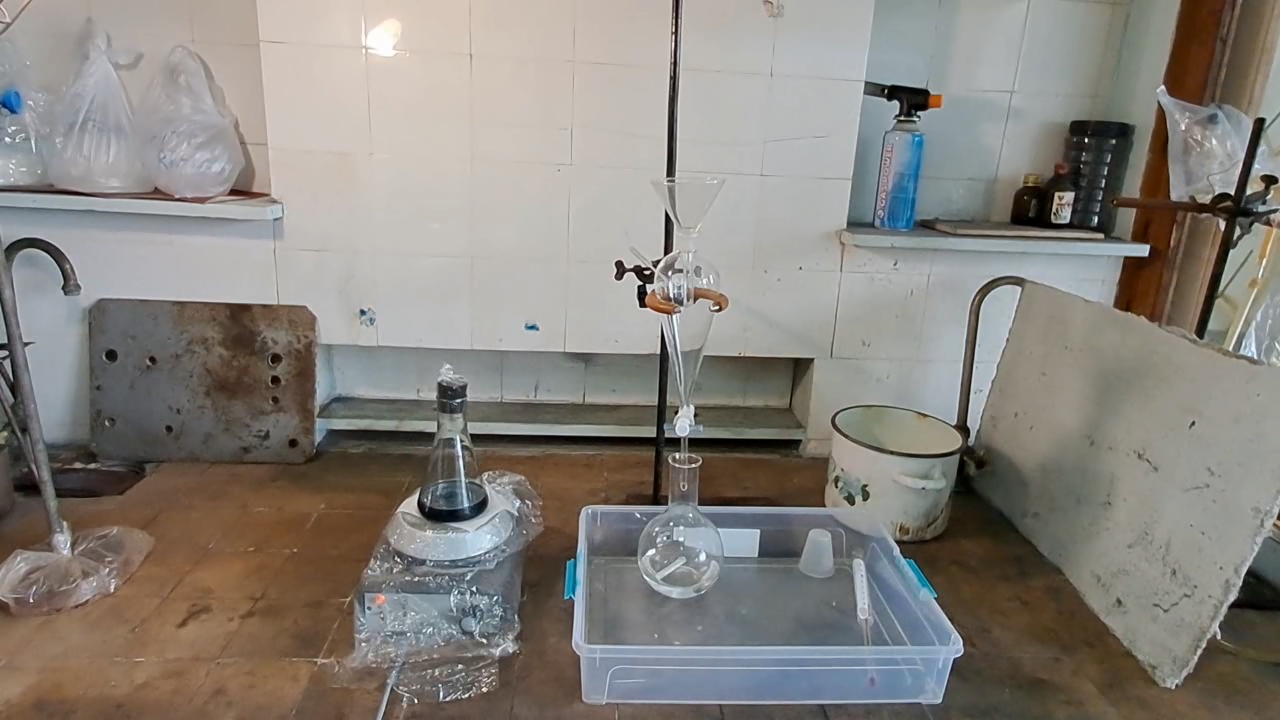
|
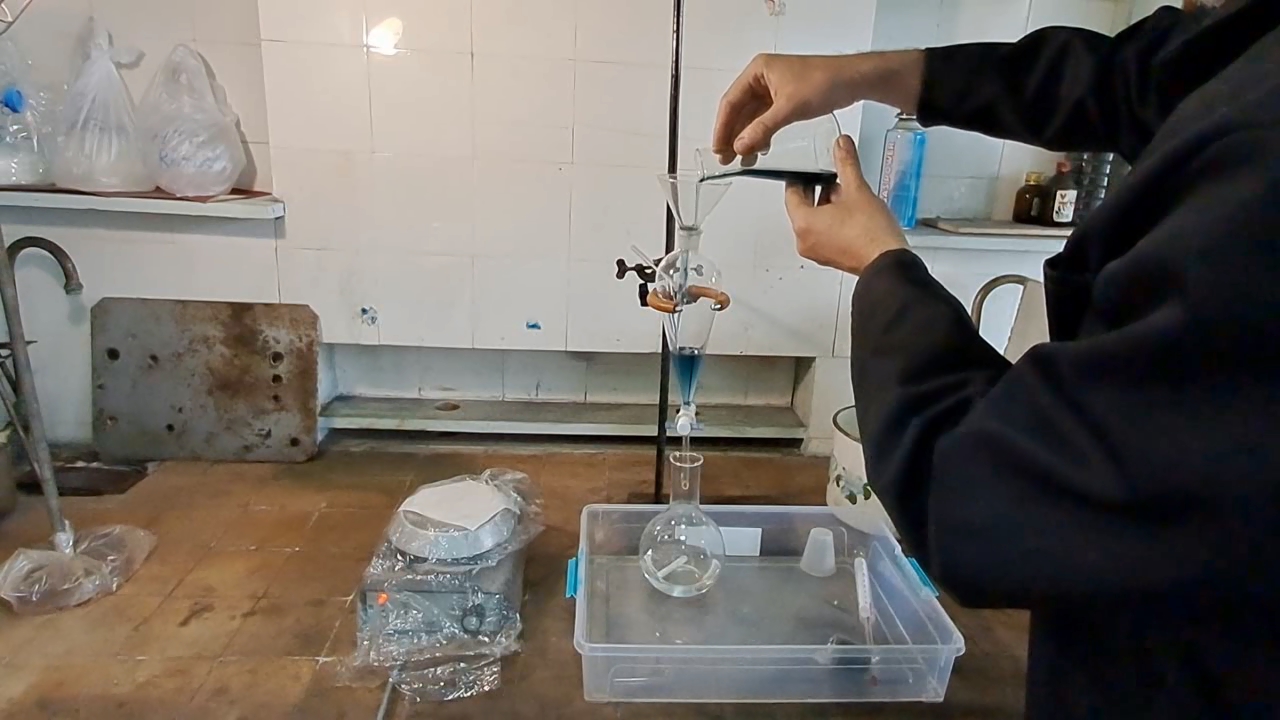
|
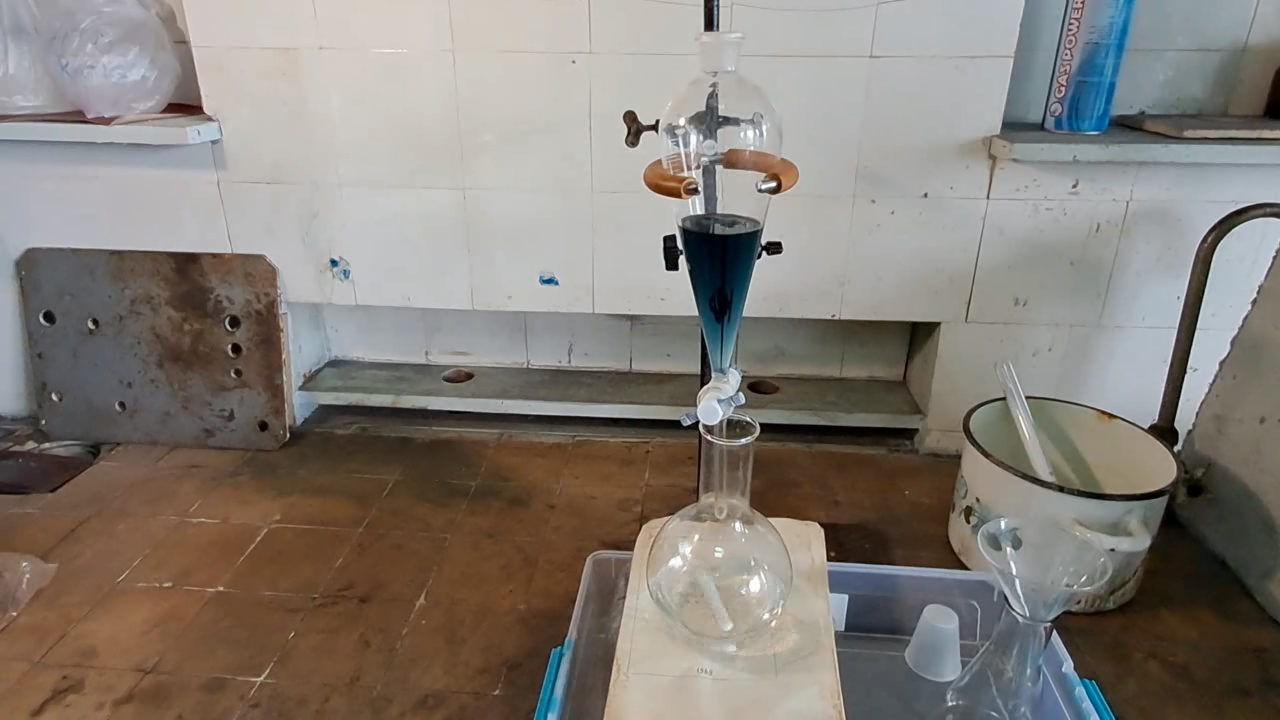
|
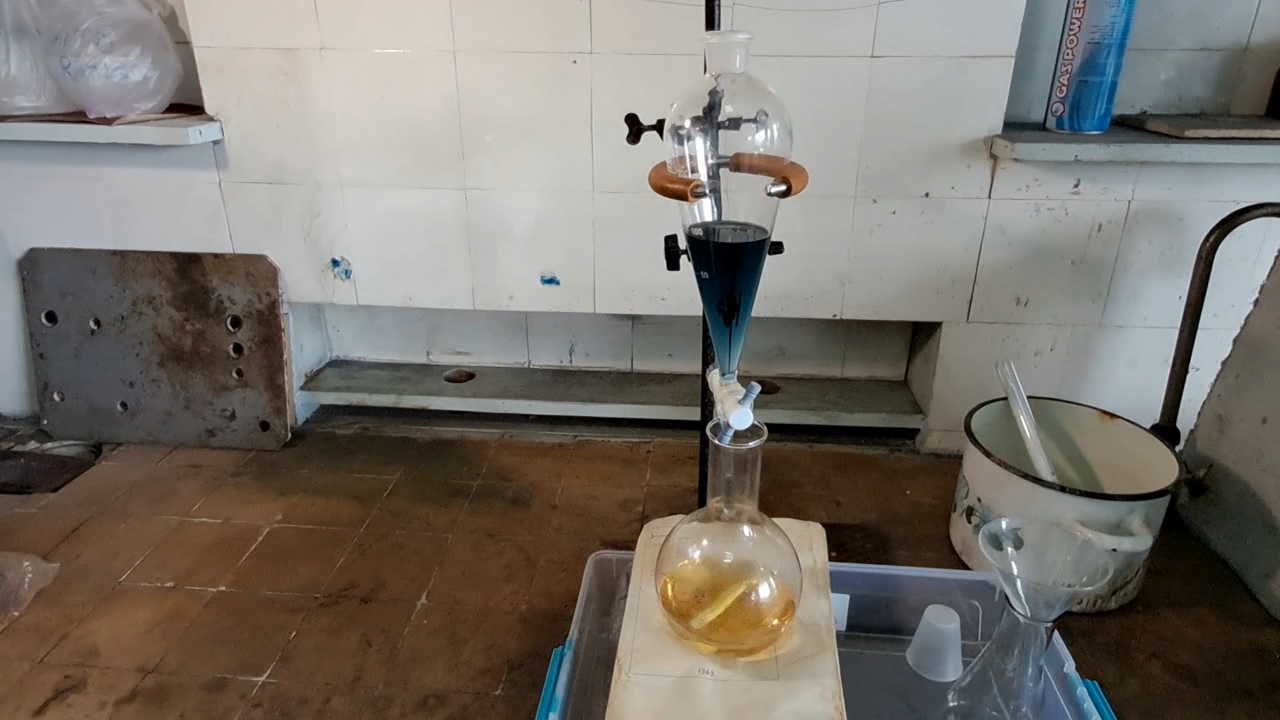
|
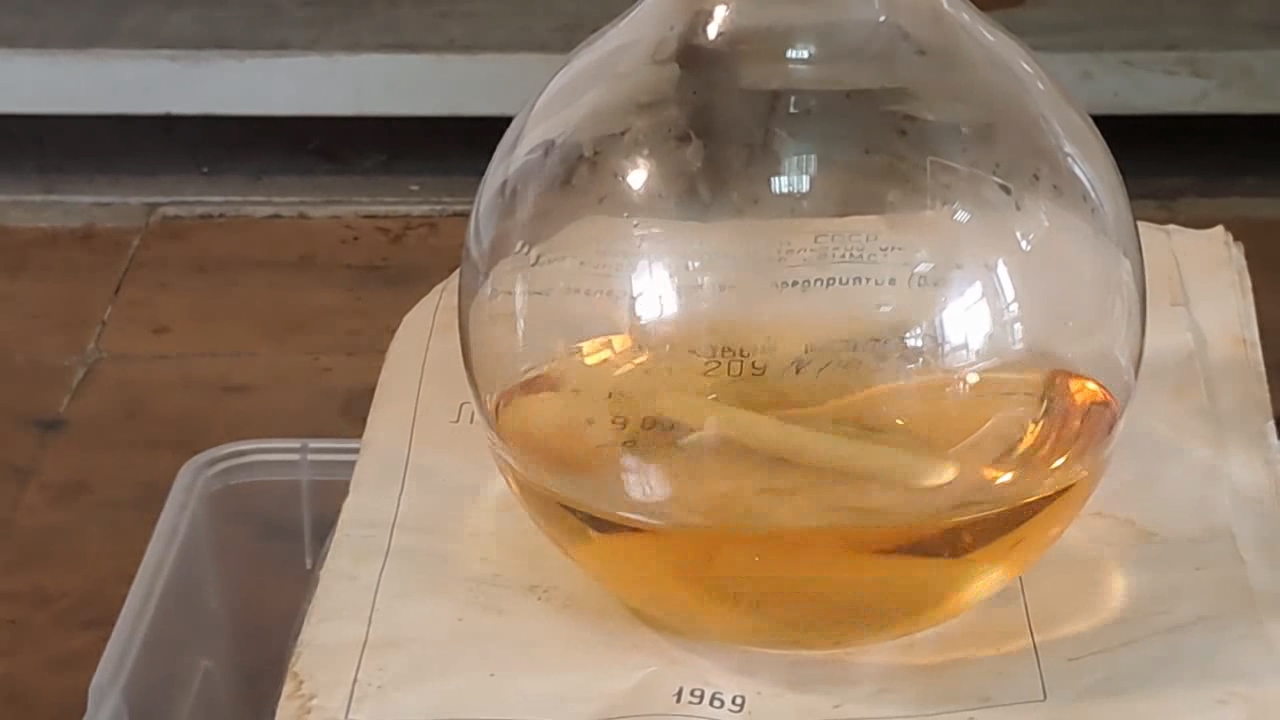
|
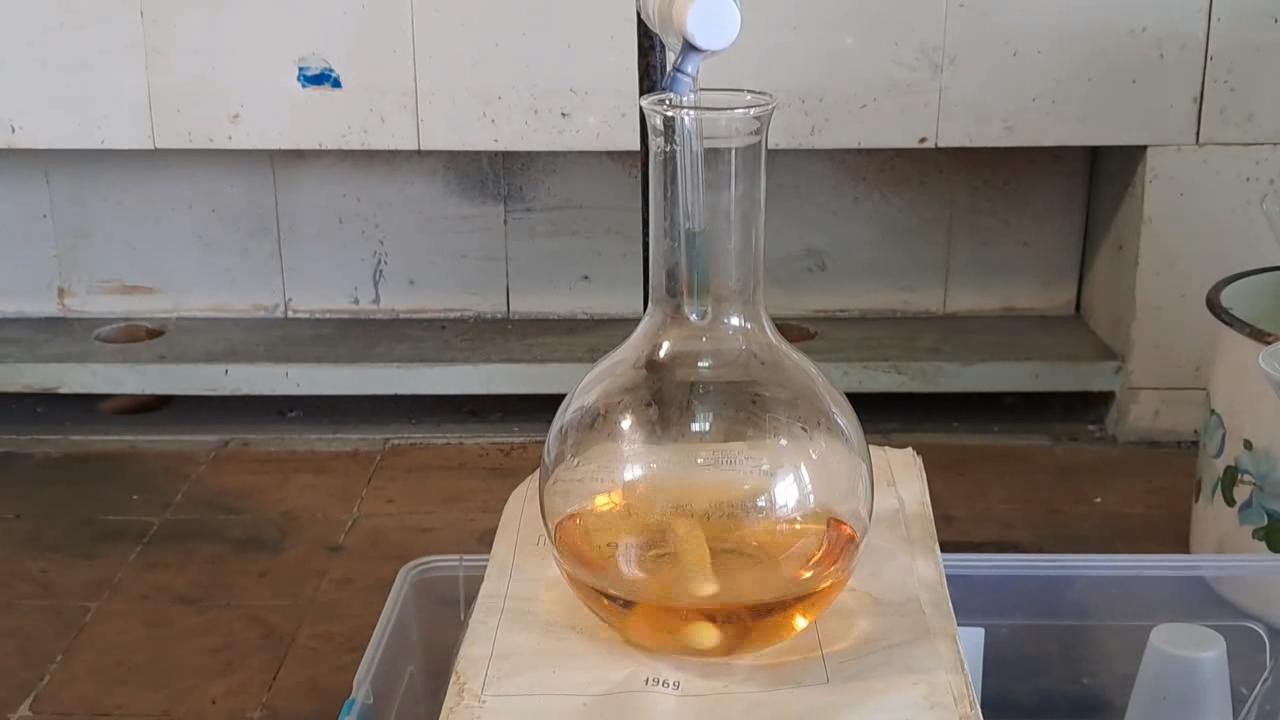
|
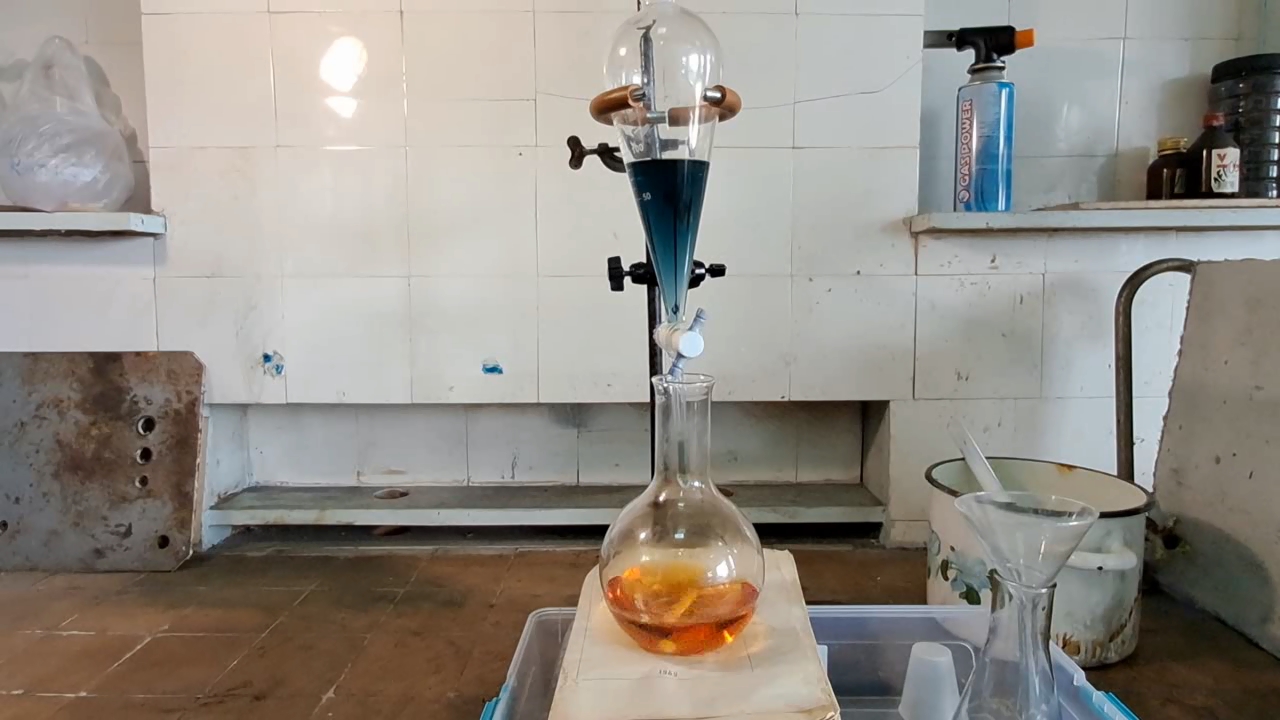
|
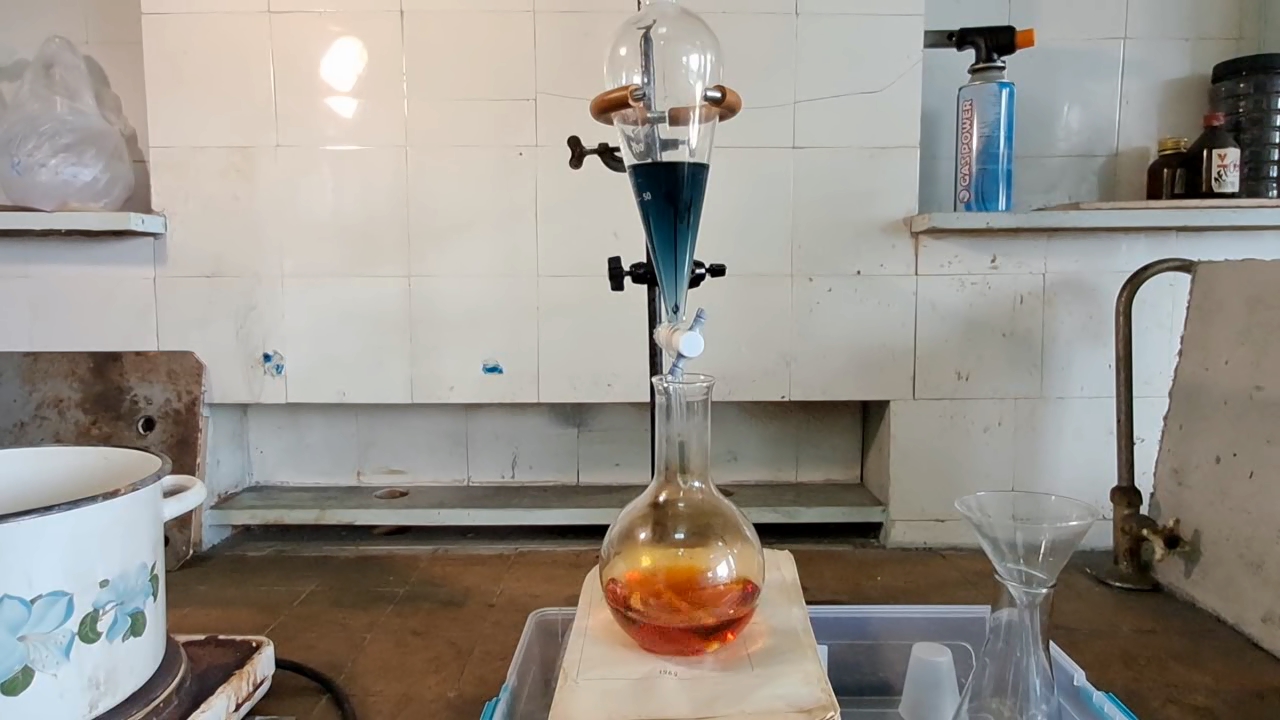
|
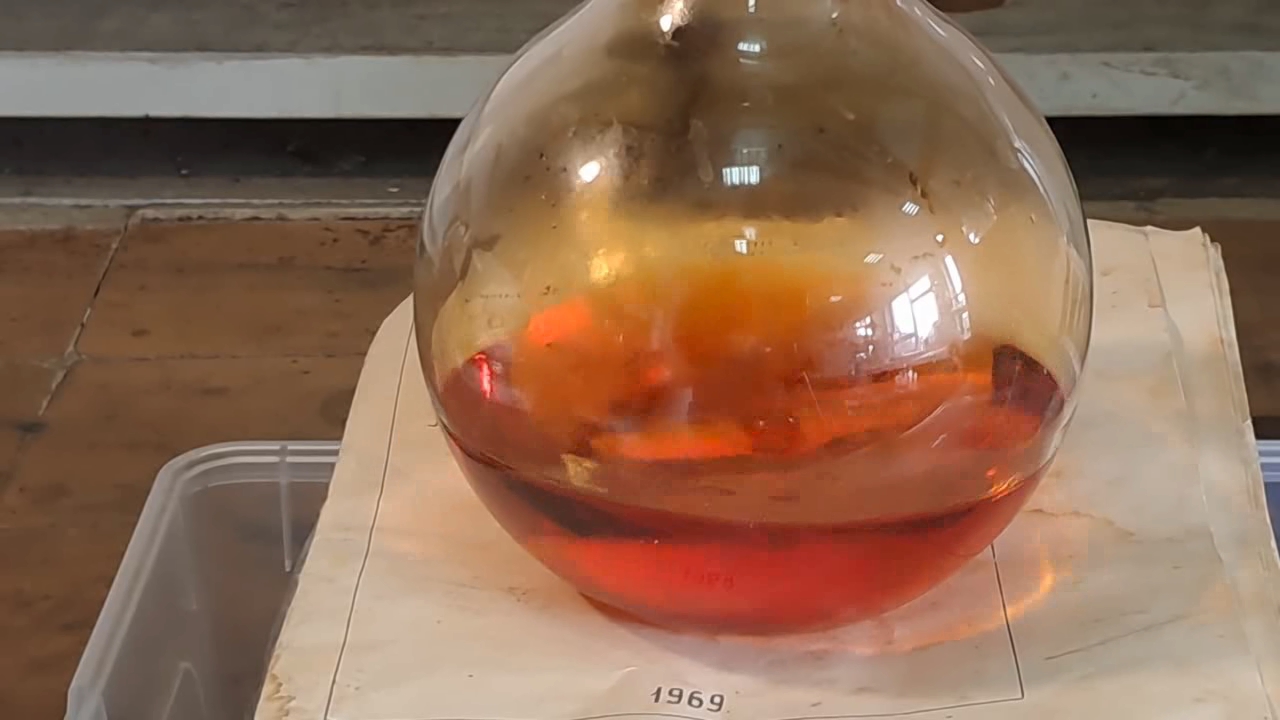
|
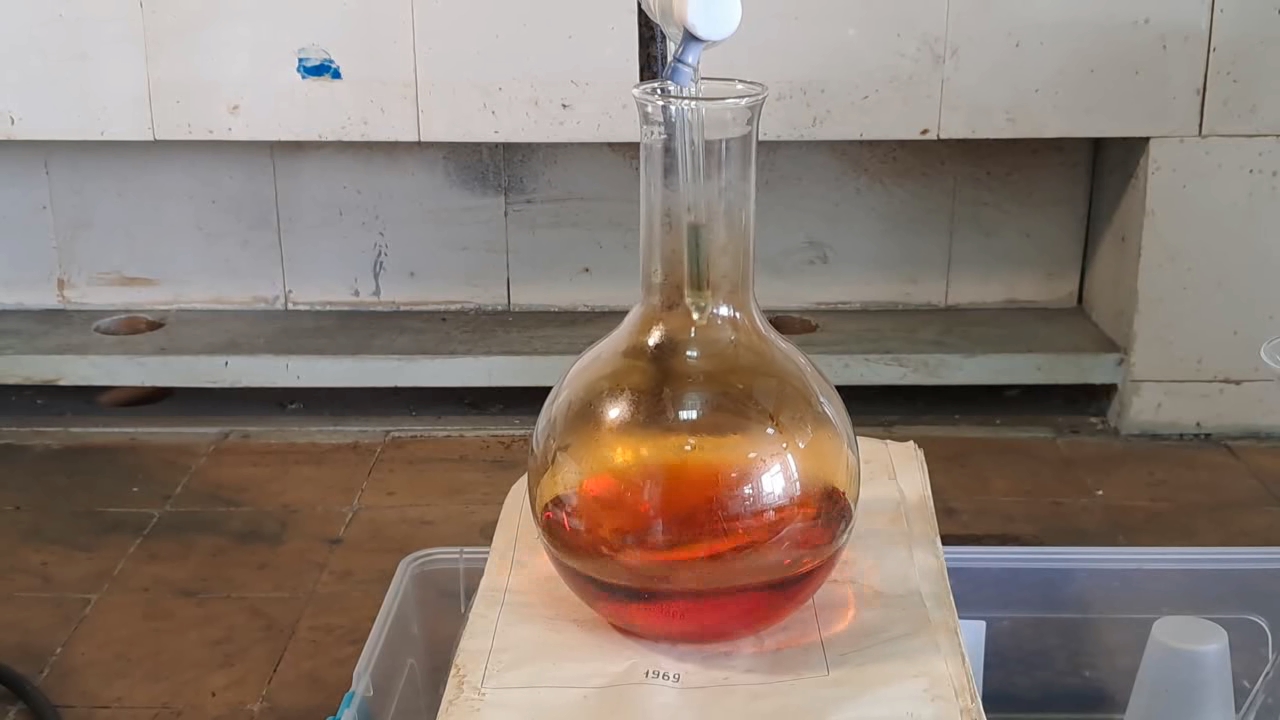
|

|
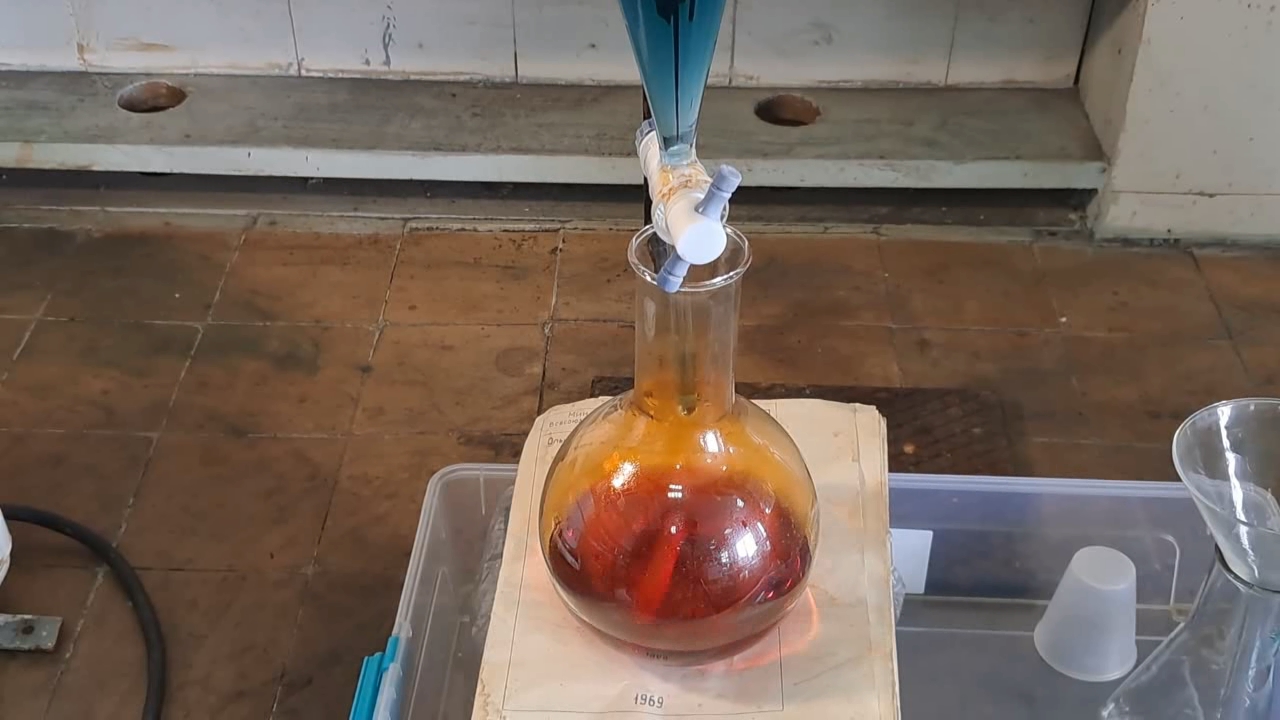
|
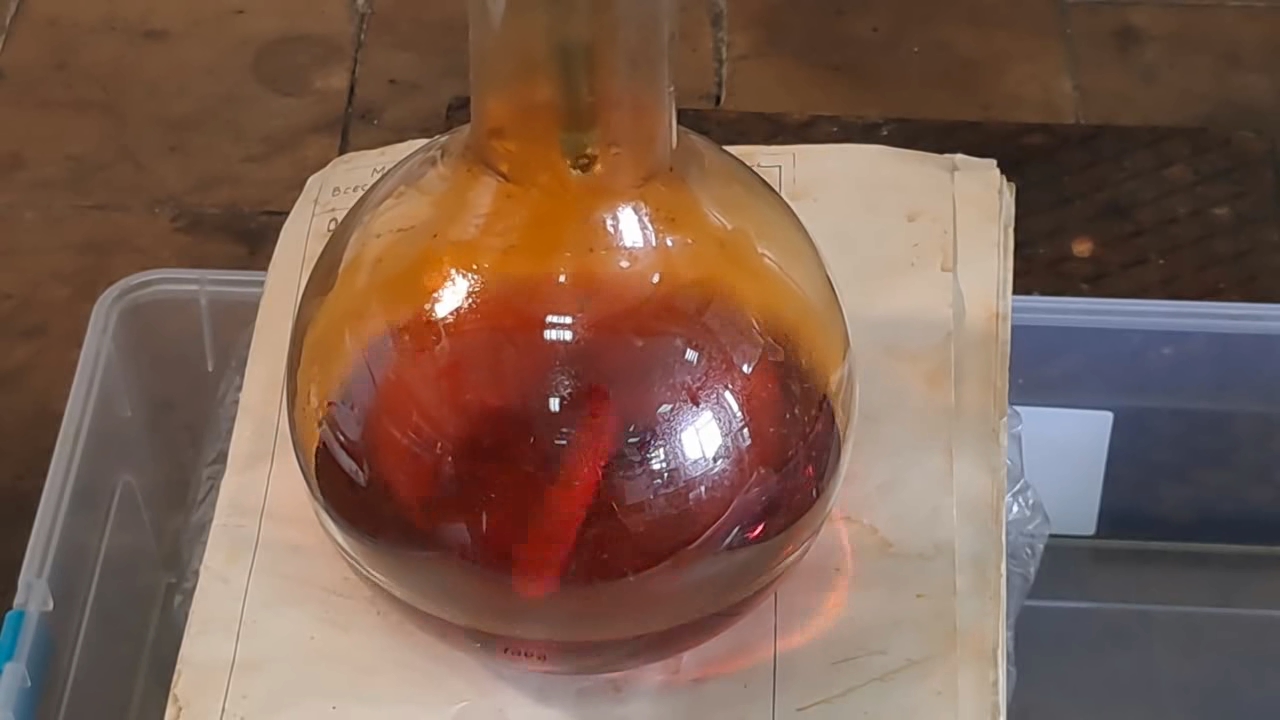
|
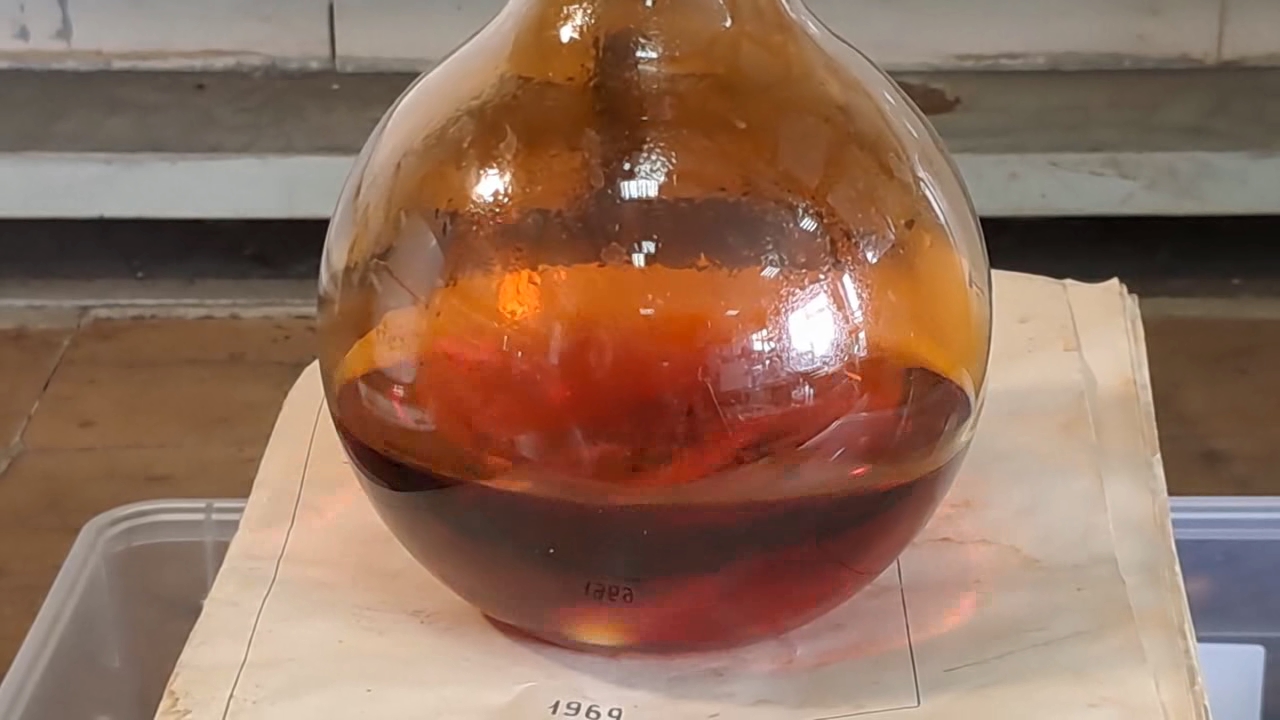
|
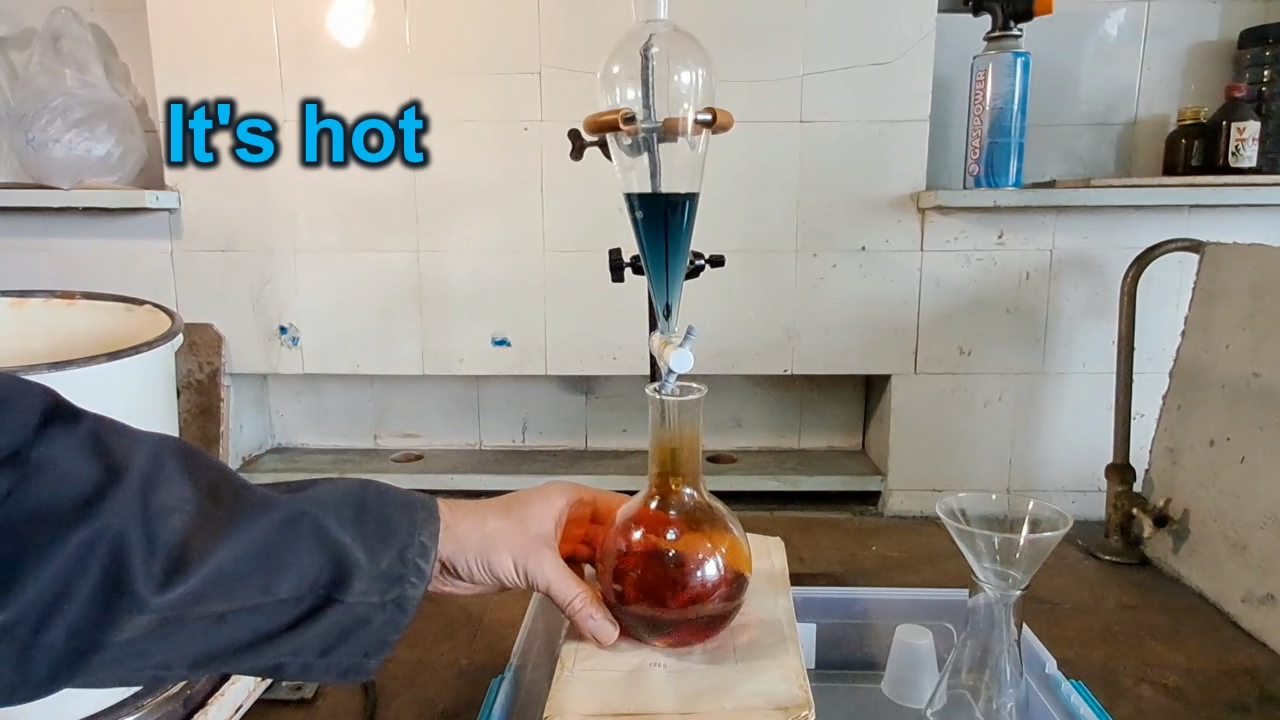
|
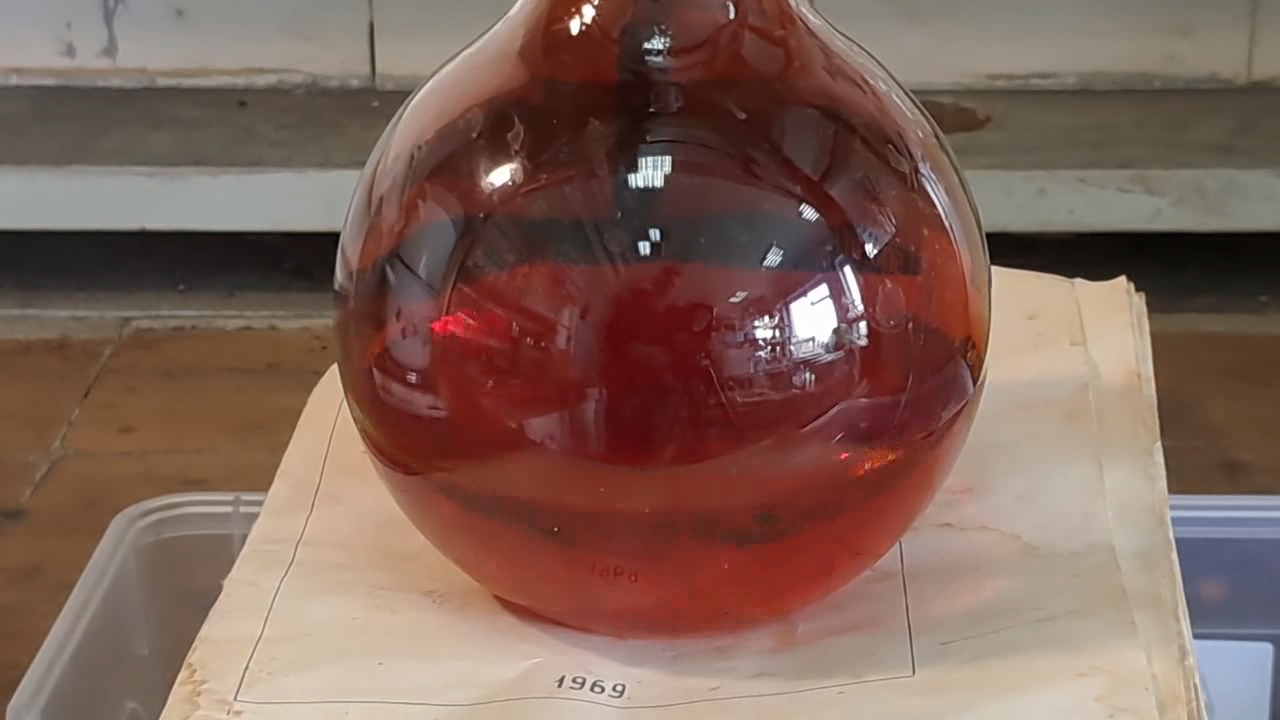
|
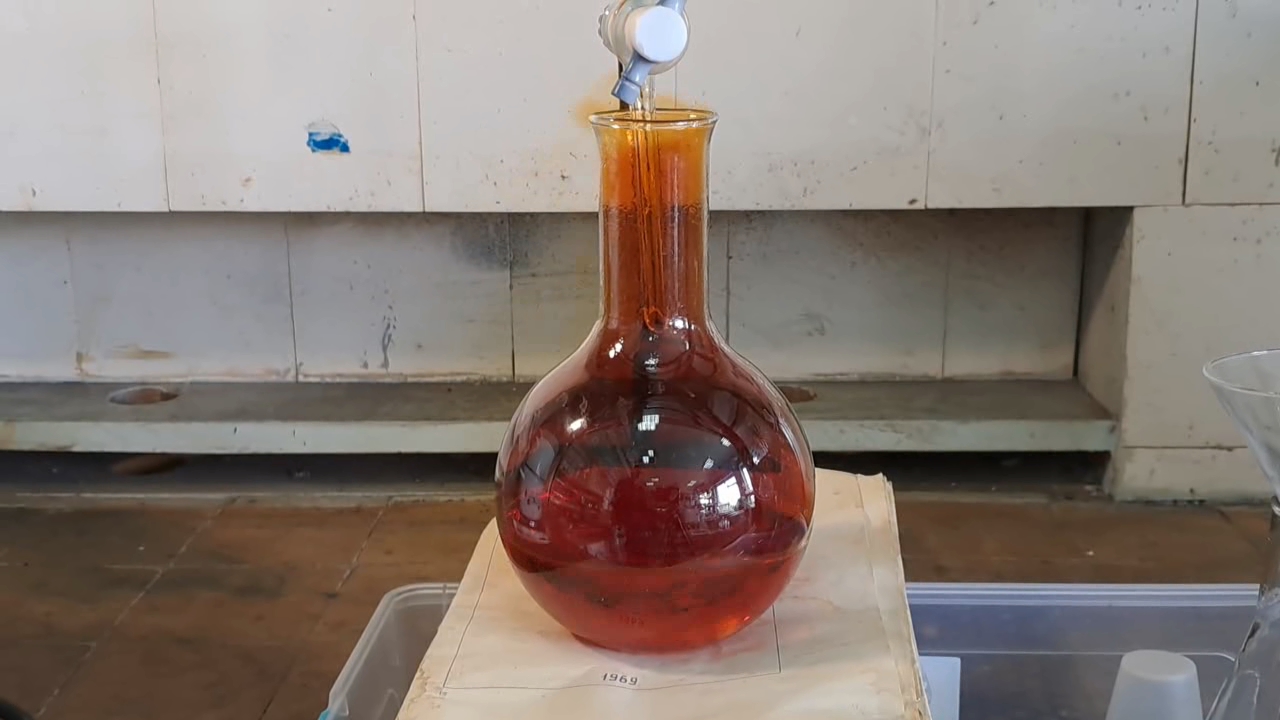
|
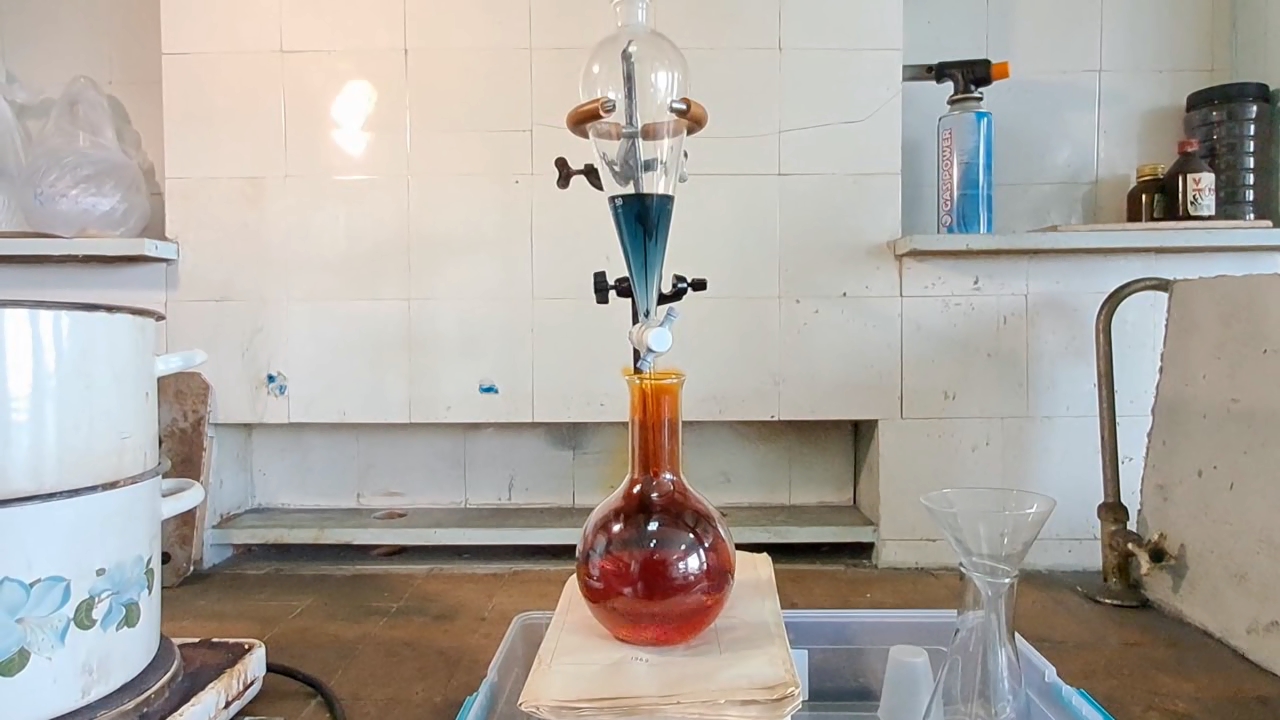
|
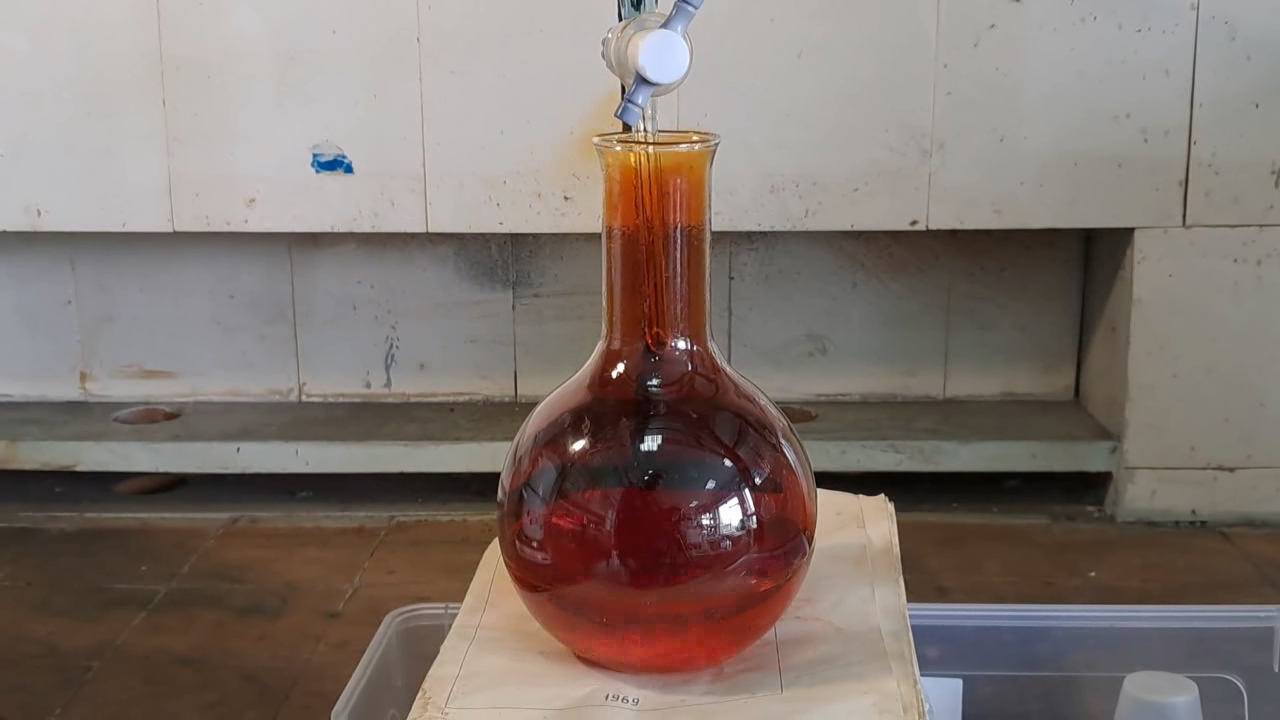
|
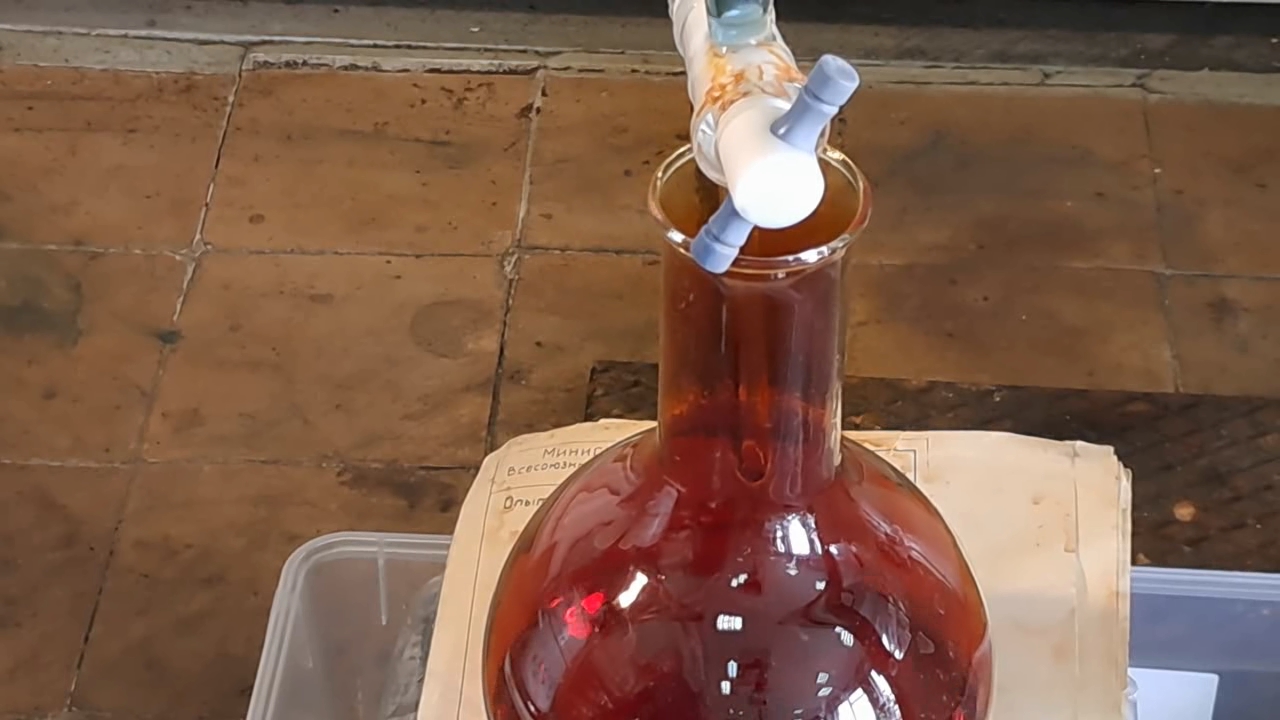
|

|
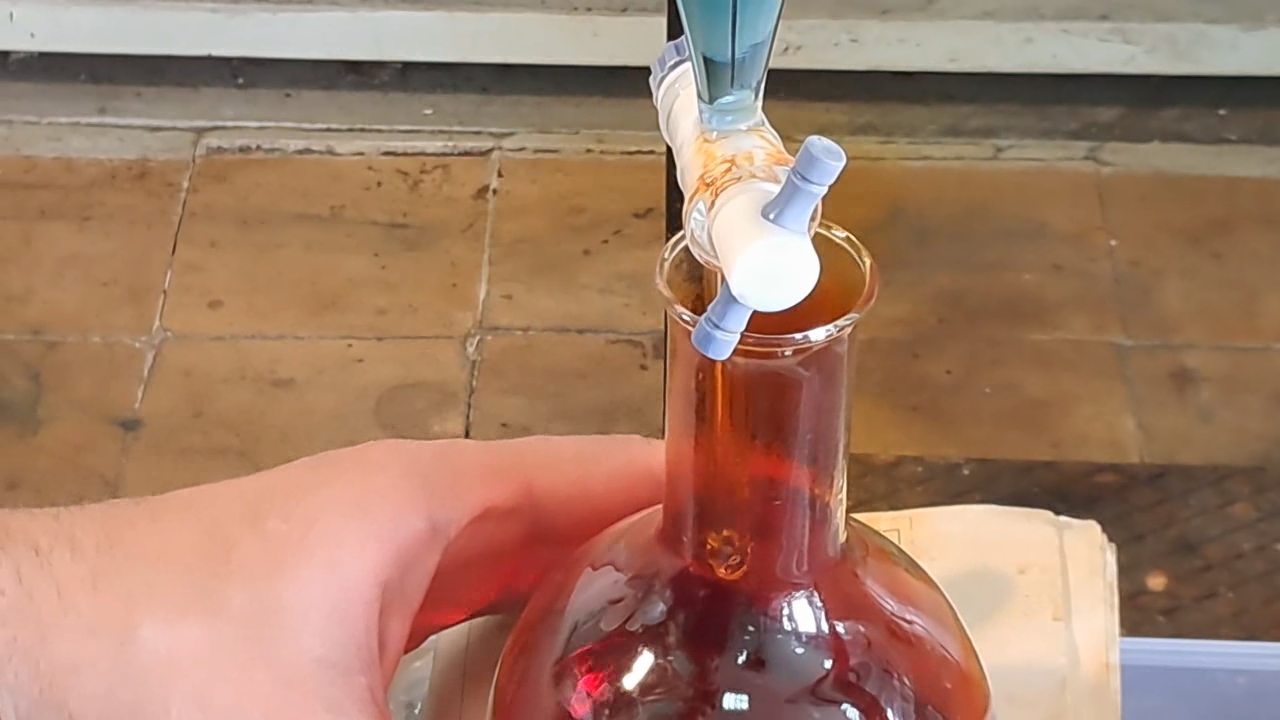
|
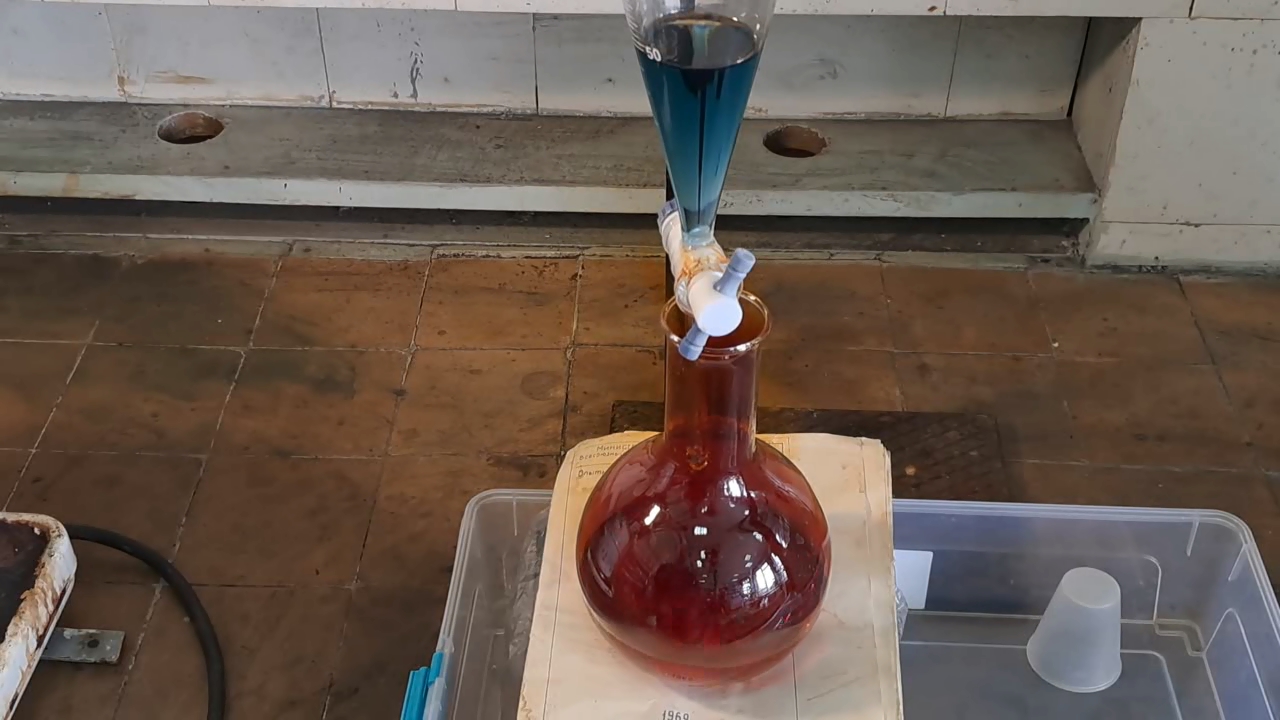
|
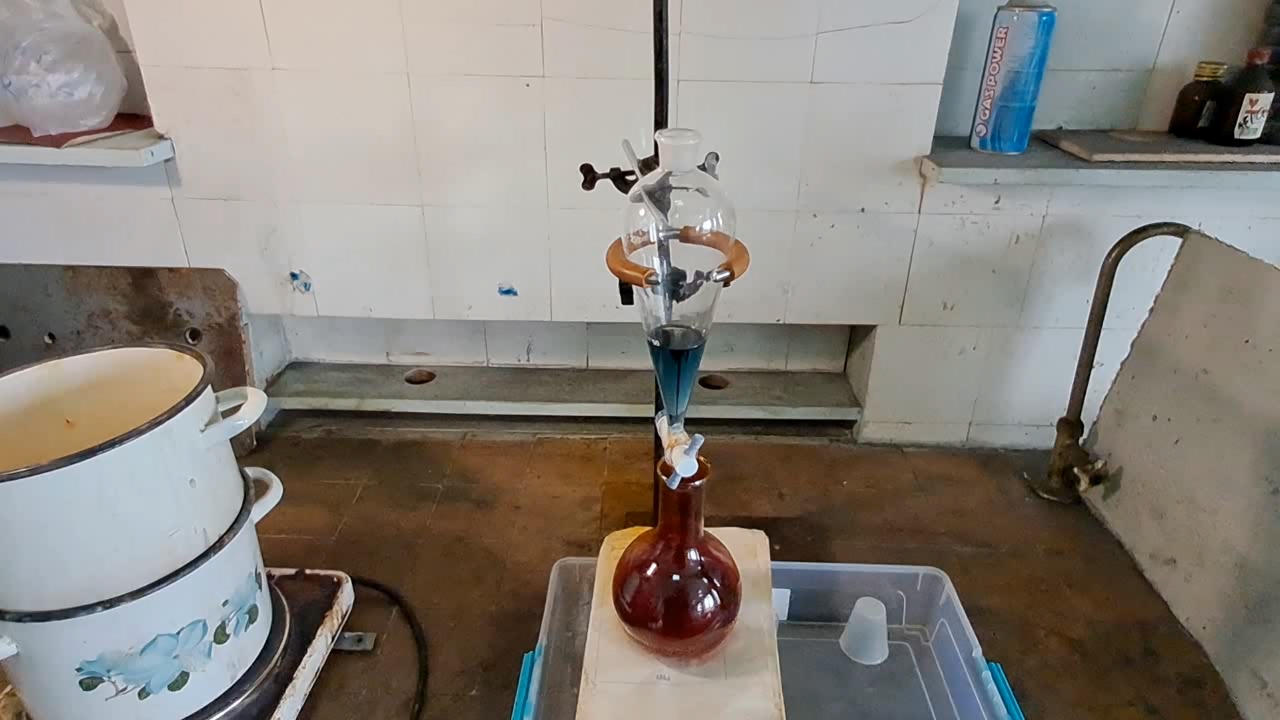
|
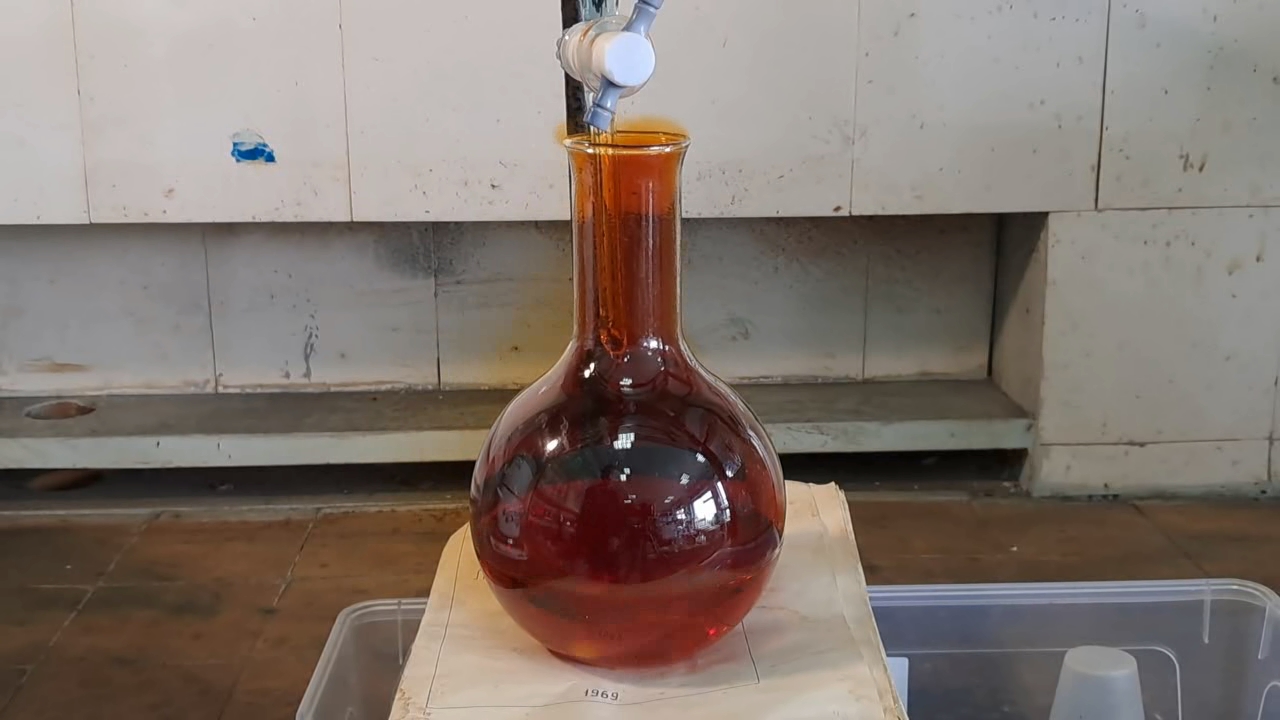
|
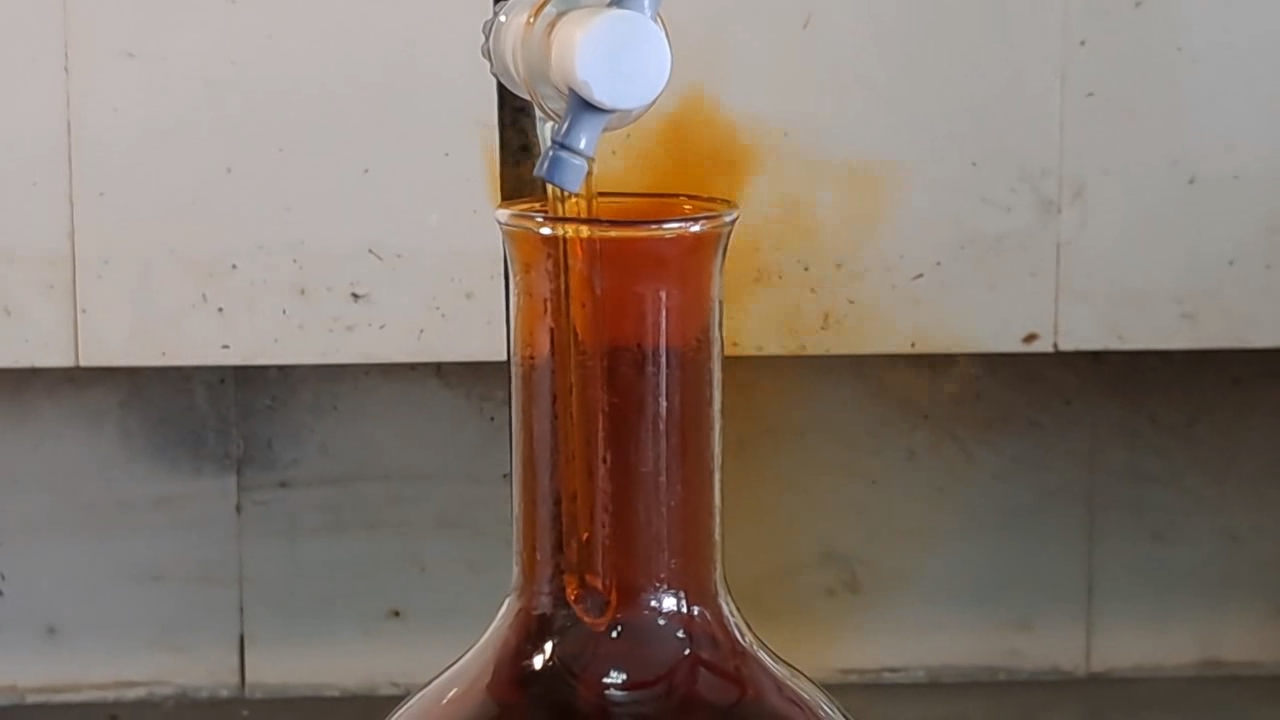
|
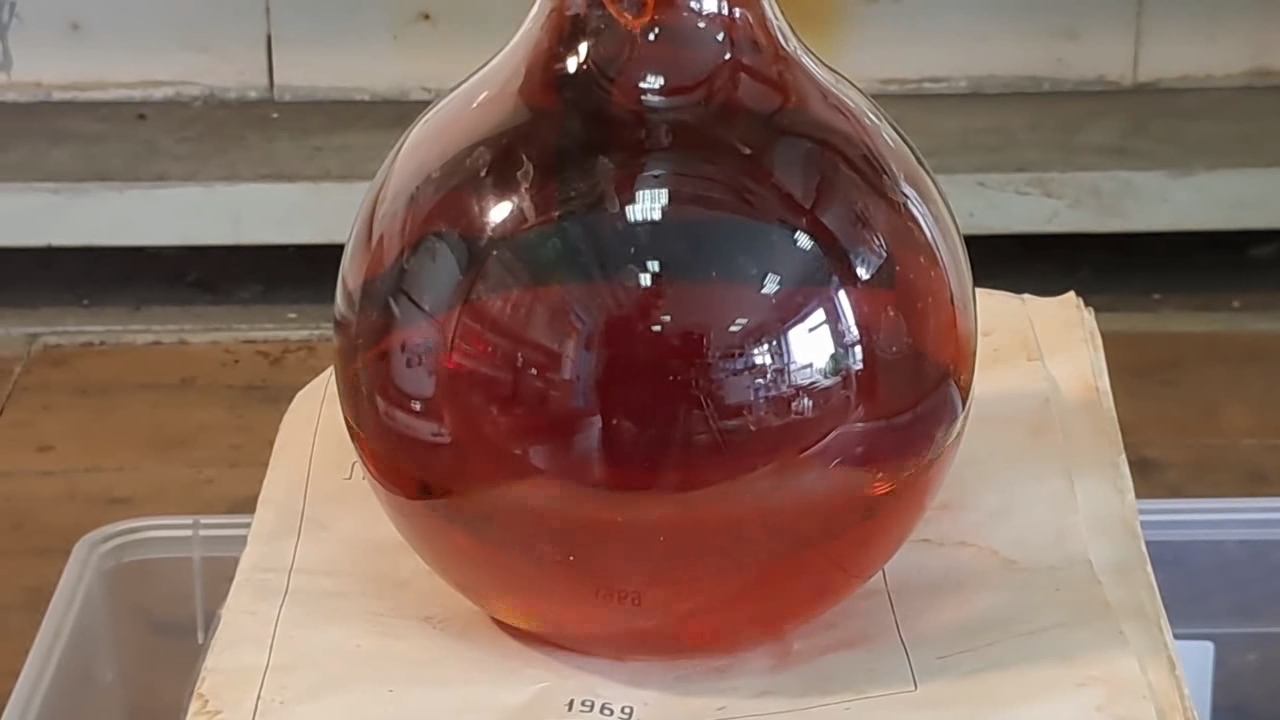
|
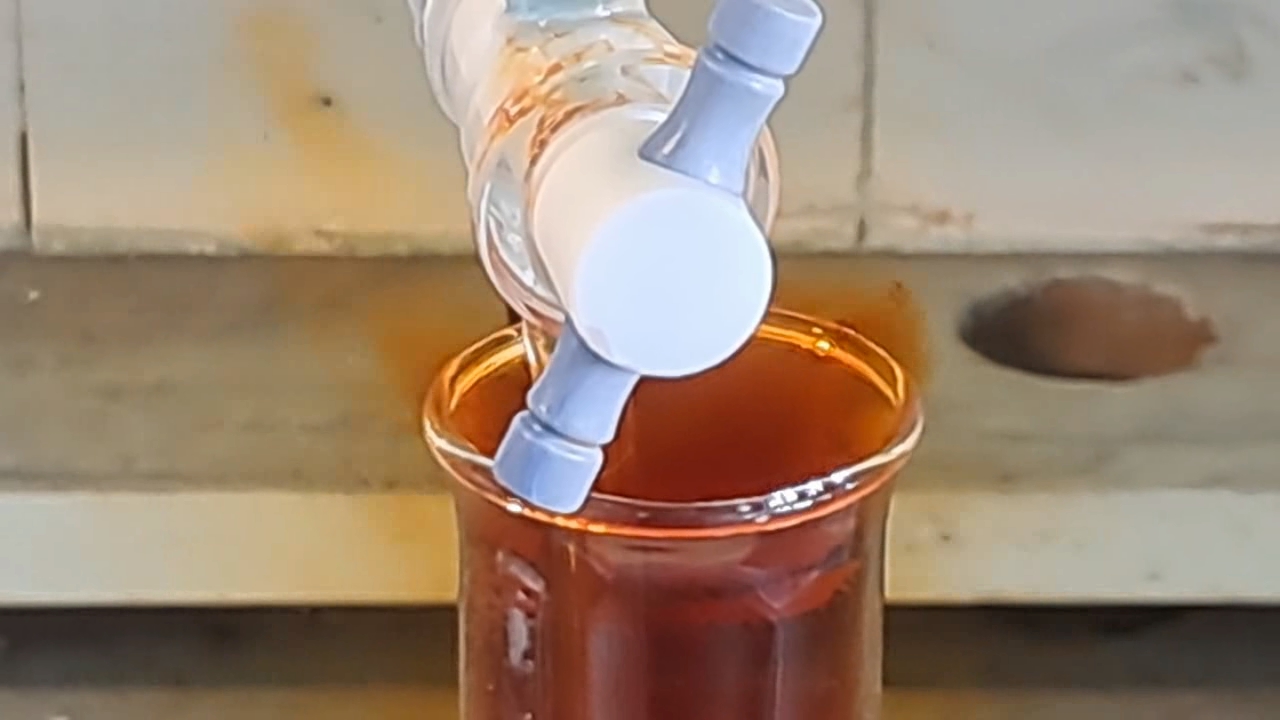
|
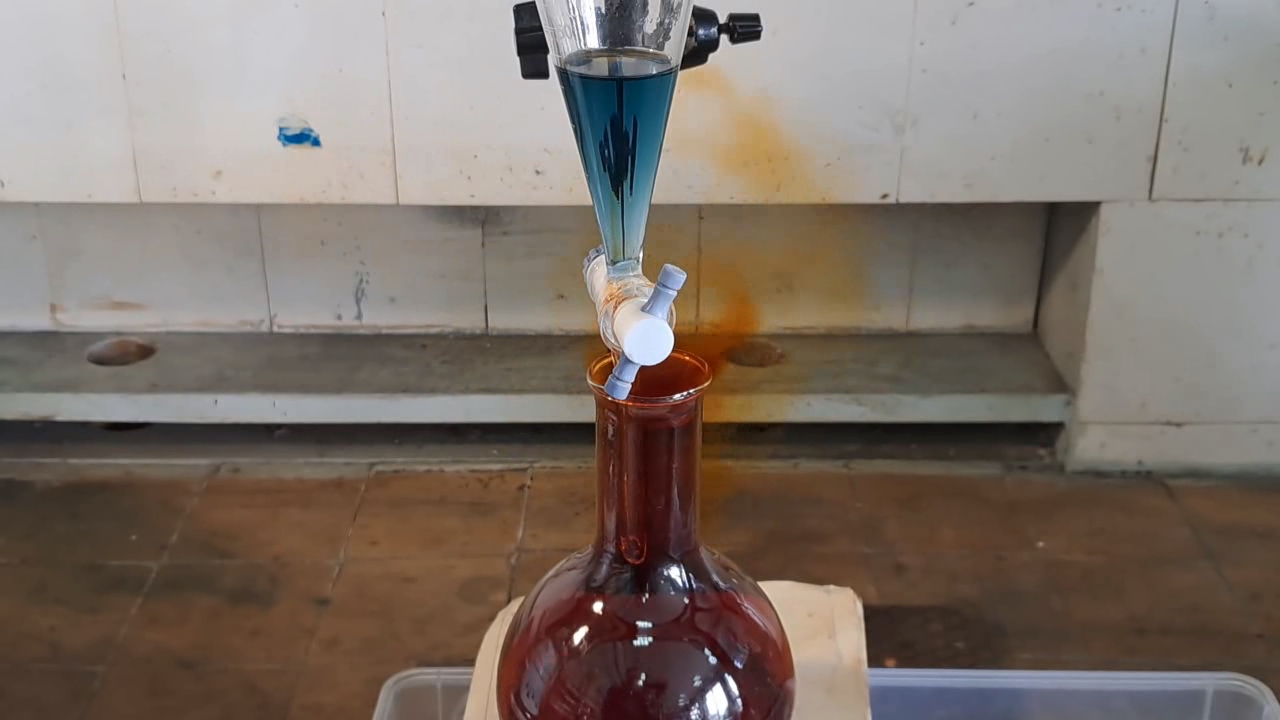
|
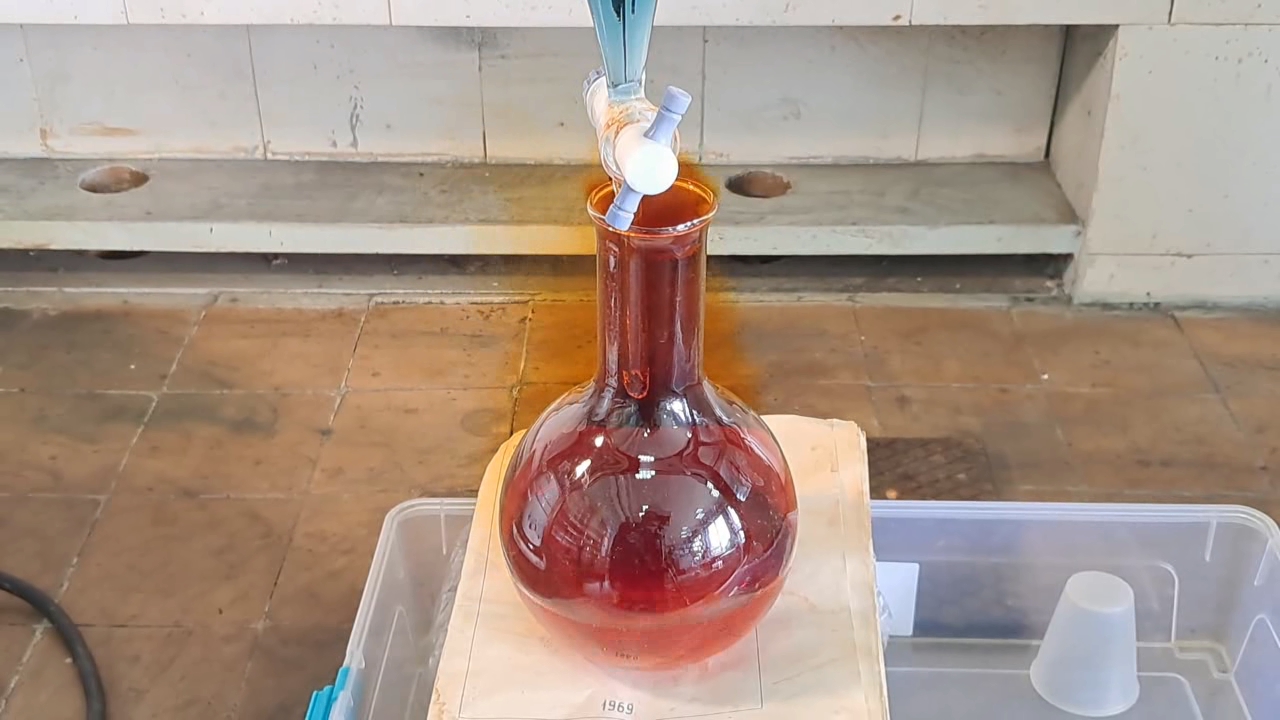
|
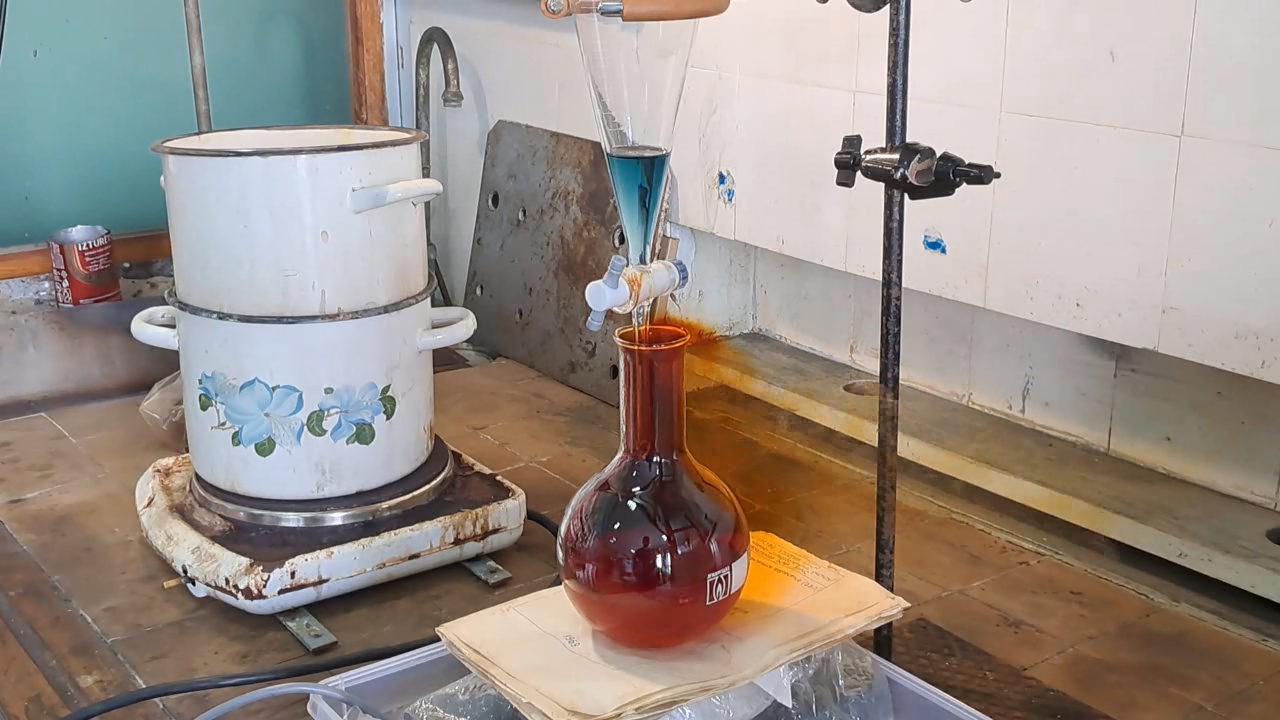
|
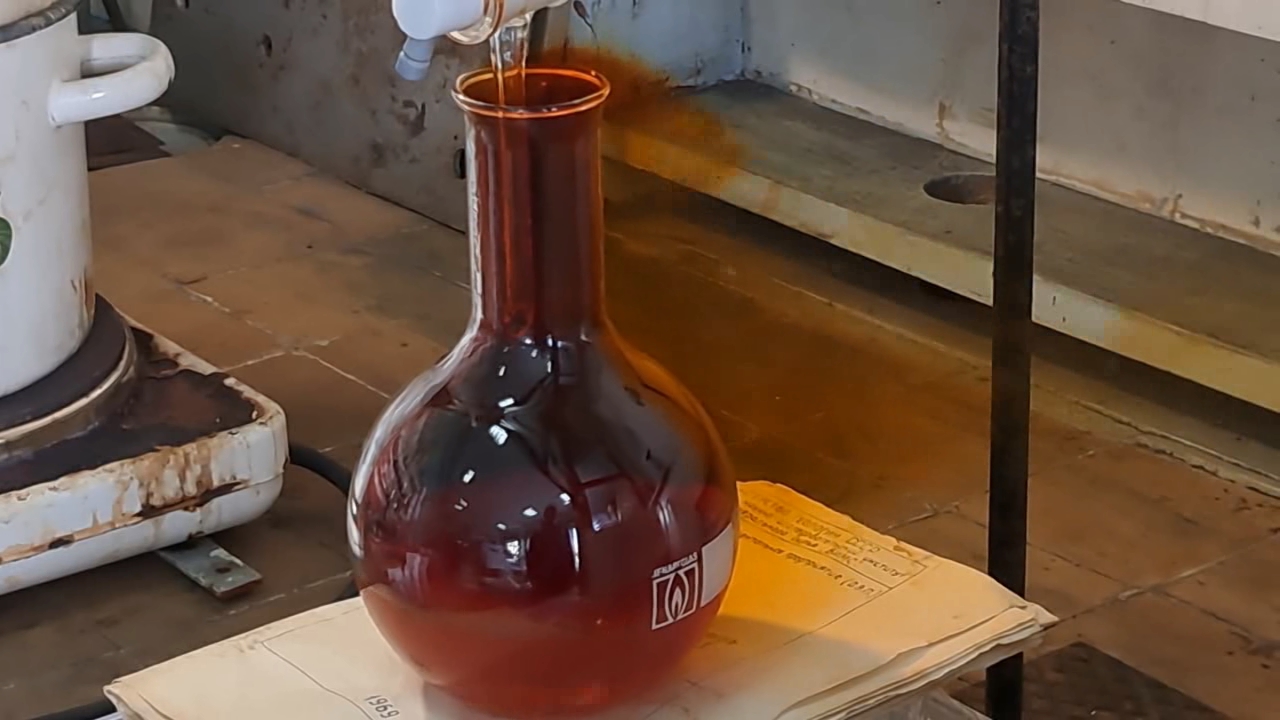
|
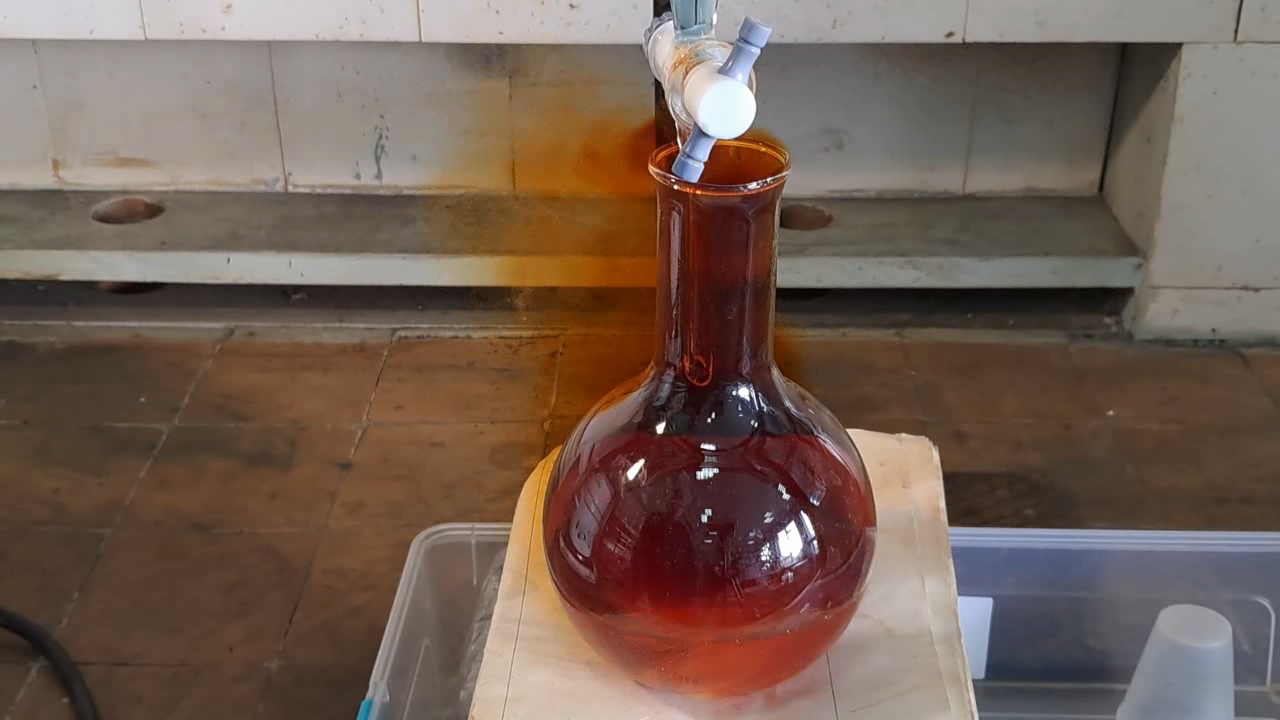
|
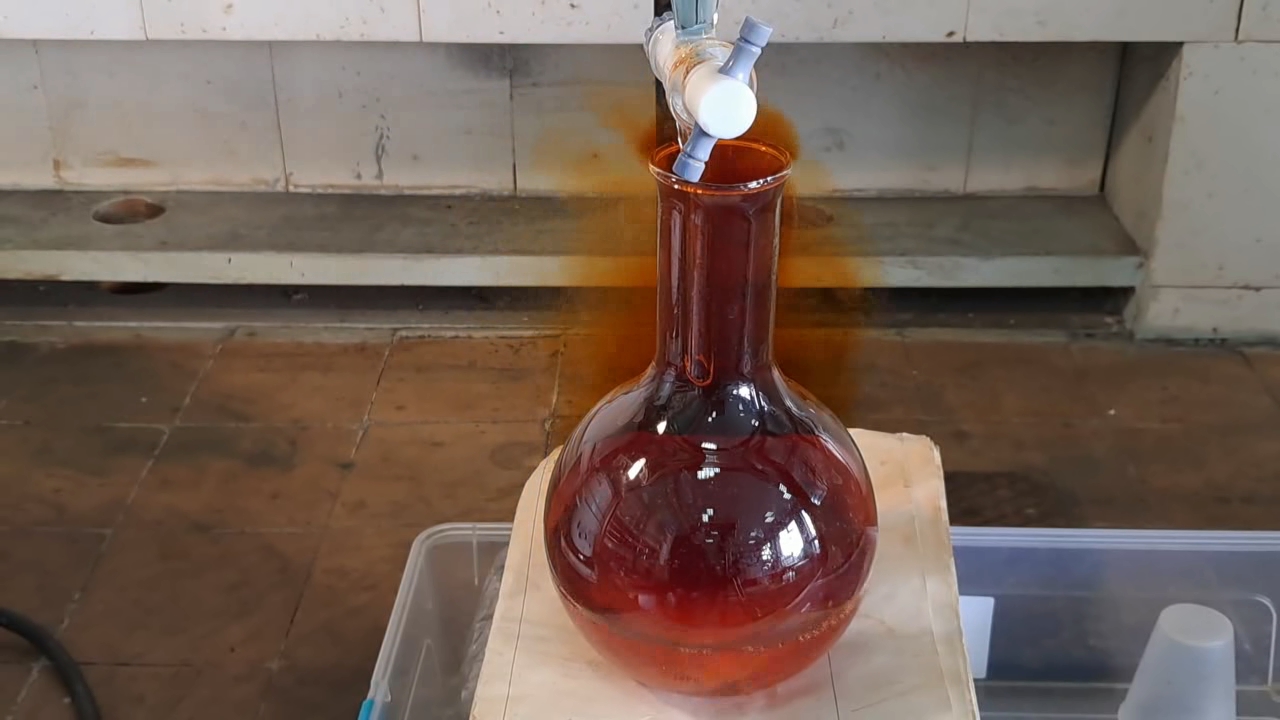
|
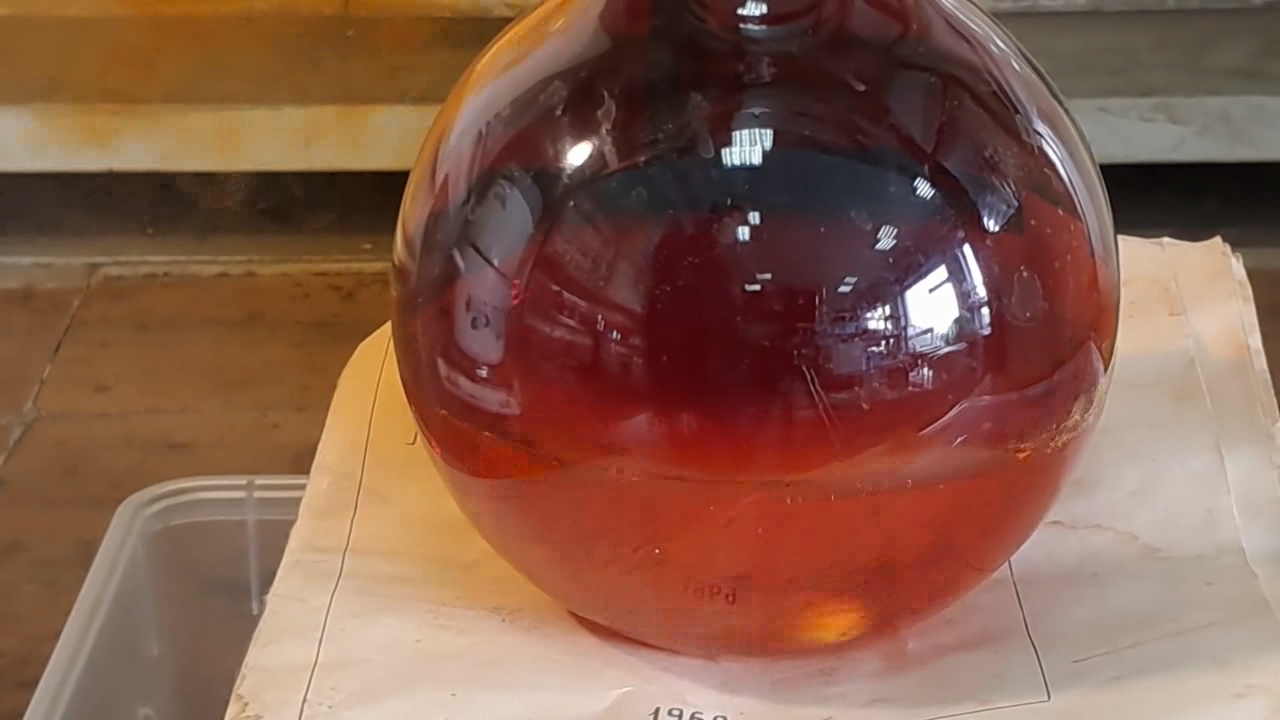
|
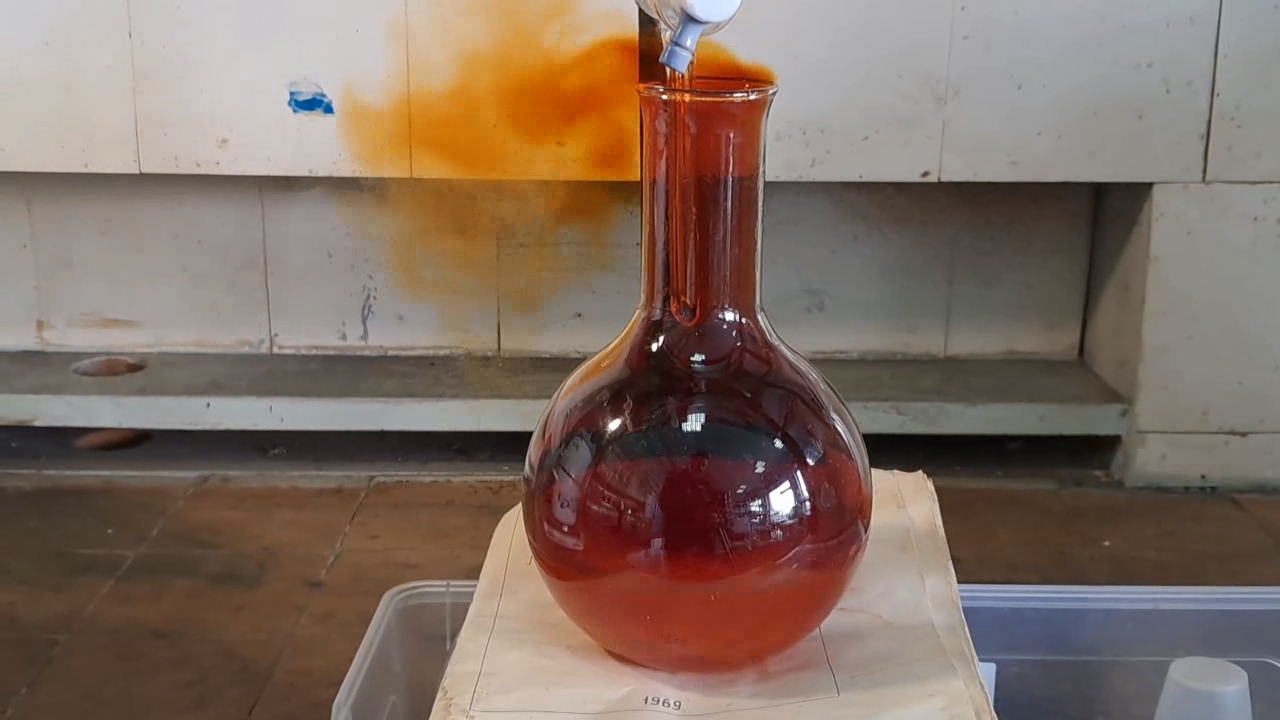
|
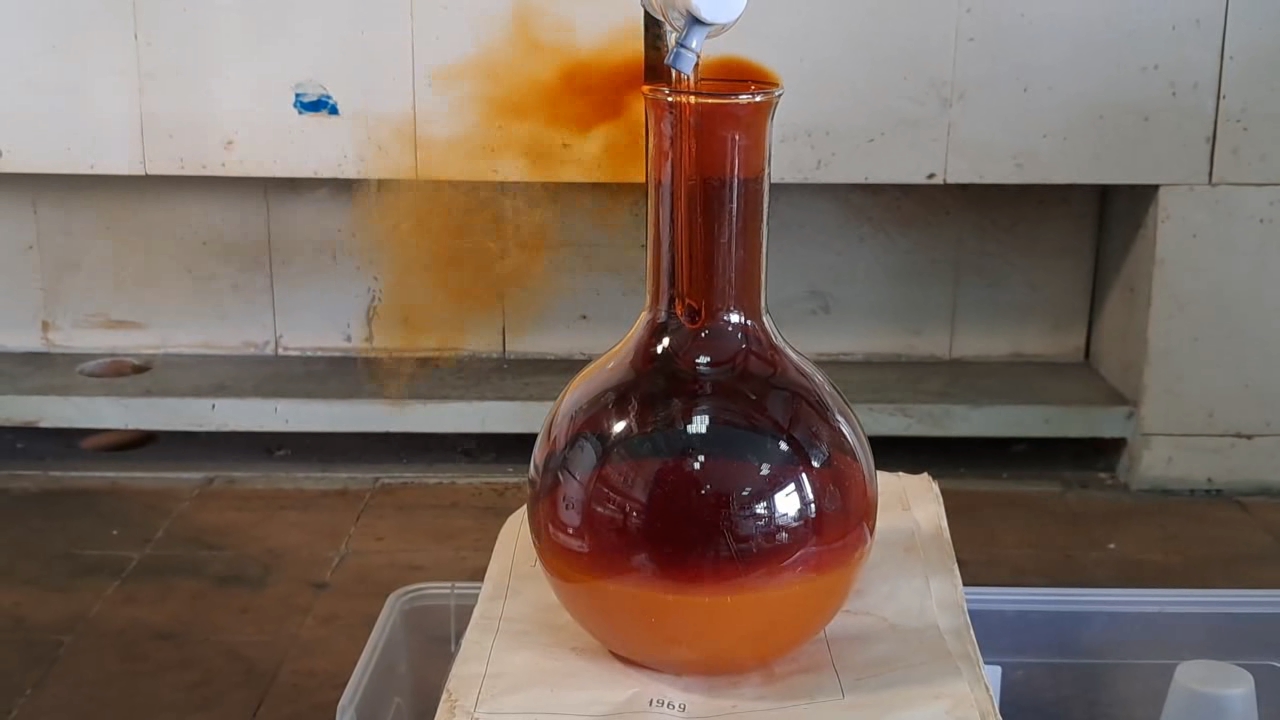
|
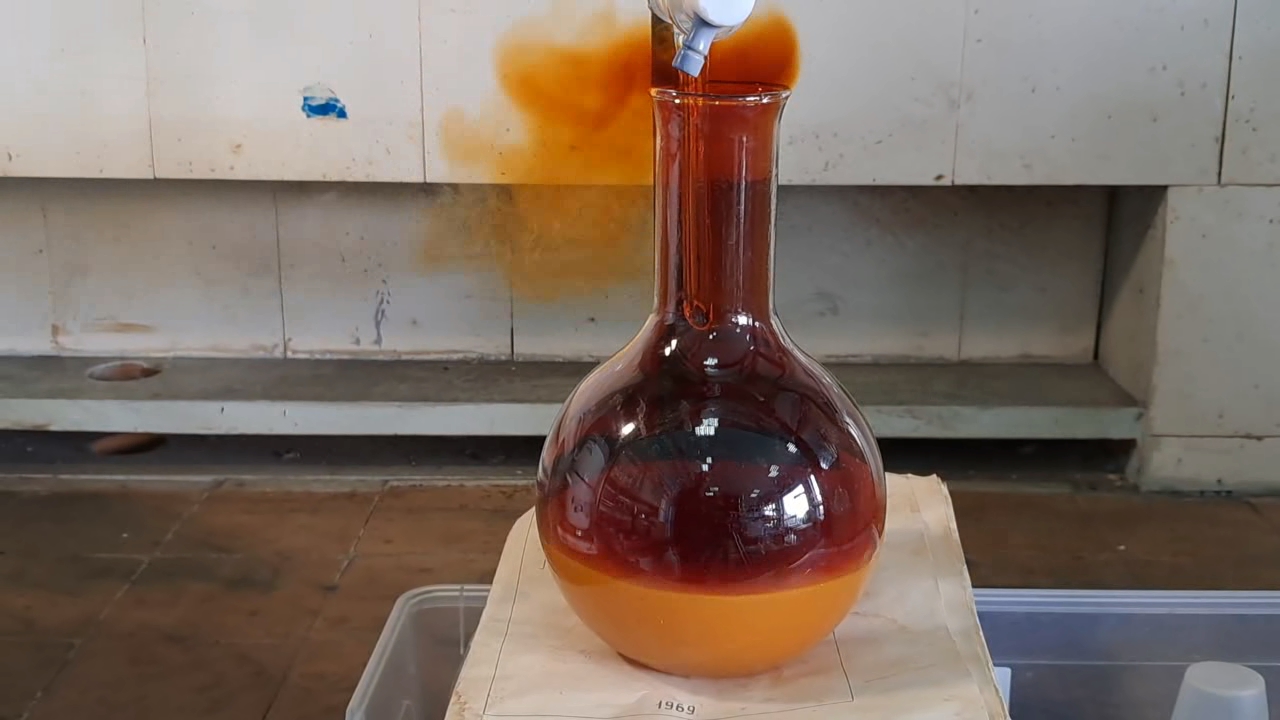
|
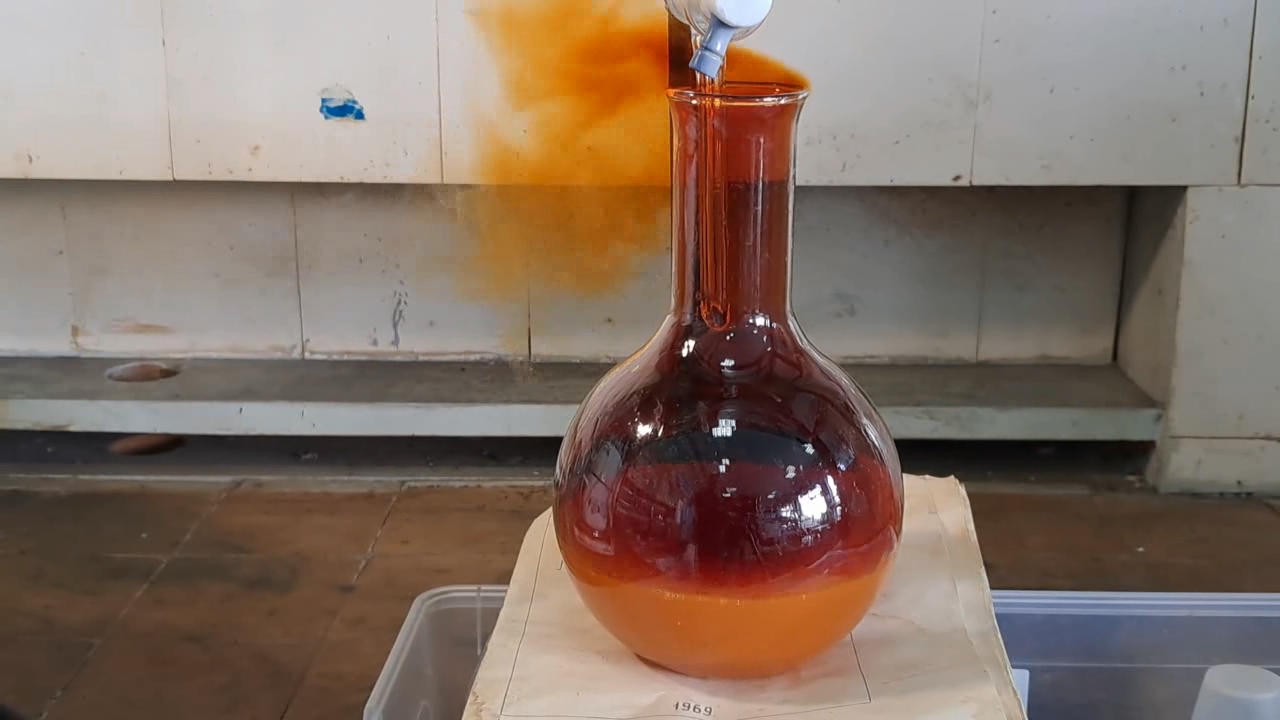
|
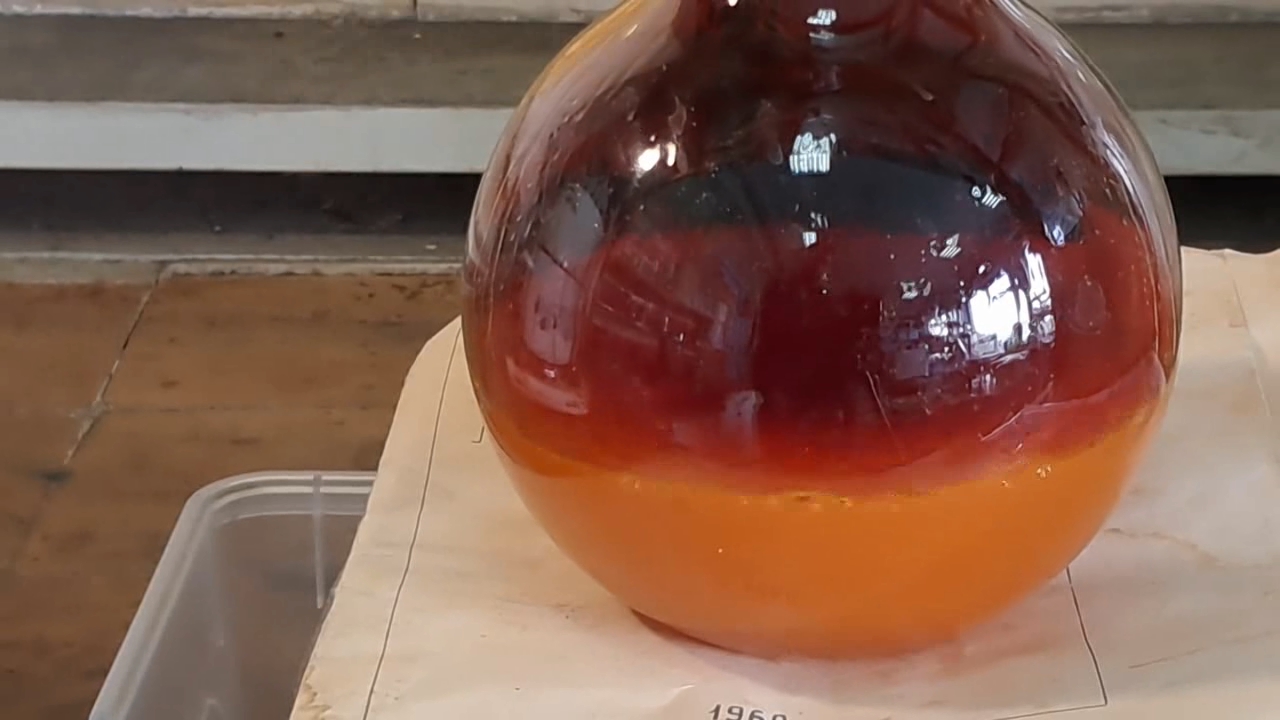
|
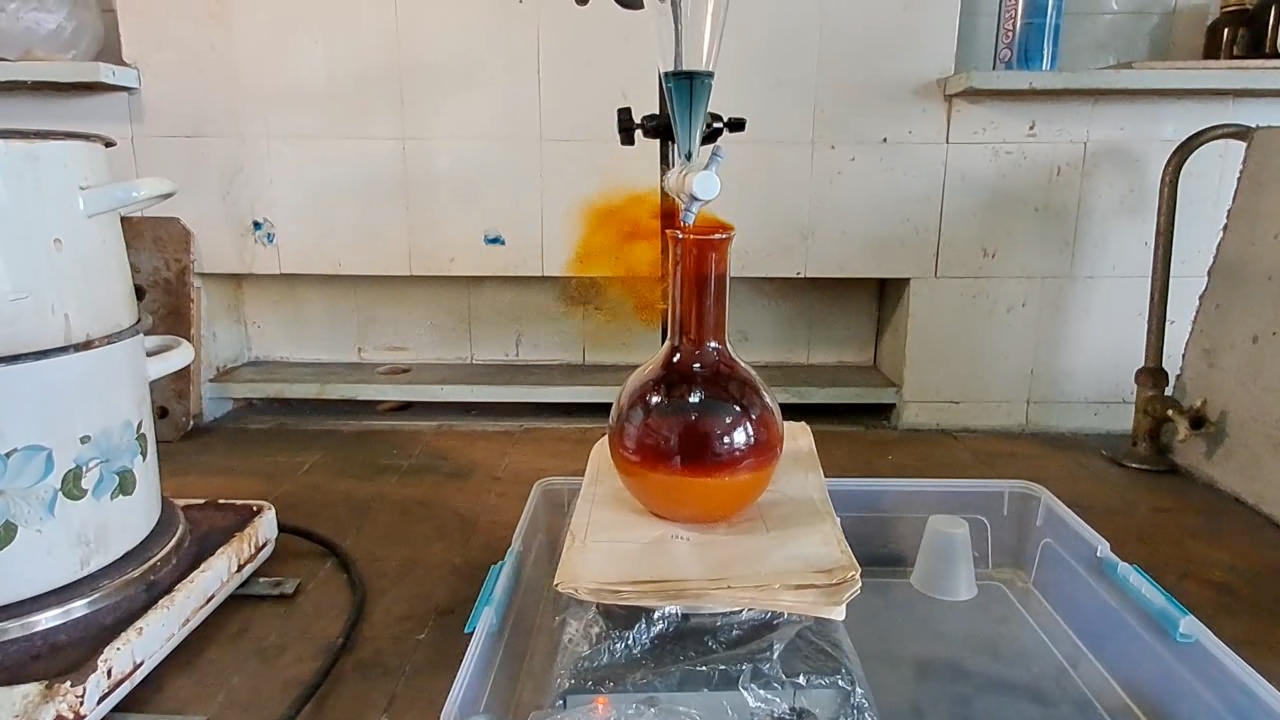
|
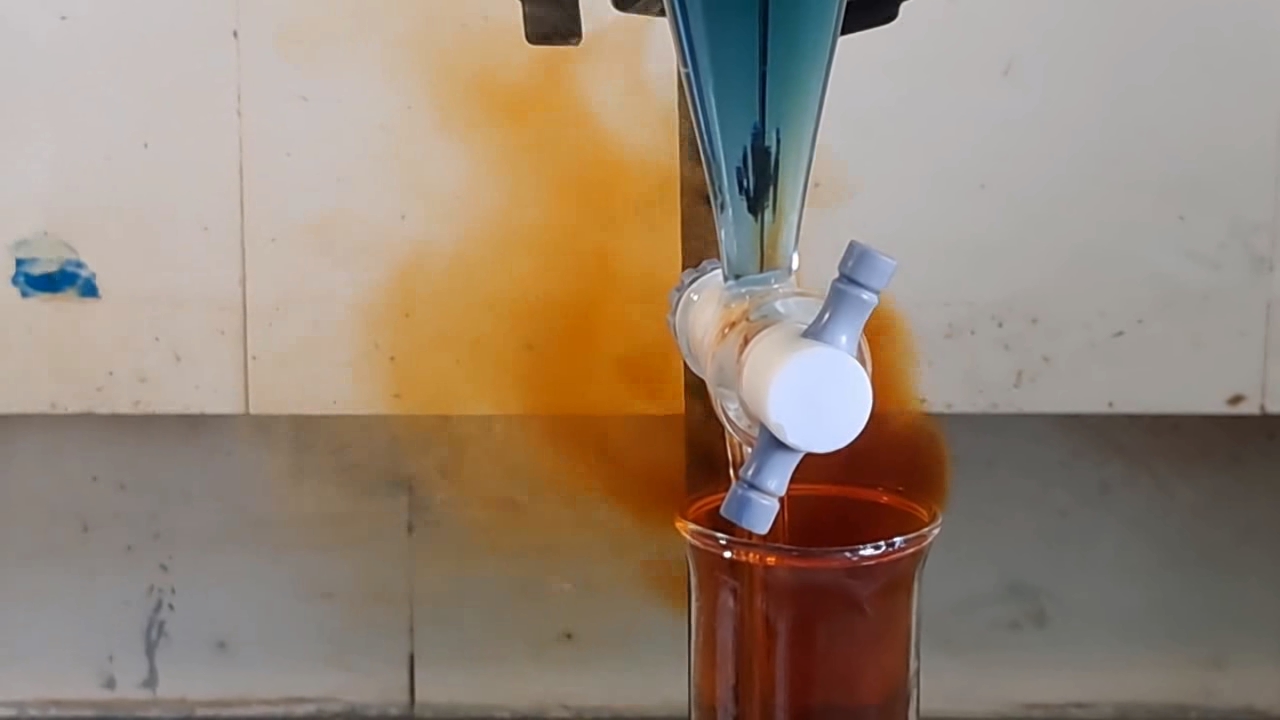
|
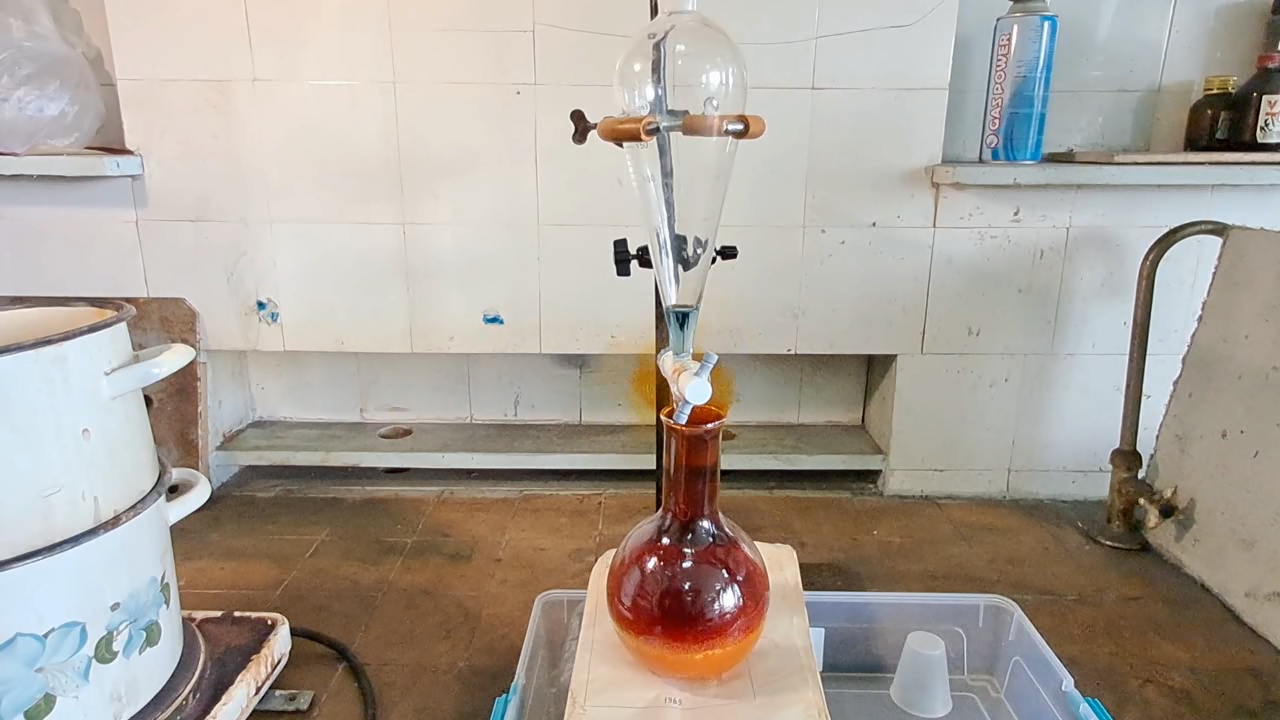
|
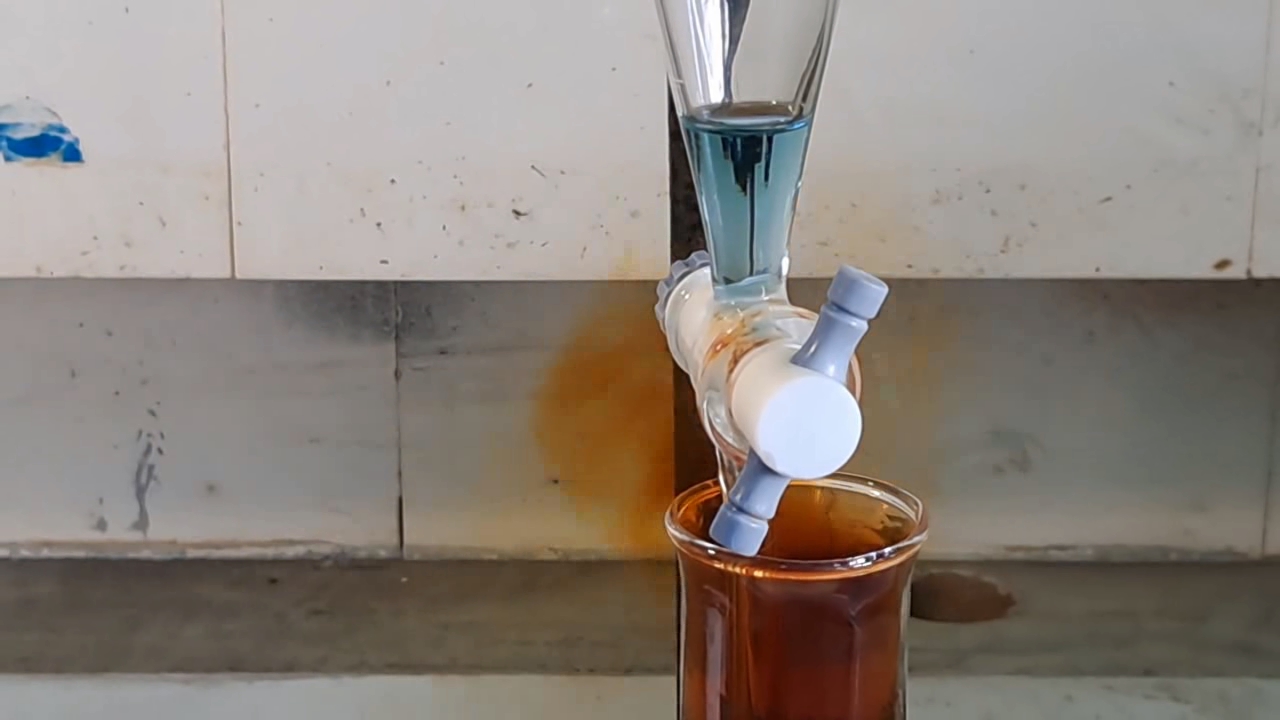
|
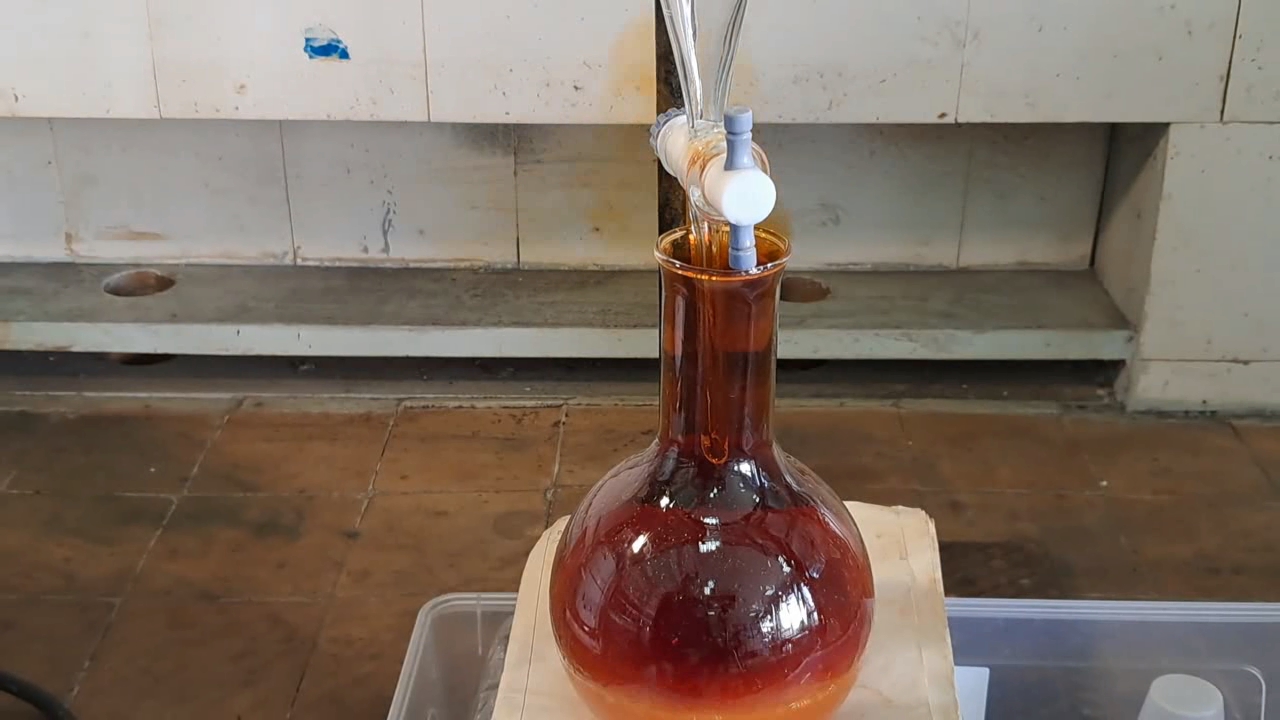
|
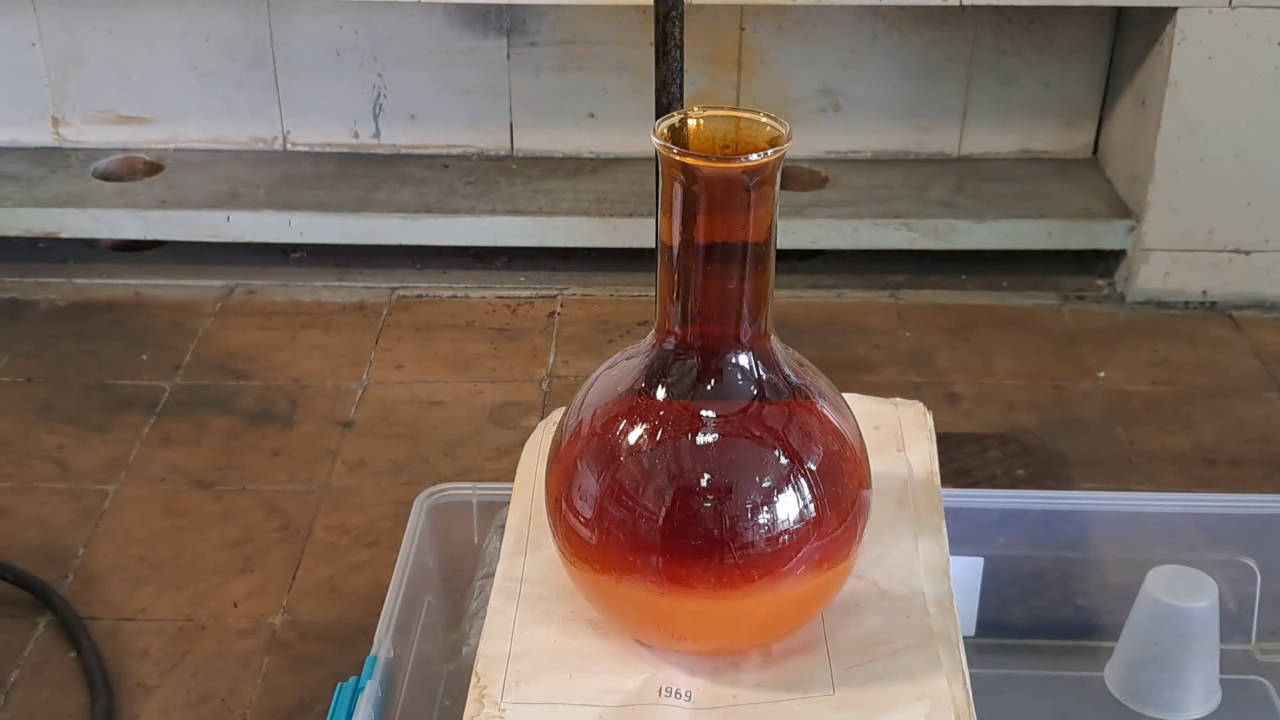
|
|
Having noticed a mistake in the text, allocate it and press Ctrl-Enter
Nitration of Phenol: Synthesis of Picric Acid (continuation) - Part 7
I transferred the flask to a boiling water bath and stirred it occasionally. If the heating function of the magnetic stirrer had been working, the entire synthesis could have been carried out without a water bath.
Нитрование фенола: синтез пикриновой кислоты (продолжение) - Часть 7 A pot of water on a hotplate served as my water bath, and I had to "serve" as the stirrer myself - periodically agitating the contents of the flask by hand. The water boiled steadily while brown gas continued to escape vigorously from the flask. The thermometer inserted into the flask showed slightly below 100°C (7°C must be added to the thermometer readings in the photo and video because part of the alcohol column had separated and collected at the top). Gradually, the release of brown gas weakened, and picric acid began floating to the surface. I then transferred the flask from the water bath to a sand bath and continued stirring the mixture periodically with the thermometer. But an unpleasant surprise followed. The melting point of picric acid is 121-122°C, and the thermometer in the flask read 109°C (after correction). Although this was well below the melting point, the picric acid inside the flask began to fuse into lumps. At the same time, the release of brown gas intensified rather than diminished. Had oxidative decomposition begun? I immediately removed the flask from the sand bath. Later, a colleague who had synthesized picric acid on a large scale told me that the reaction mixture should never be heated above 100°C; otherwise, the picric acid forms lumps, which are very difficult to wash. Unfortunately, I did not know this during the synthesis. I poured the reaction mixture into a beaker containing 600 ml of distilled water. I rinsed the flask and added the washings to the same beaker, stirring the contents thoroughly. Then came the second surprise - this time a pleasant one. Picric acid crystals sparkled in the solution like tiny particles of gold! This reminded me of the well-known chemical demonstration called *"golden rain."* In that experiment, a solution of potassium iodide is added dropwise to a hot solution of a lead salt, producing large yellow crystals of lead iodide that glitter as they slowly settle. Picric acid crystals, it turns out, behave in a similar way. Lead iodide plates are more striking - especially in direct sunlight - but the picric acid was still beautiful. Afterward, I recalled that one of my colleagues had also observed this effect with picric acid. A word of caution for readers: if you try to look up the "golden rain" experiment online, be aware that in some languages search engines may return highly unpleasant results unrelated to chemistry. Sadly, the world has never been perfect. |
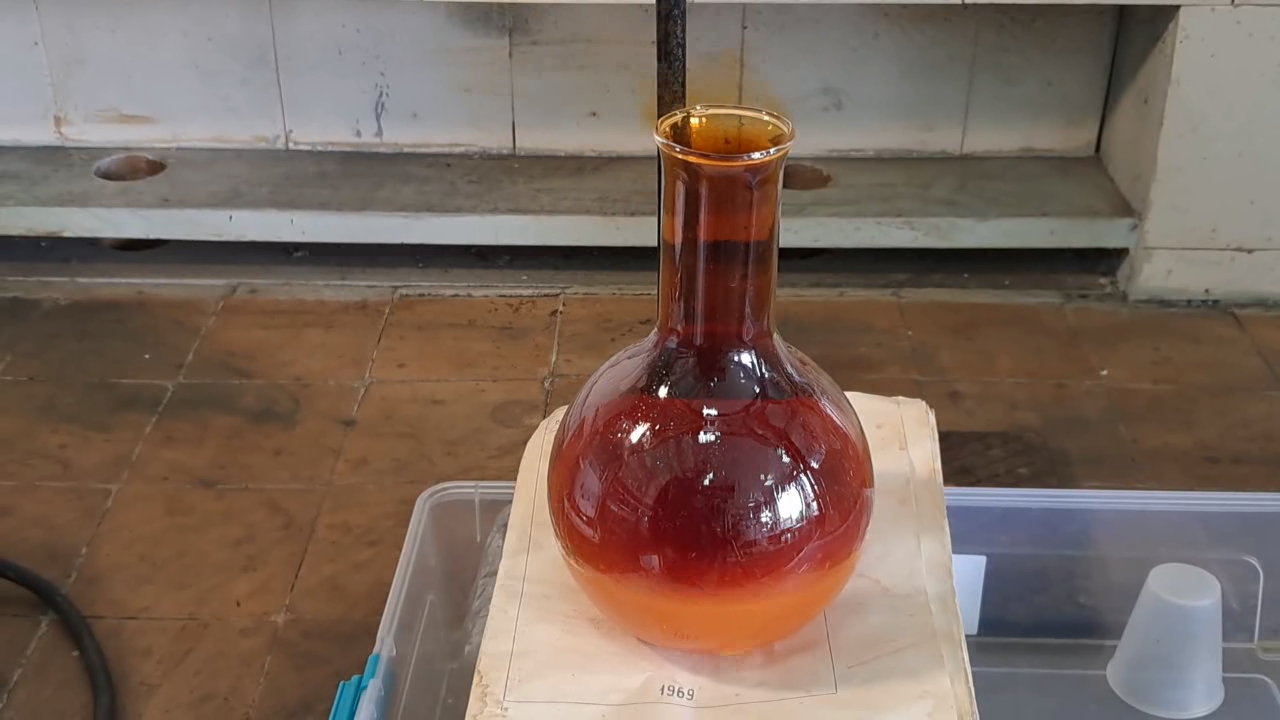
Nitration of Phenol: Synthesis of Picric Acid |
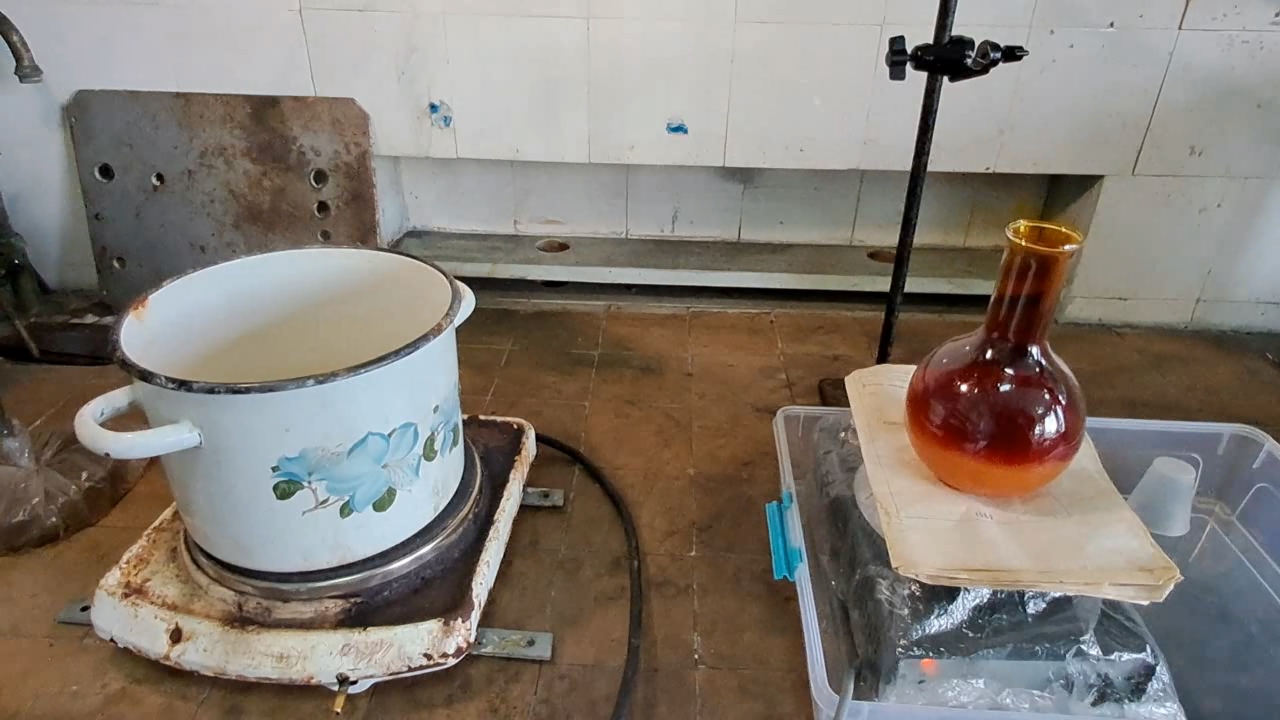
|
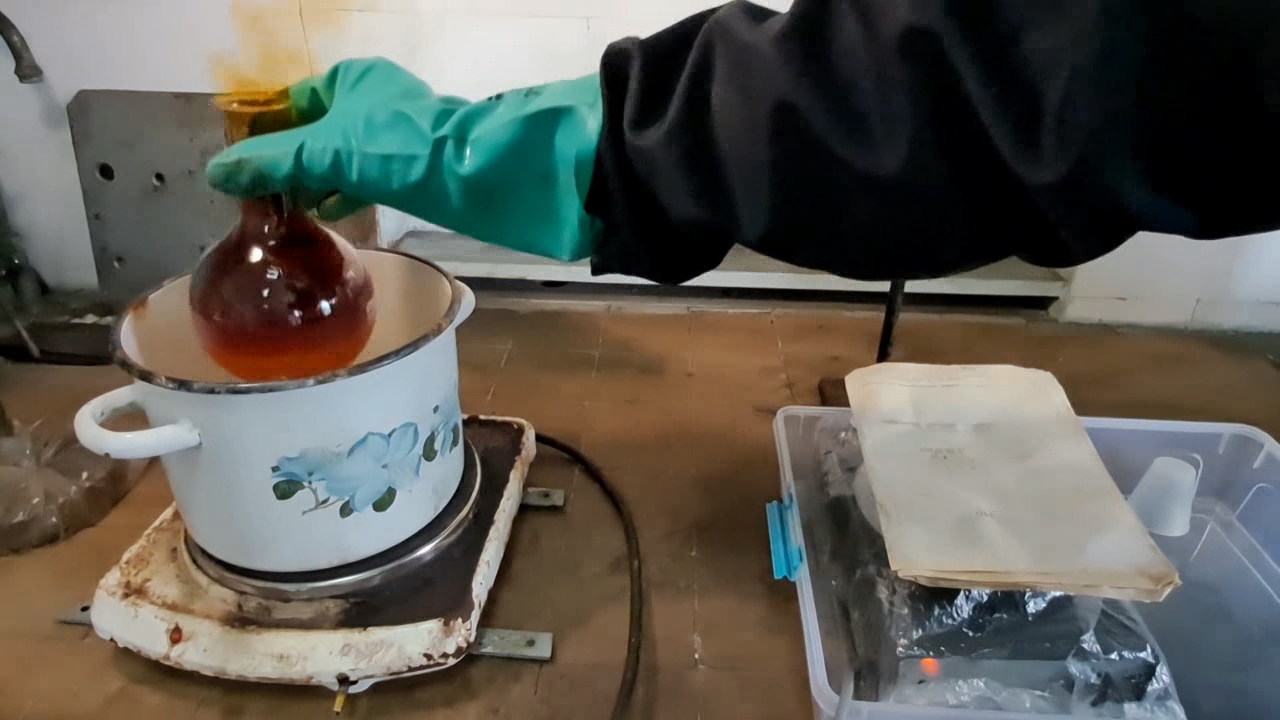
|
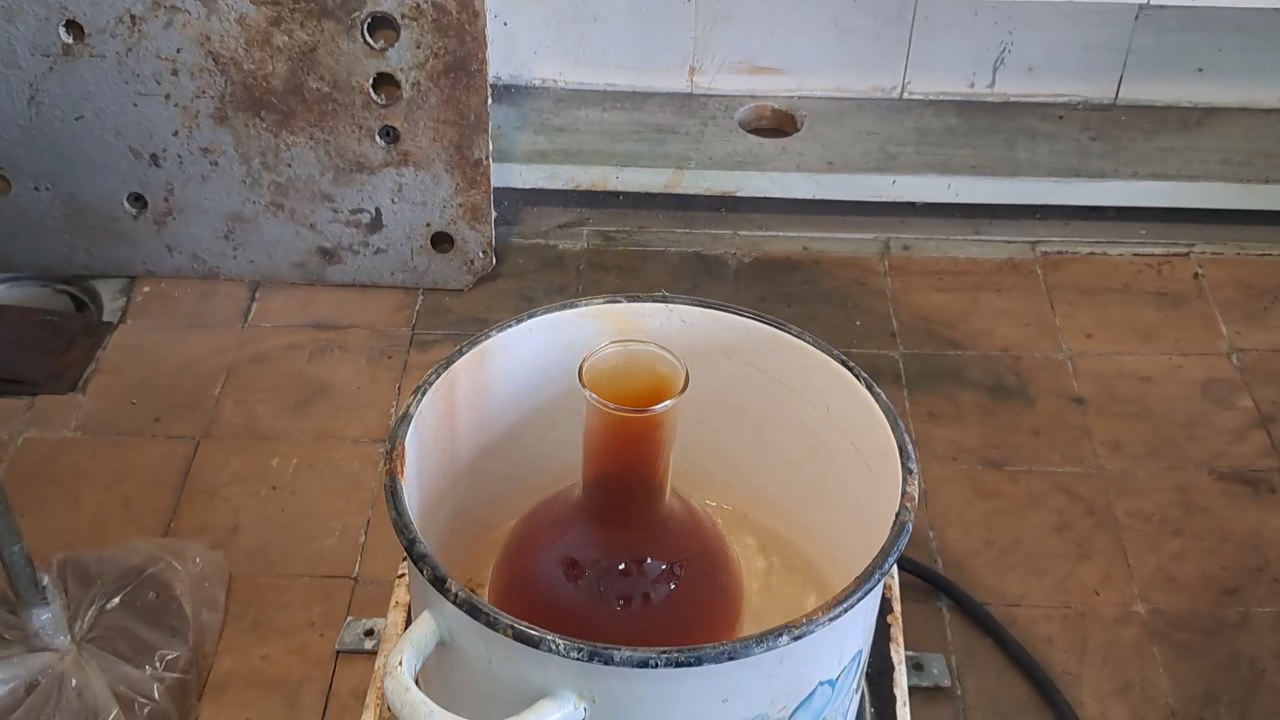
|
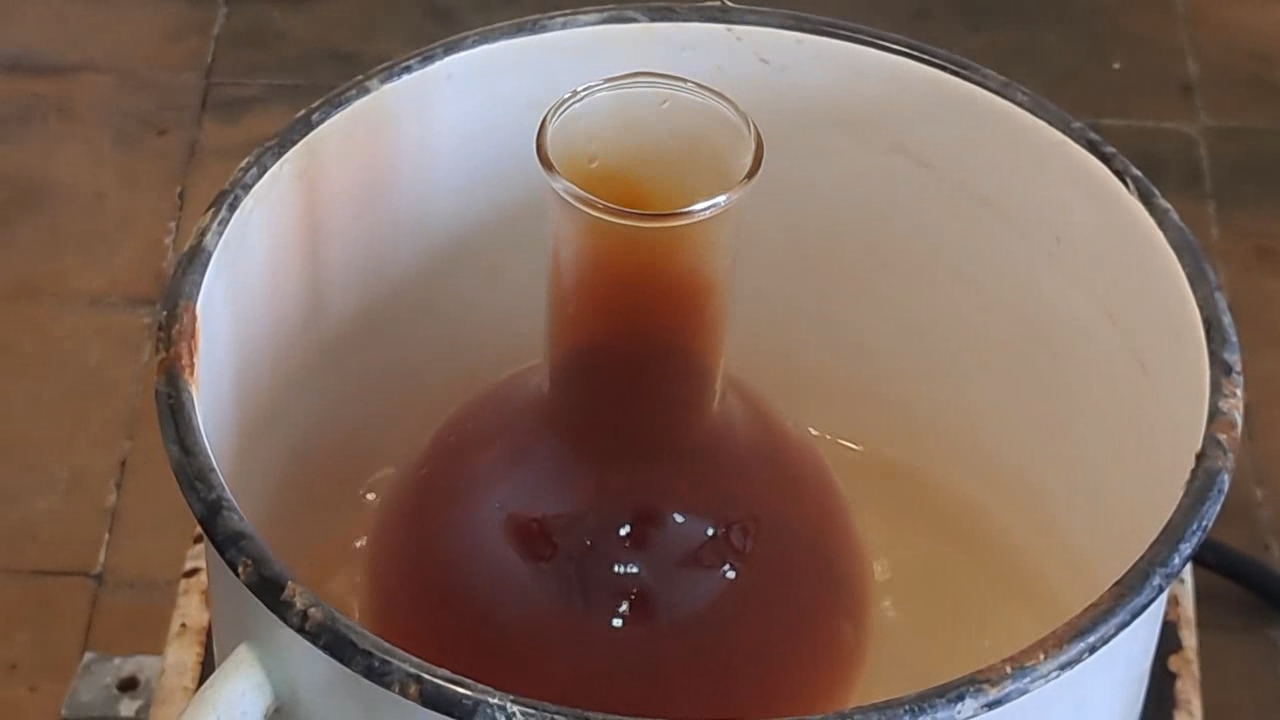
|
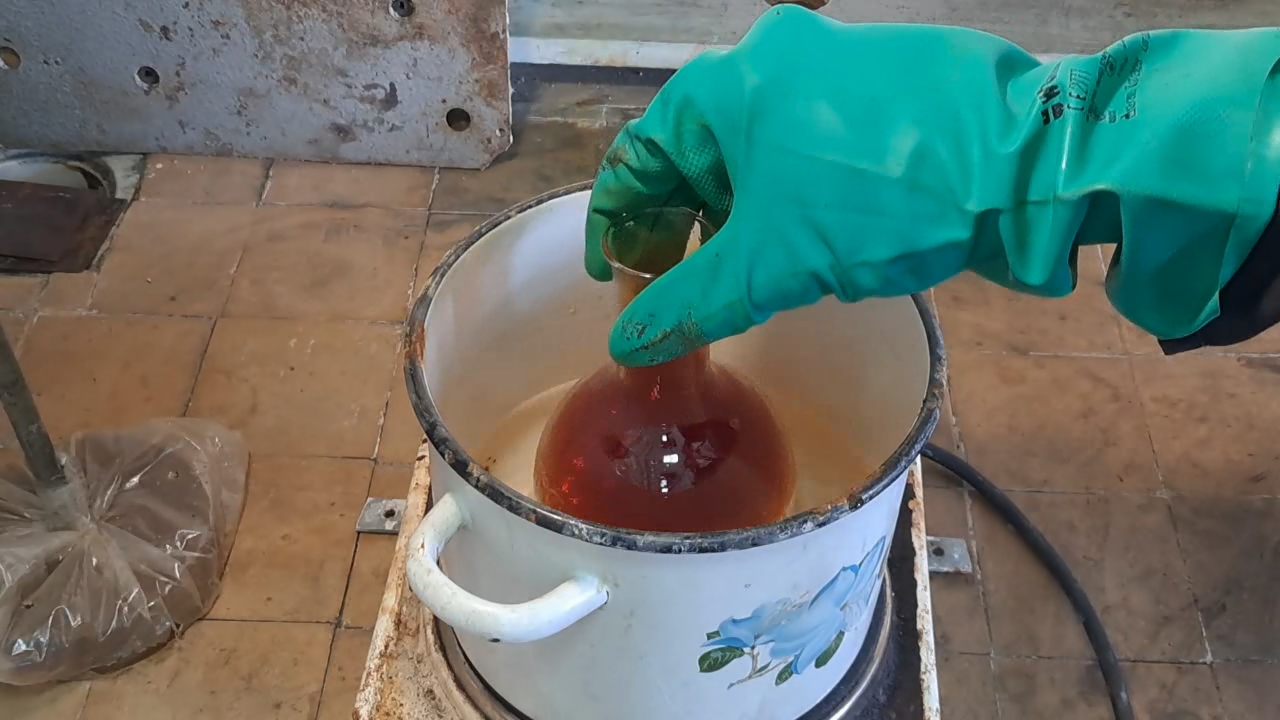
|
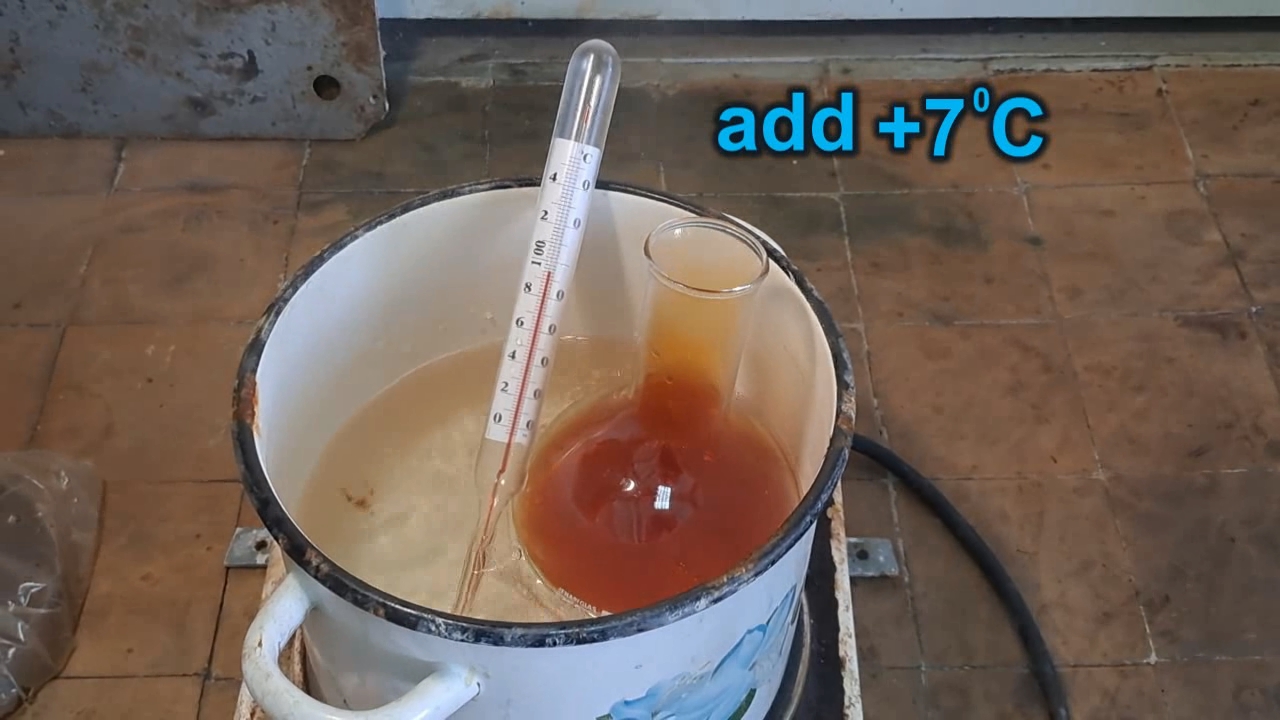
|
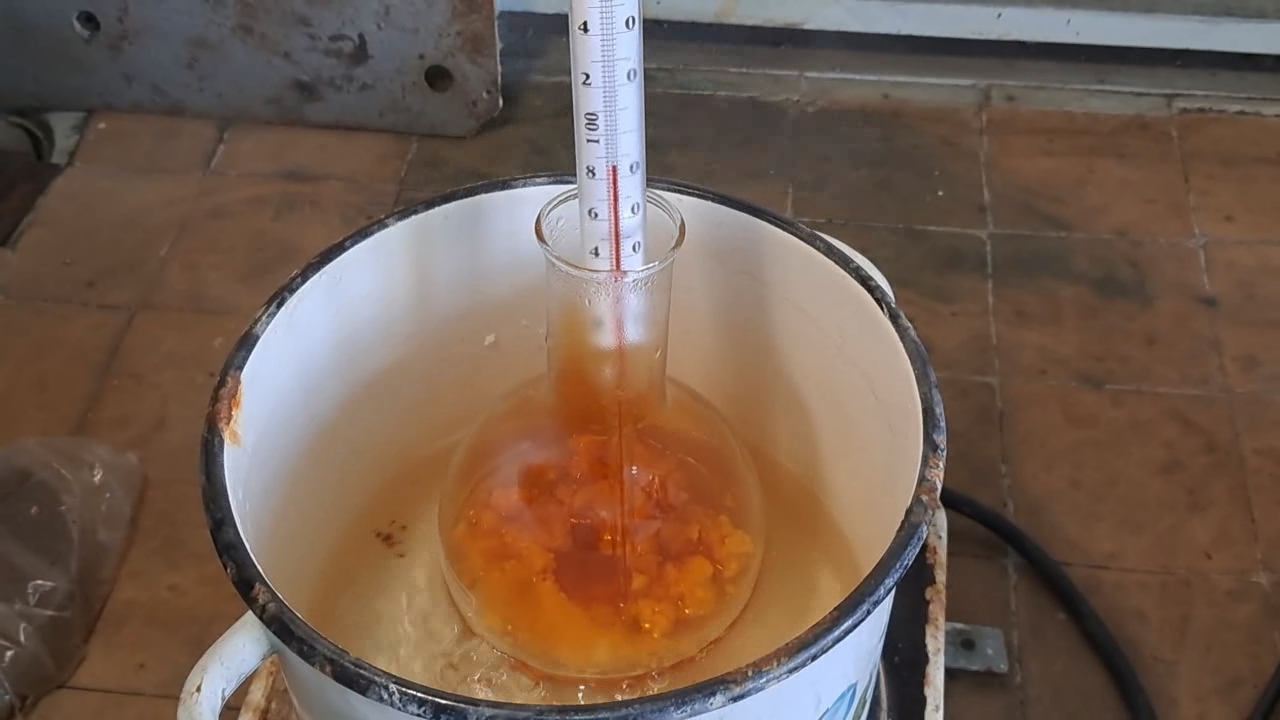
|
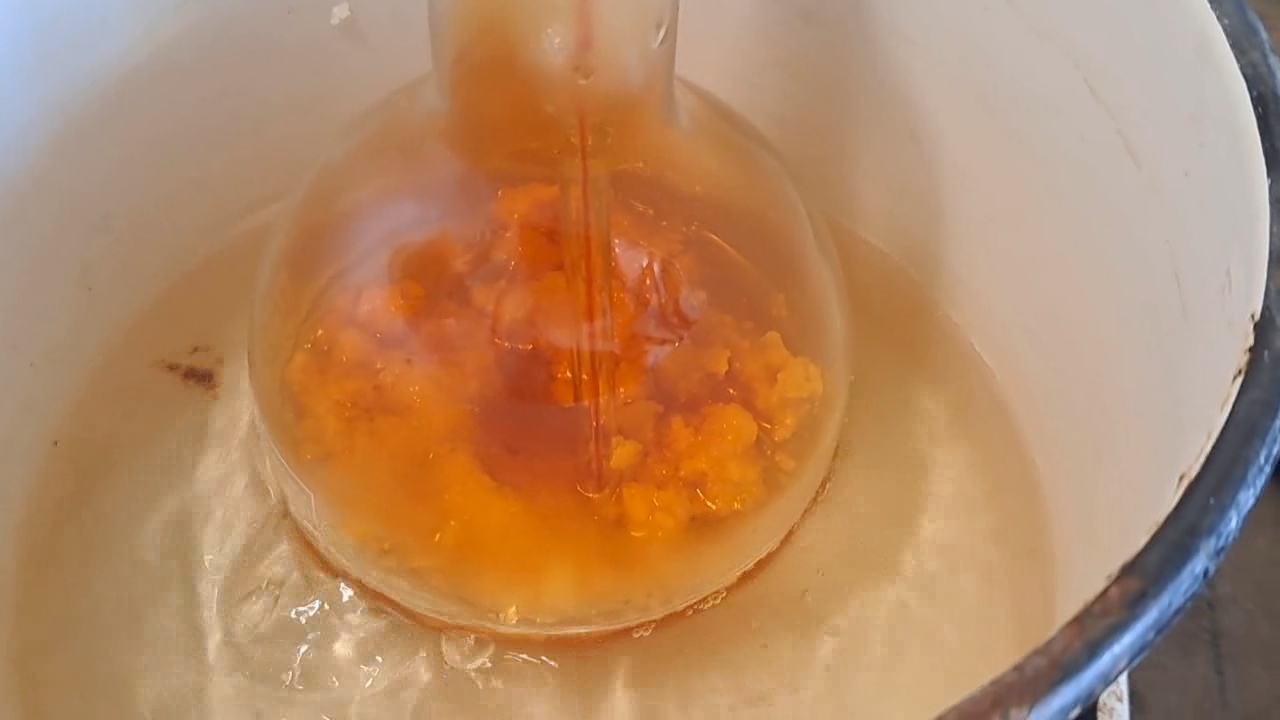
|
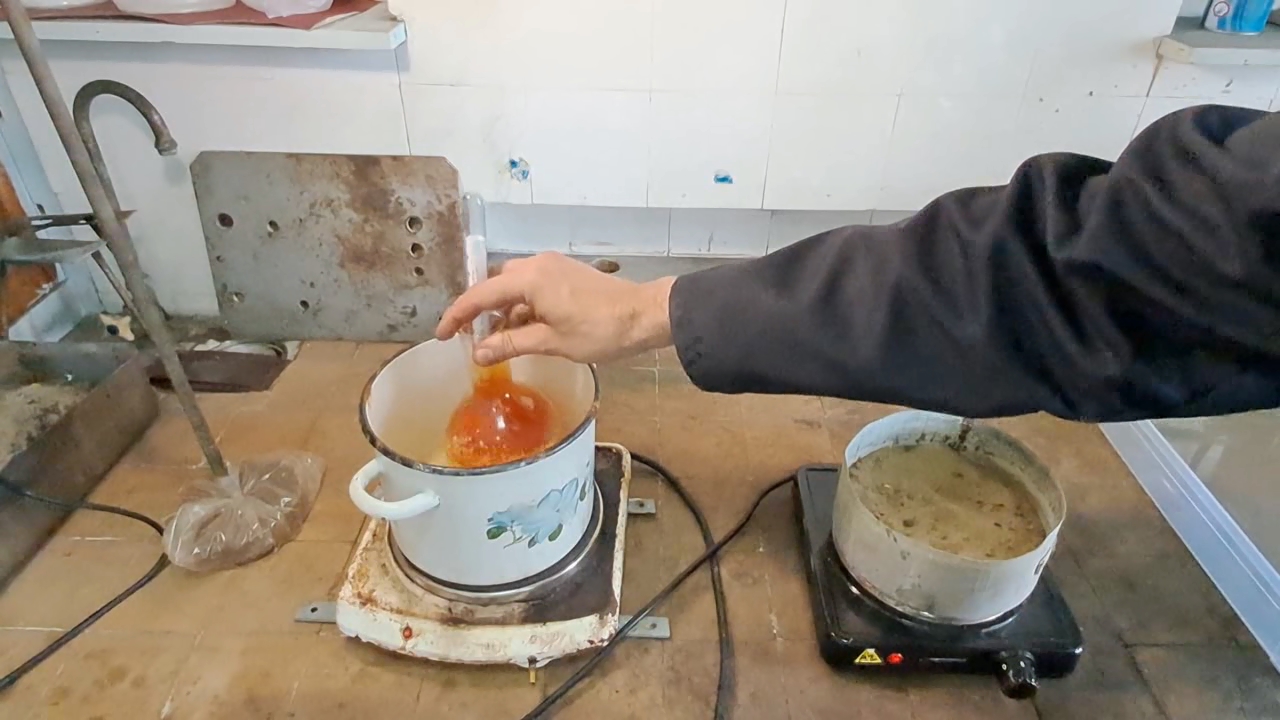
|
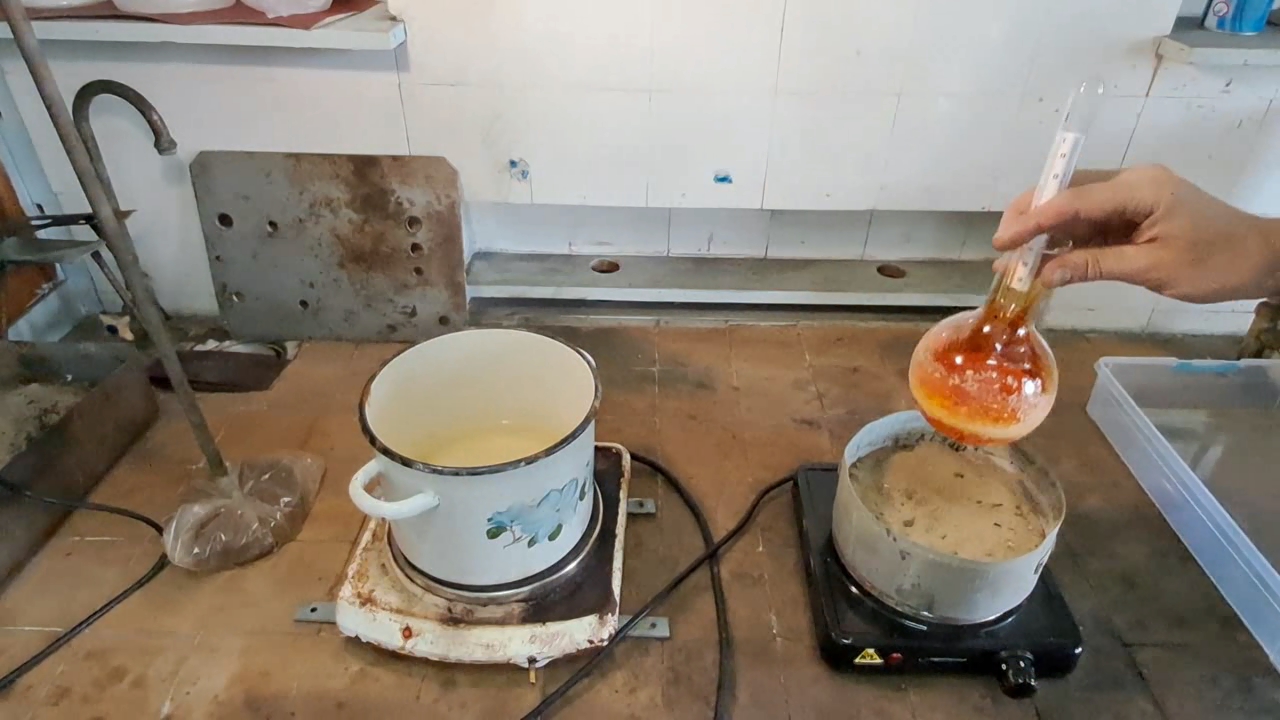
|
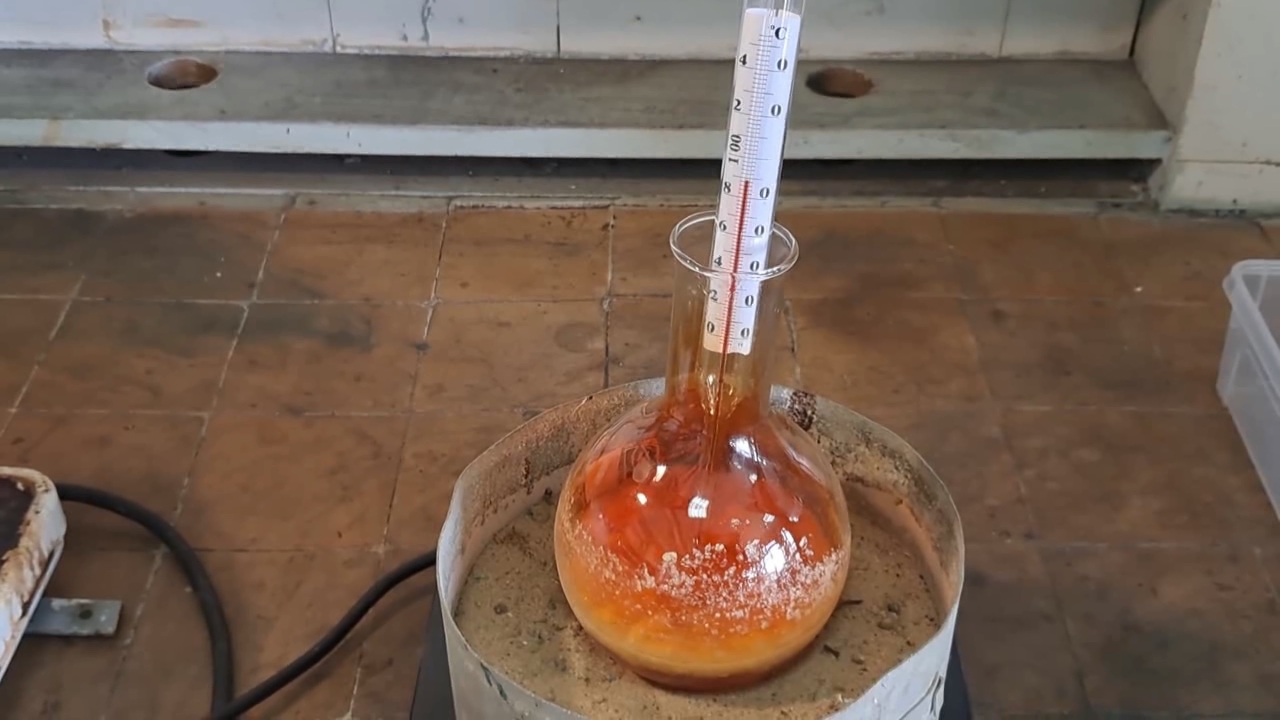
|
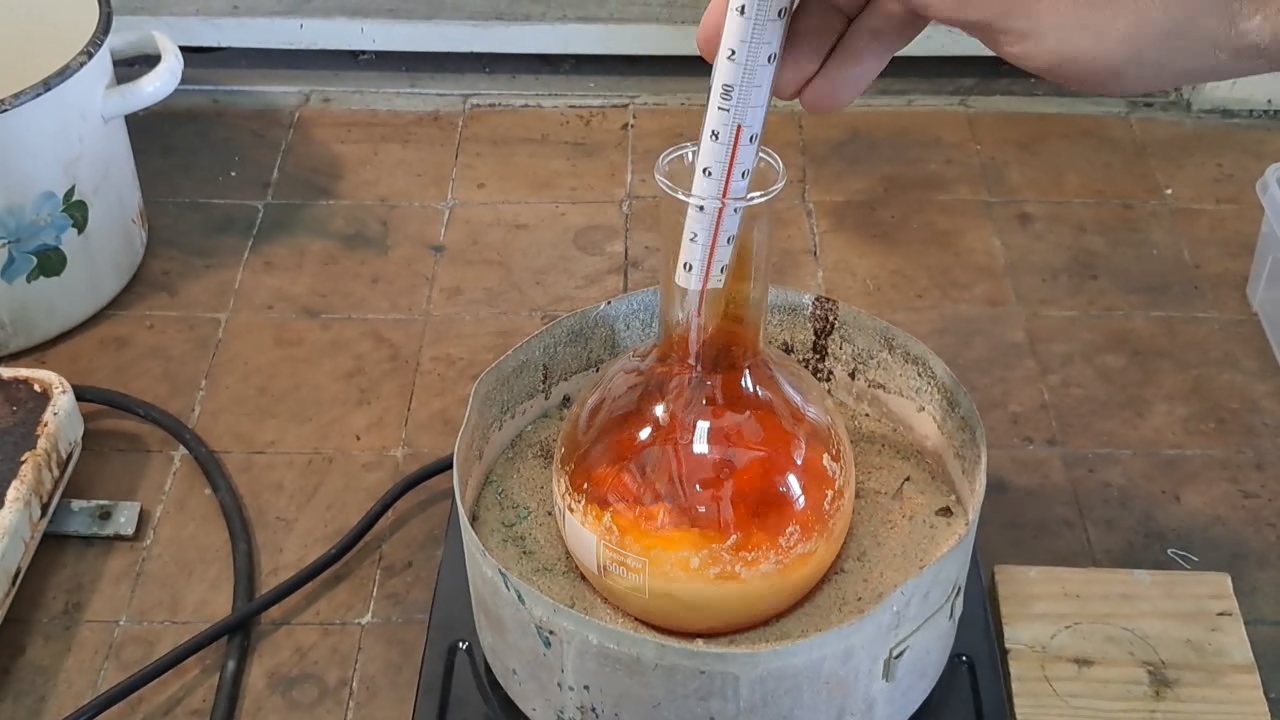
|
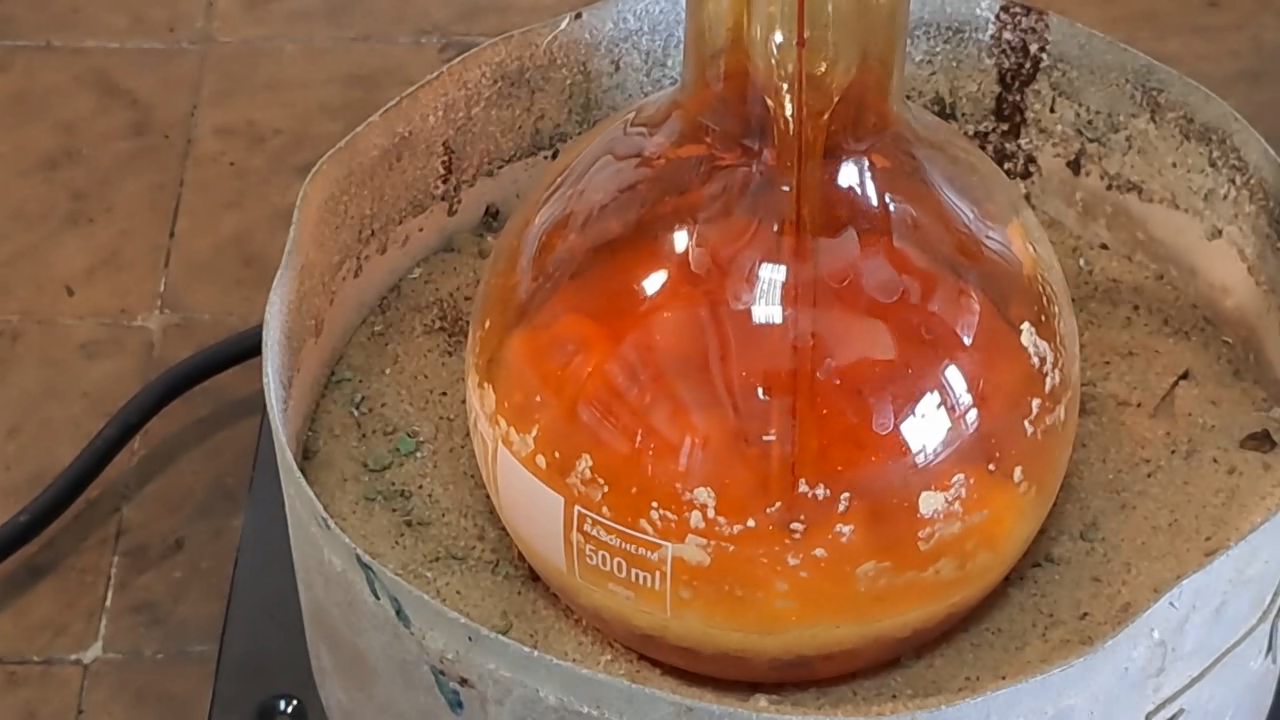
|
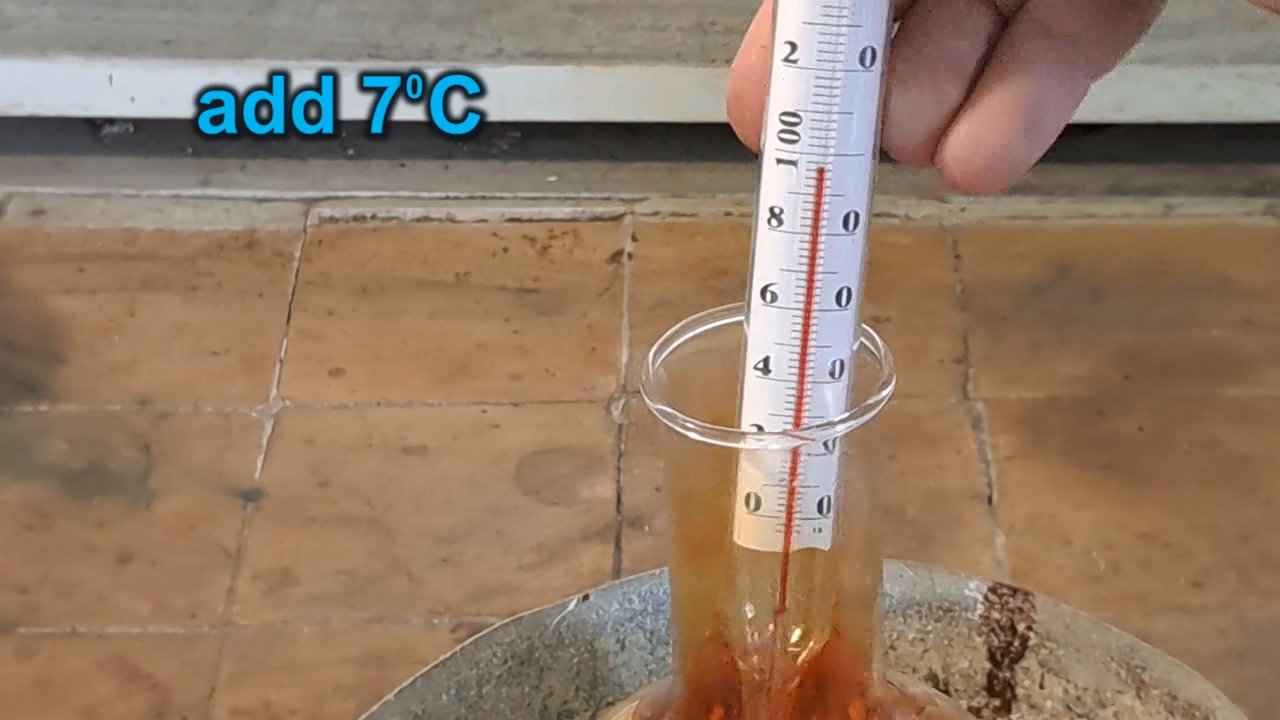
|
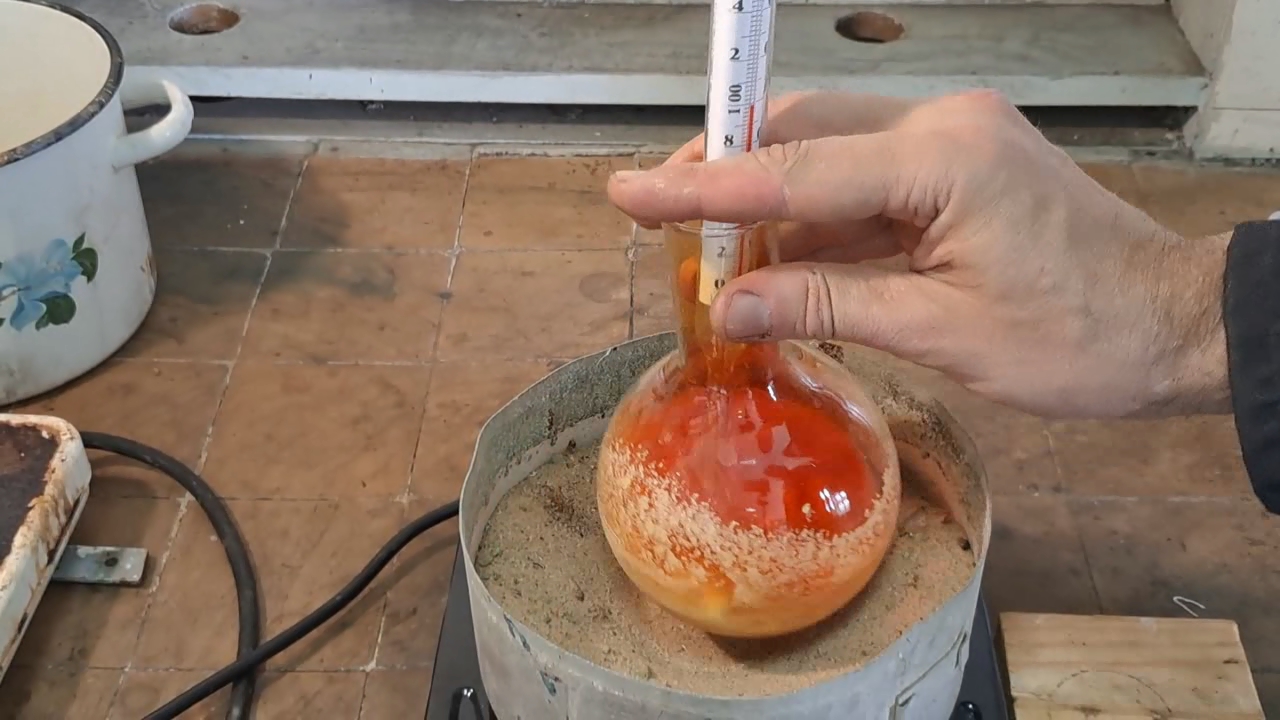
|
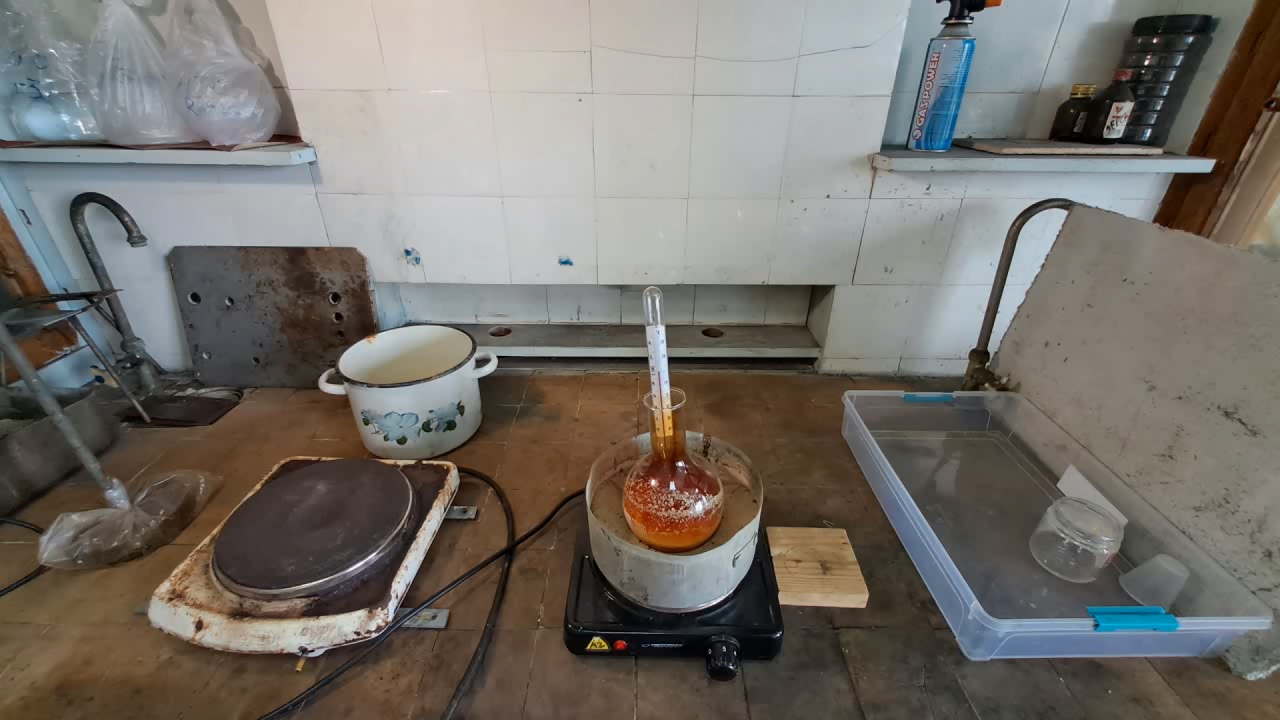
|
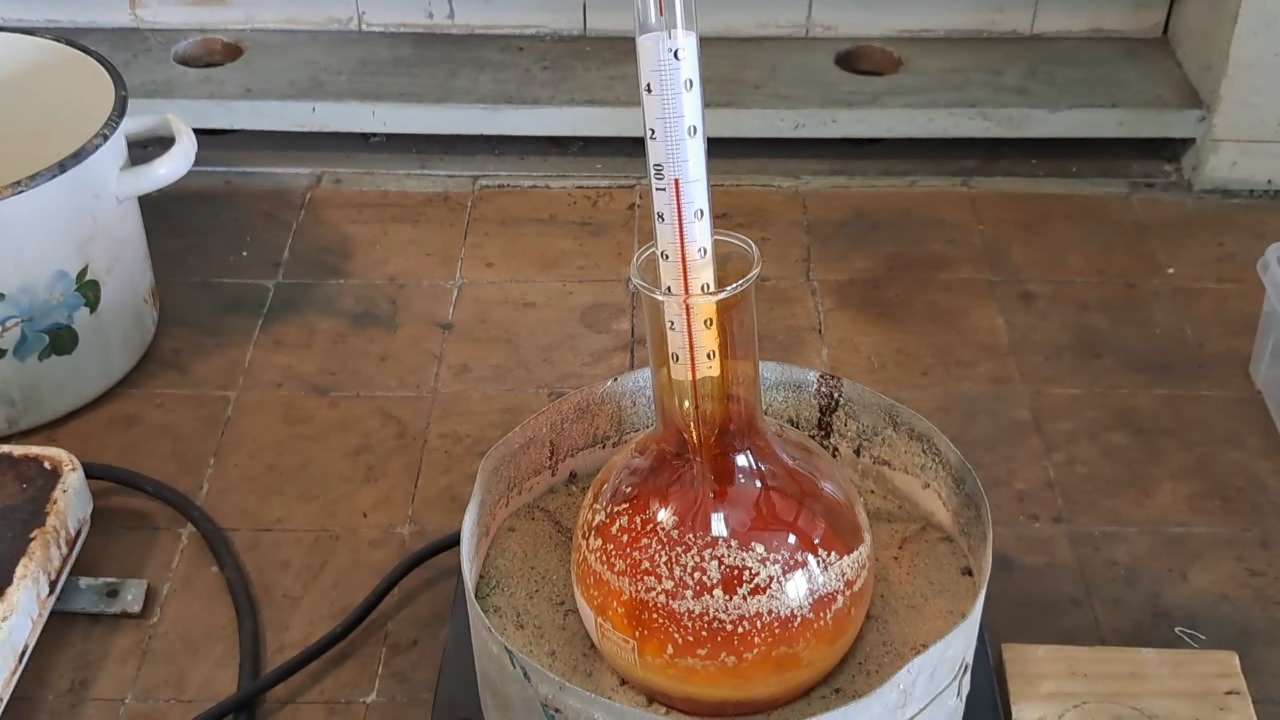
|
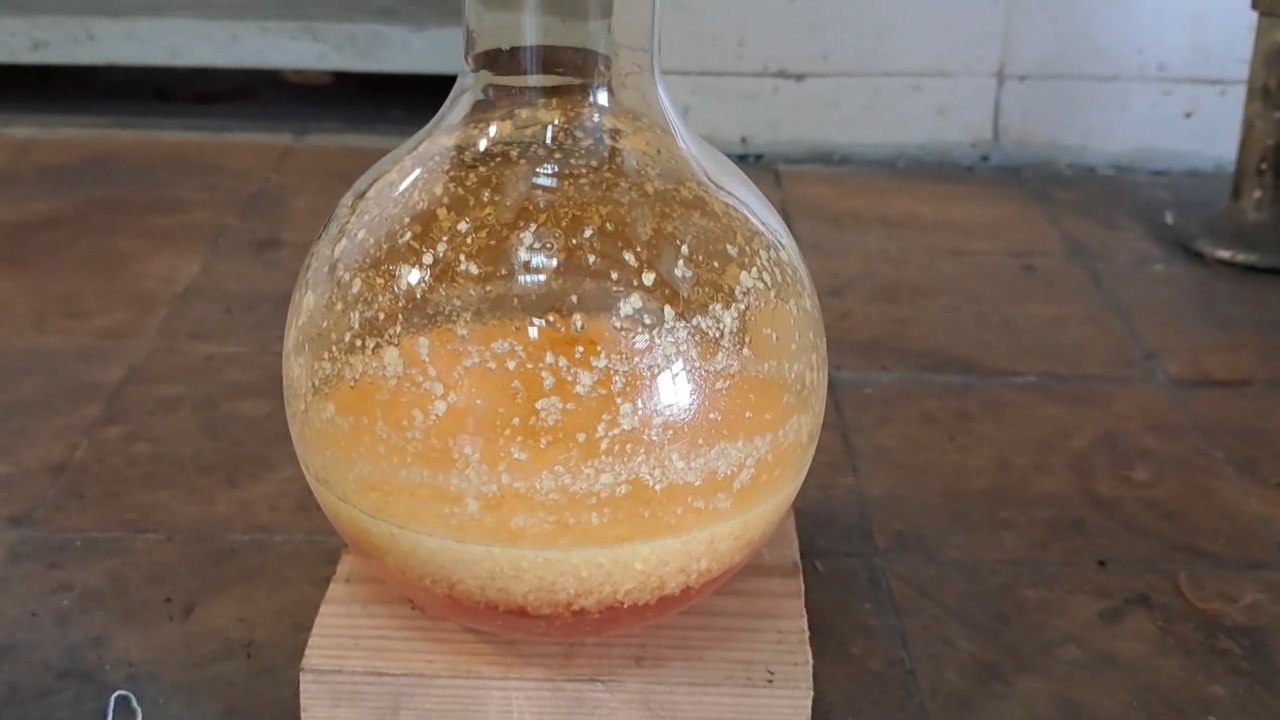
|
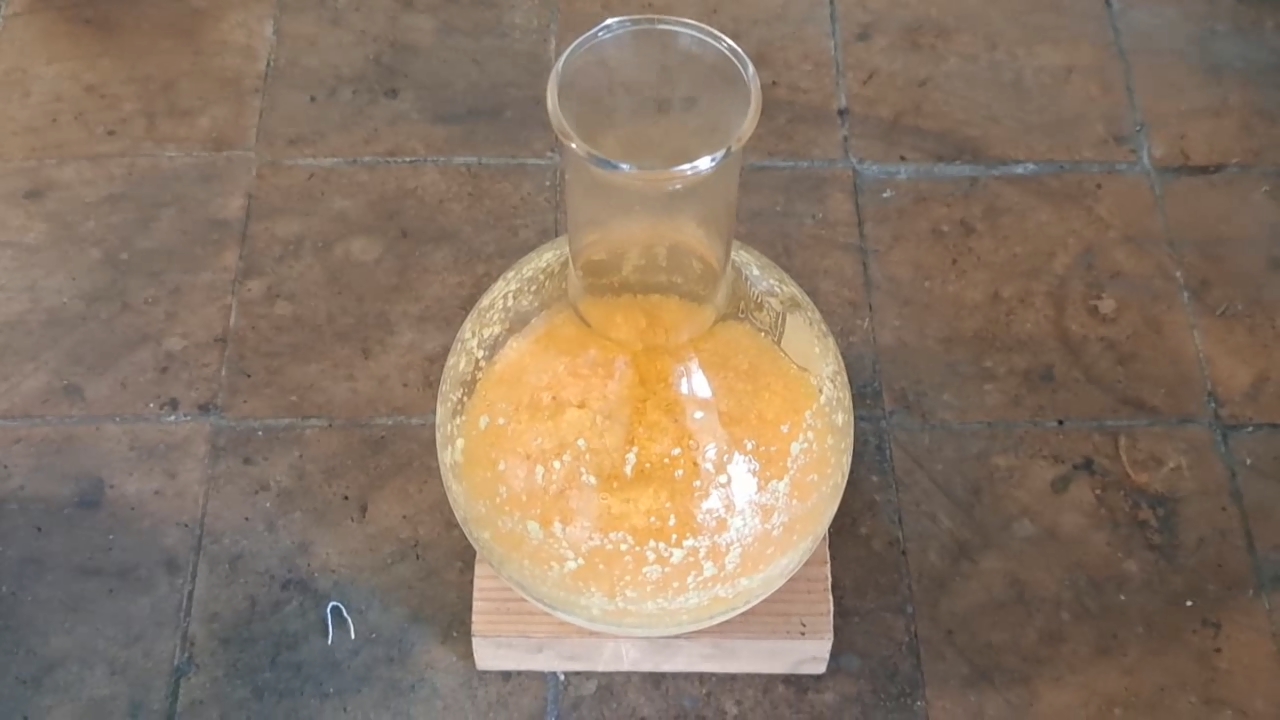
|
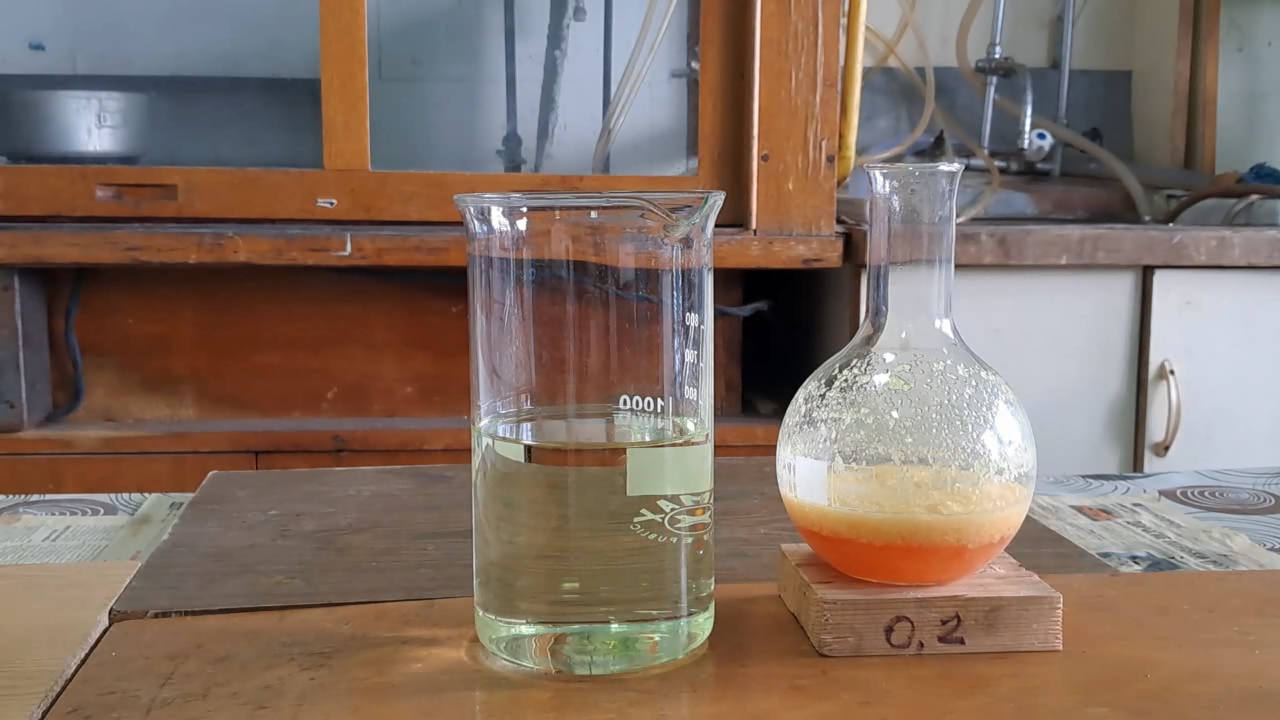
|
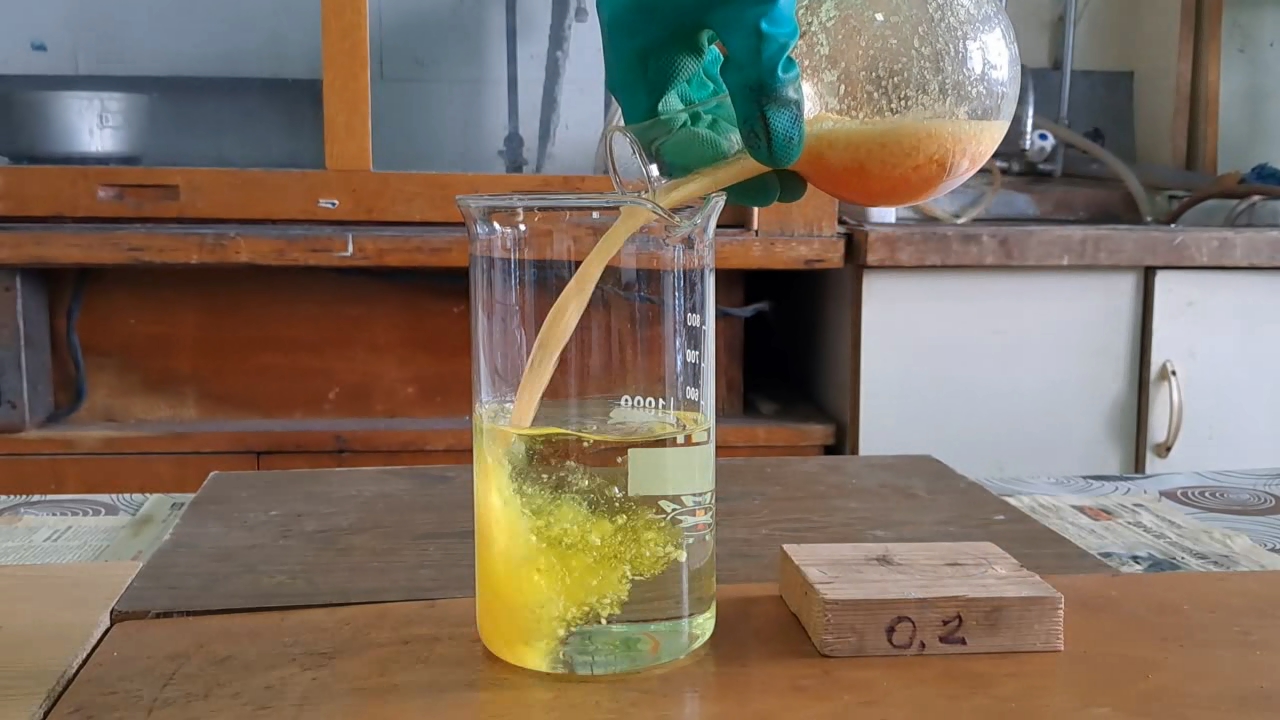
|
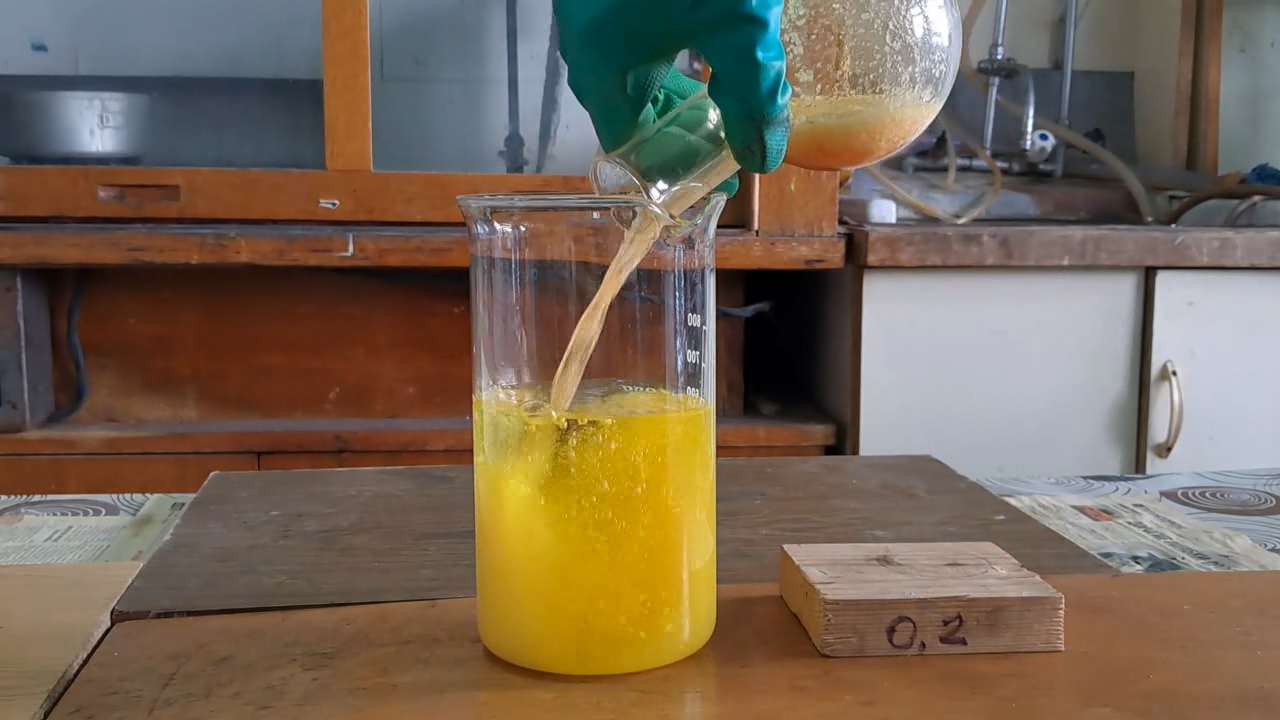
|
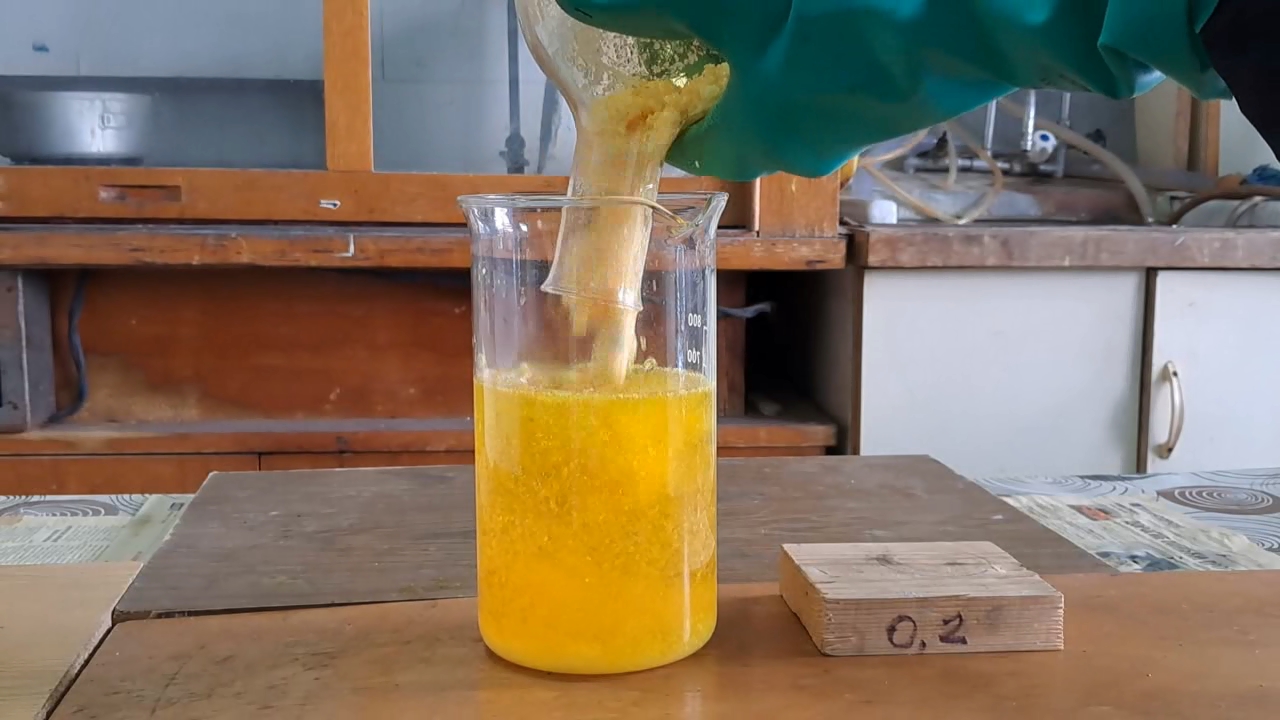
|
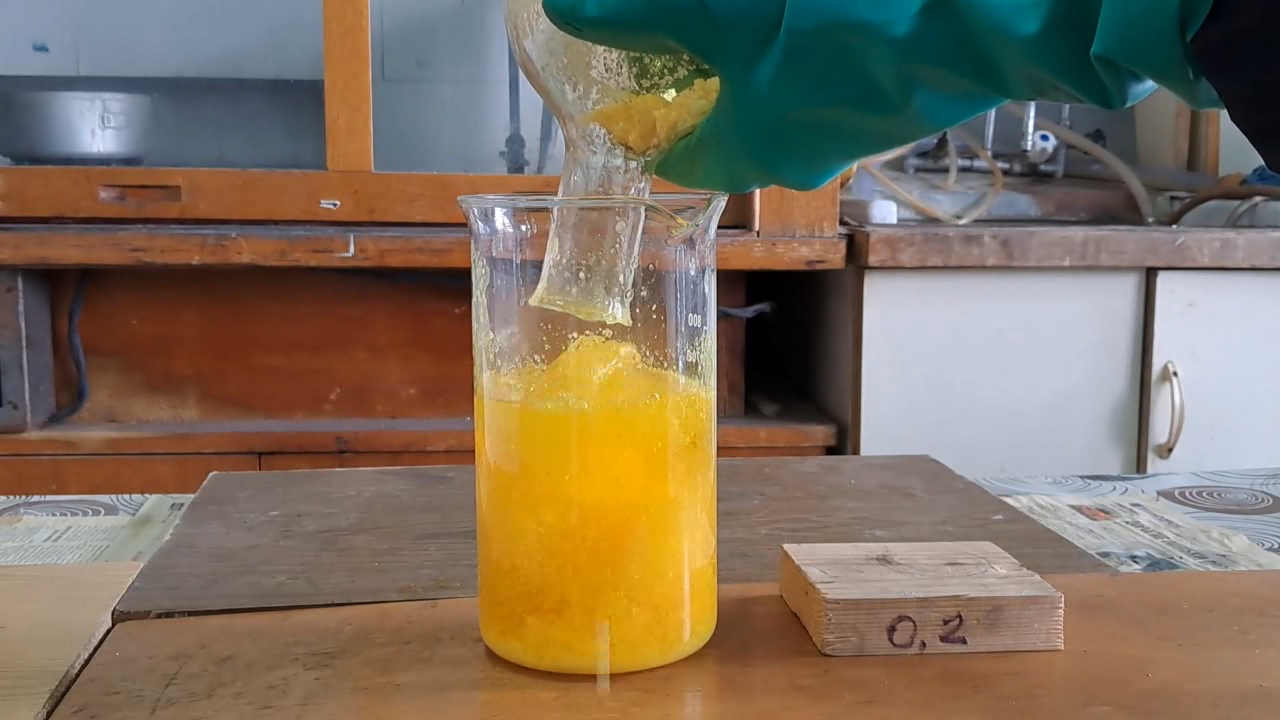
|
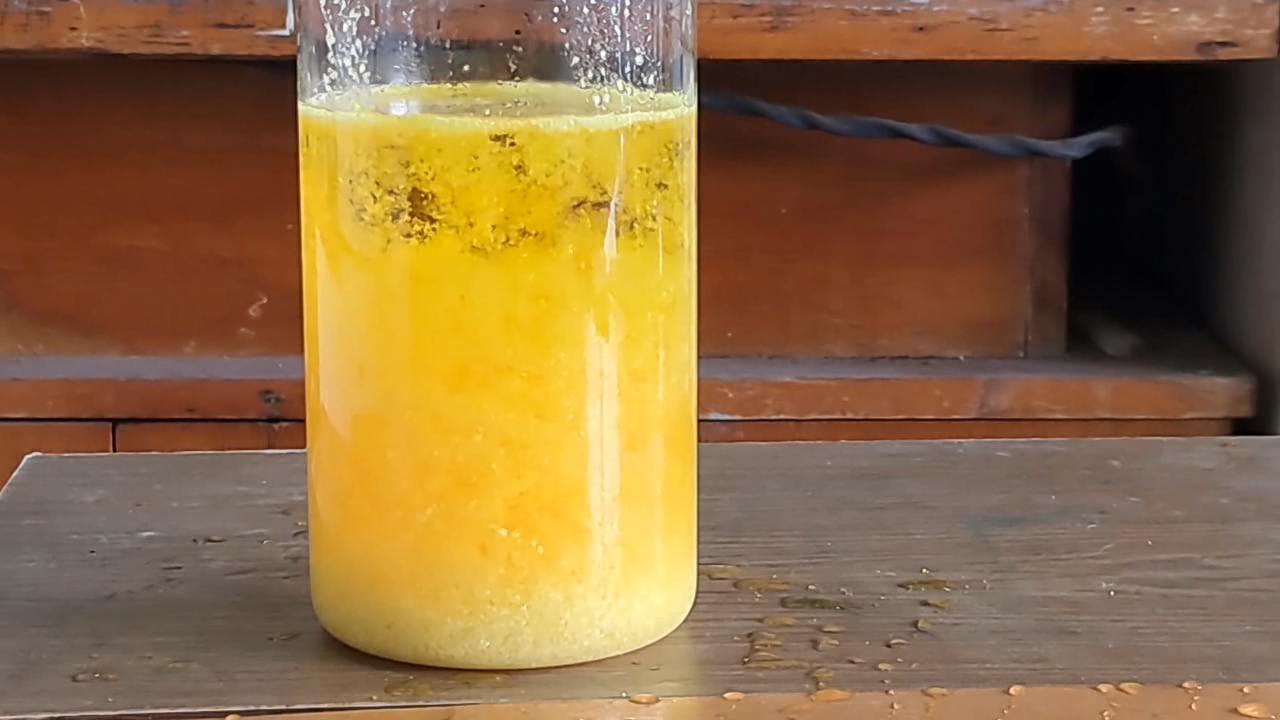
|
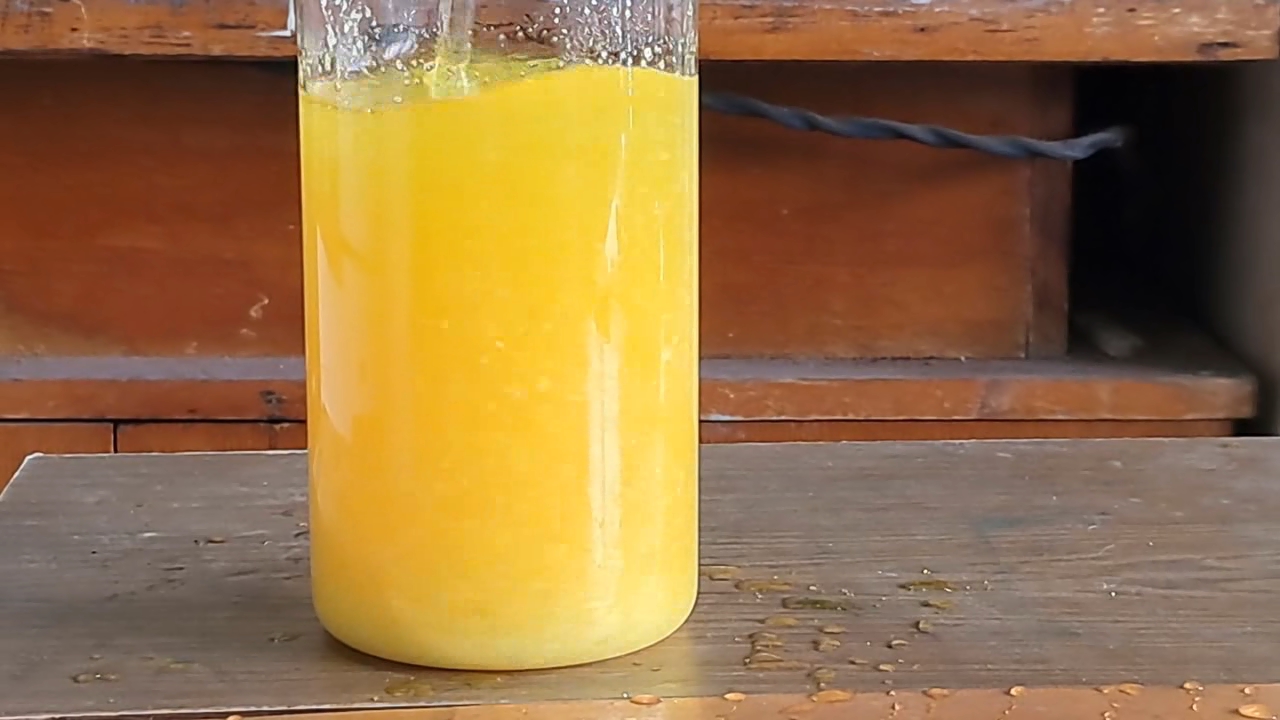
|
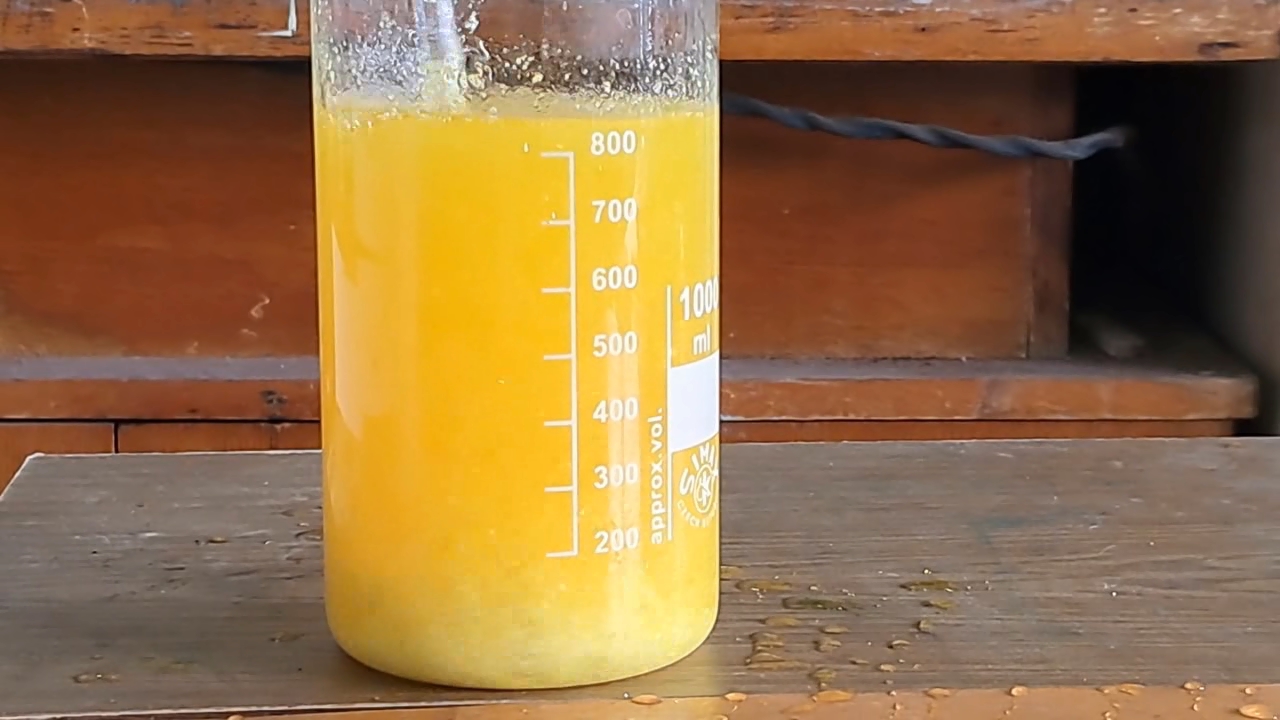
|
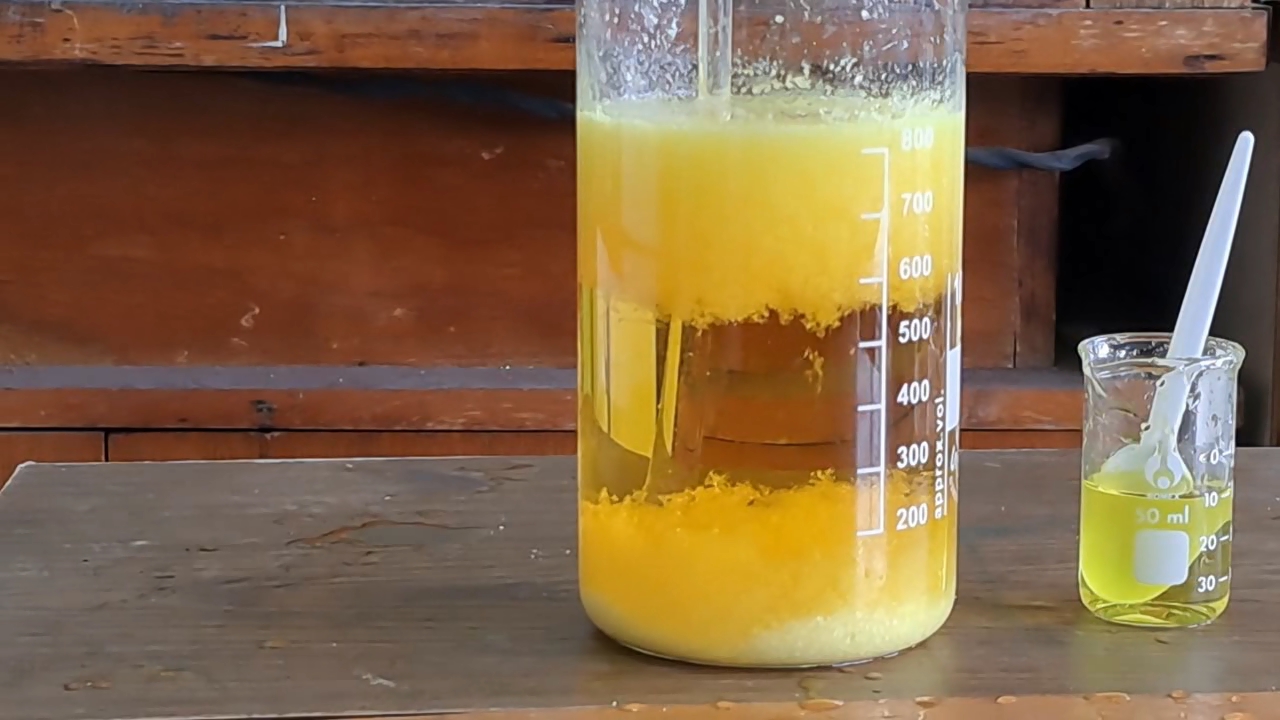
|
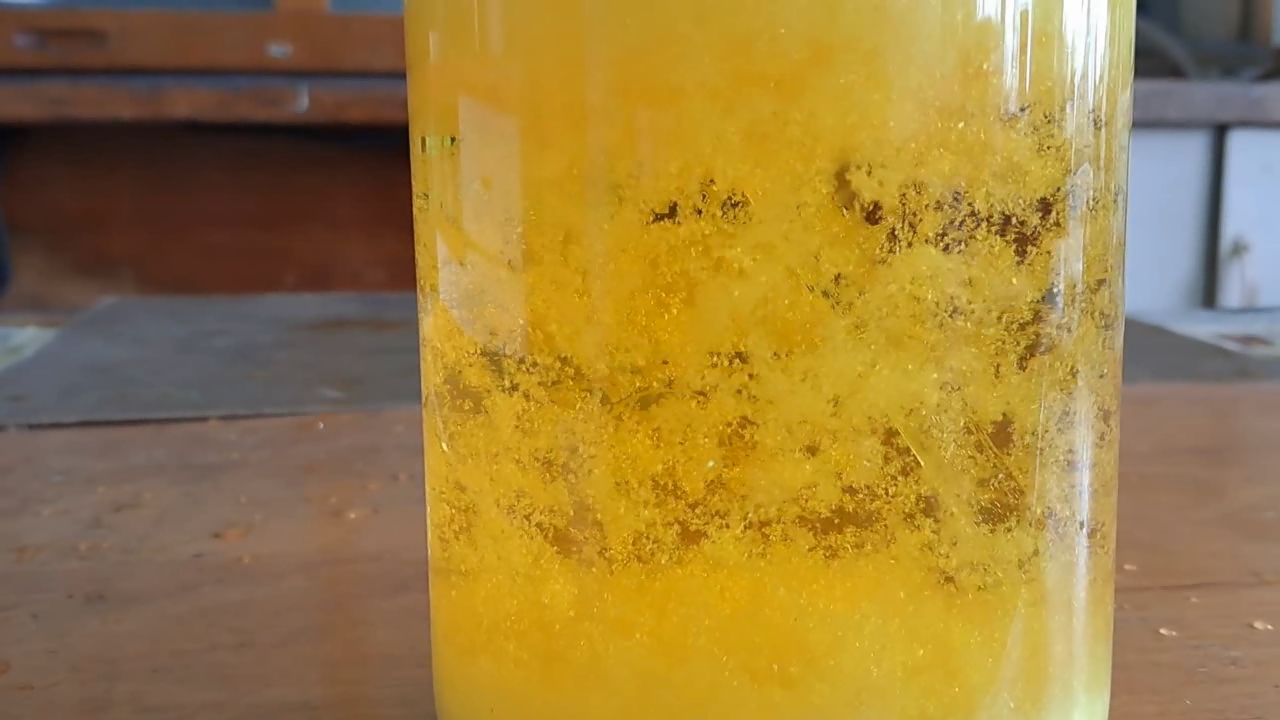
|
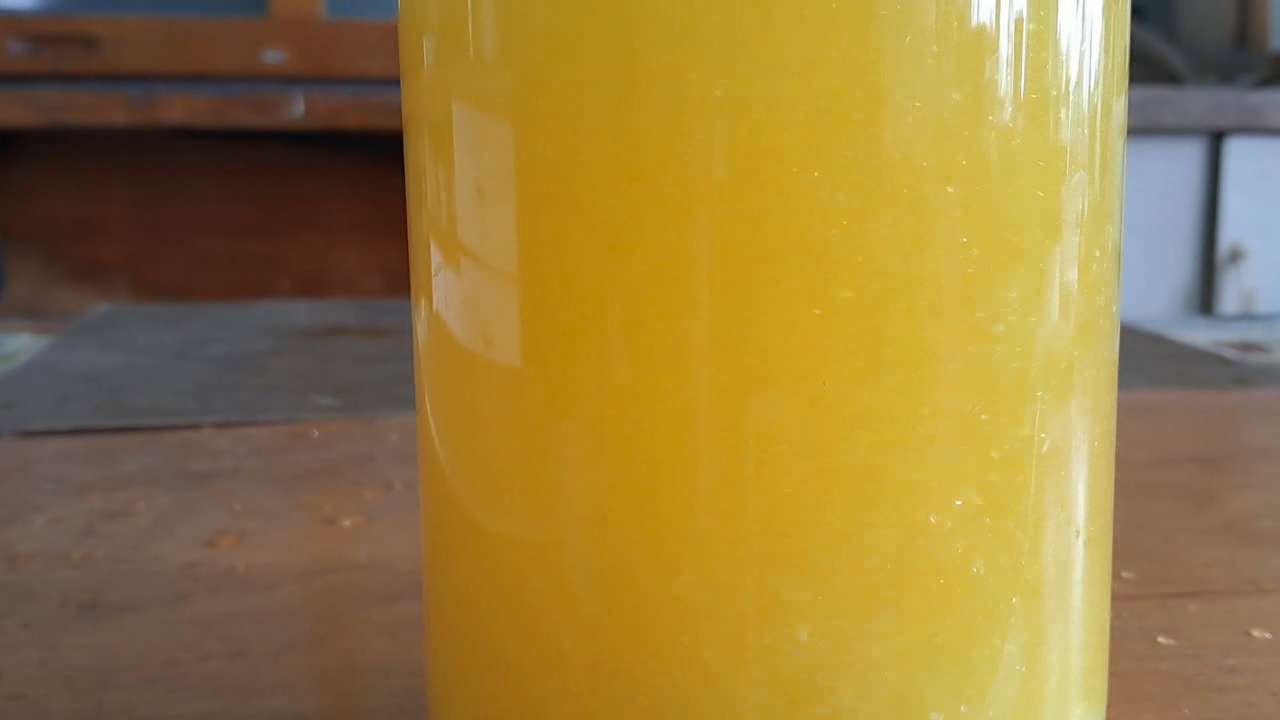
|
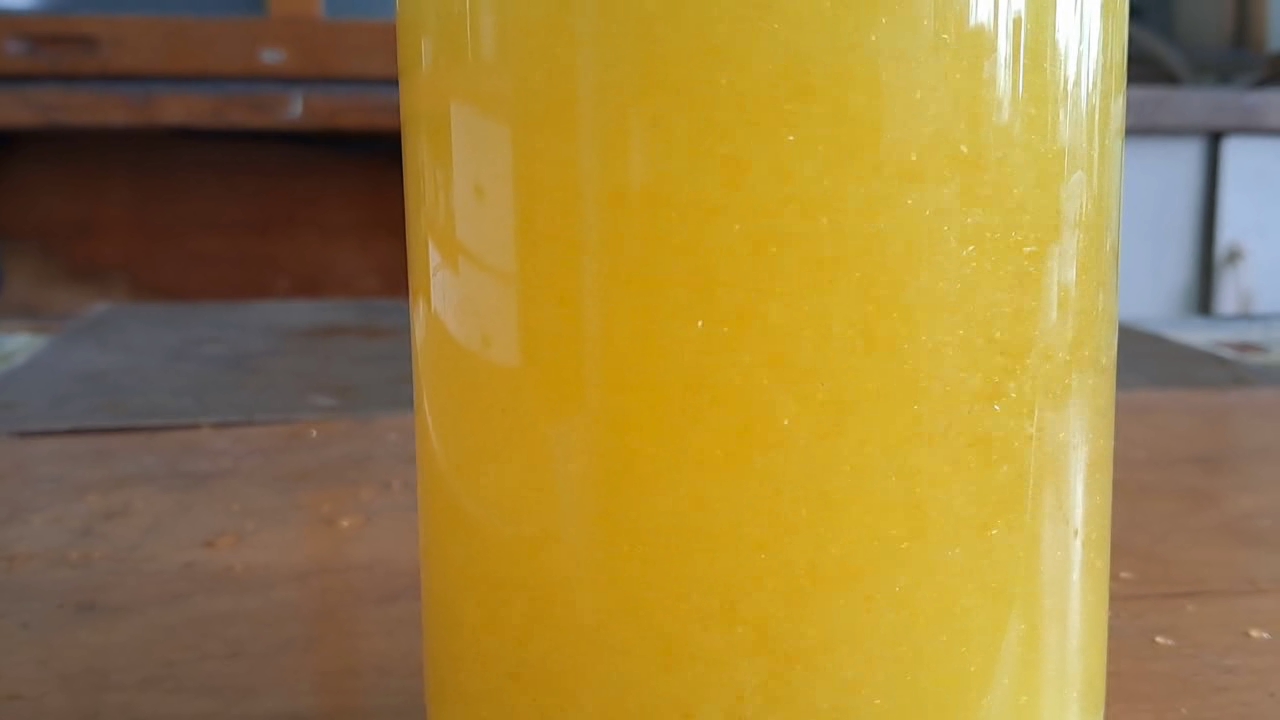
|
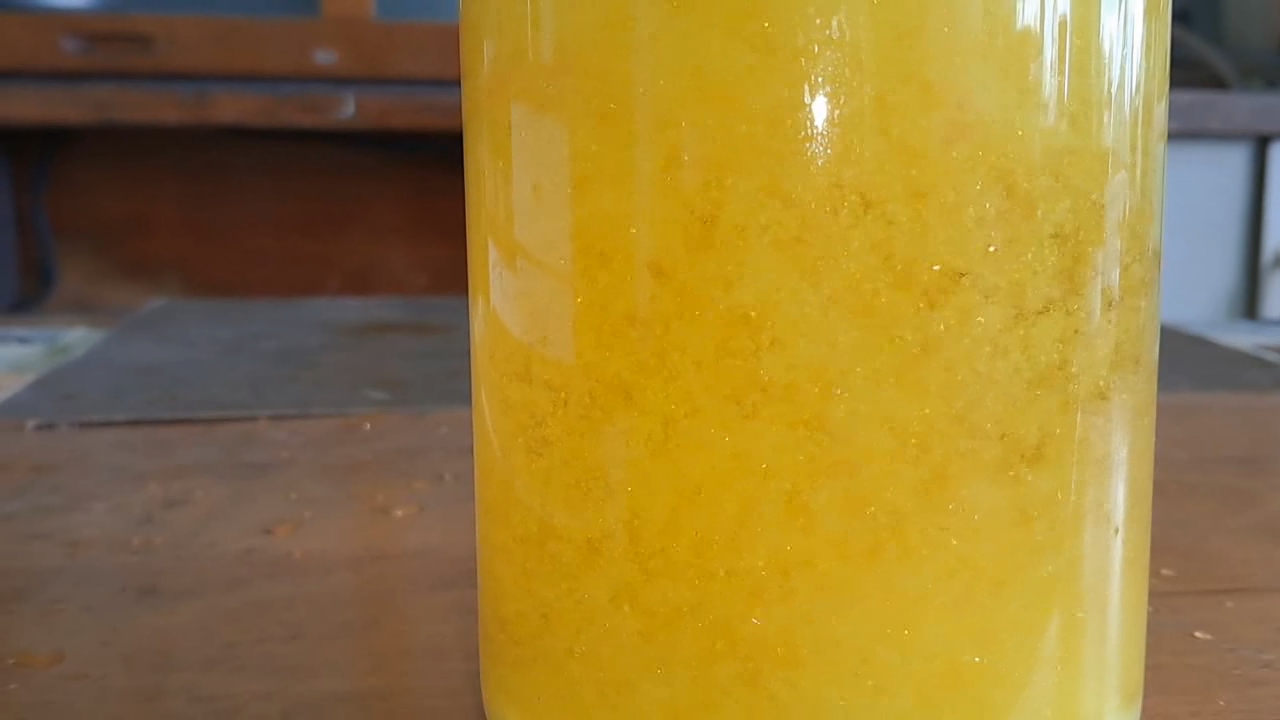
|
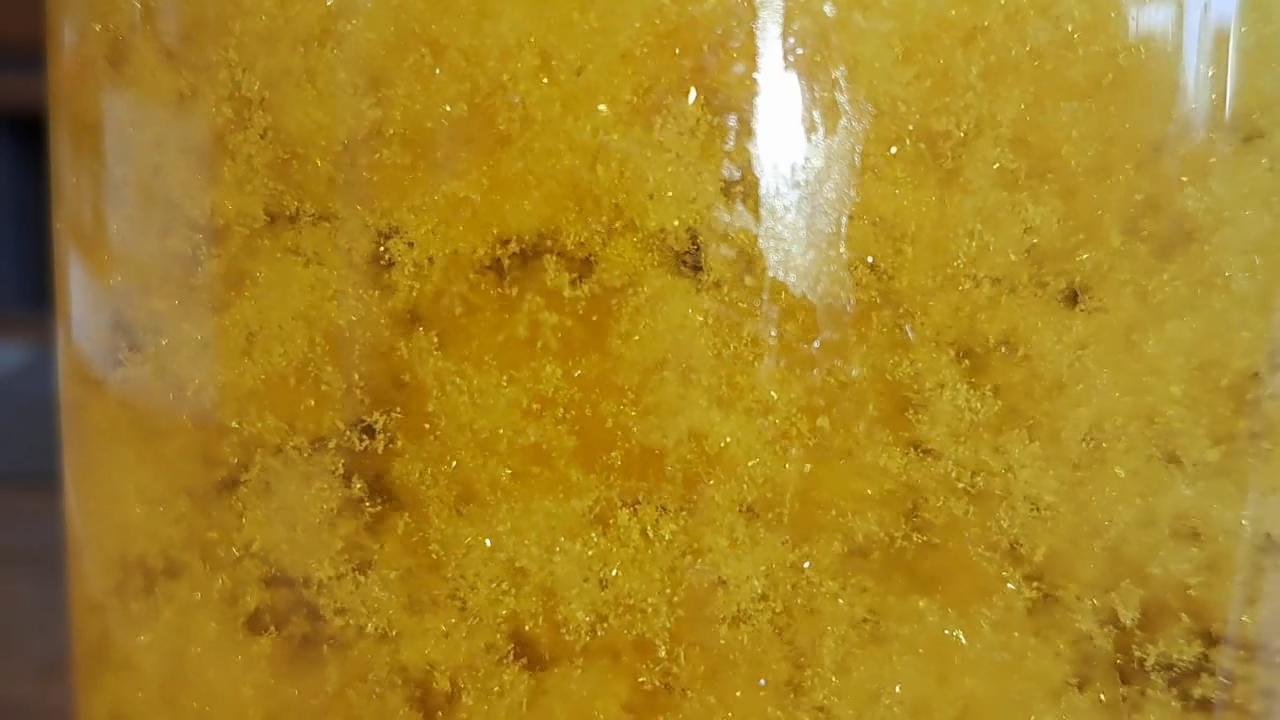
|
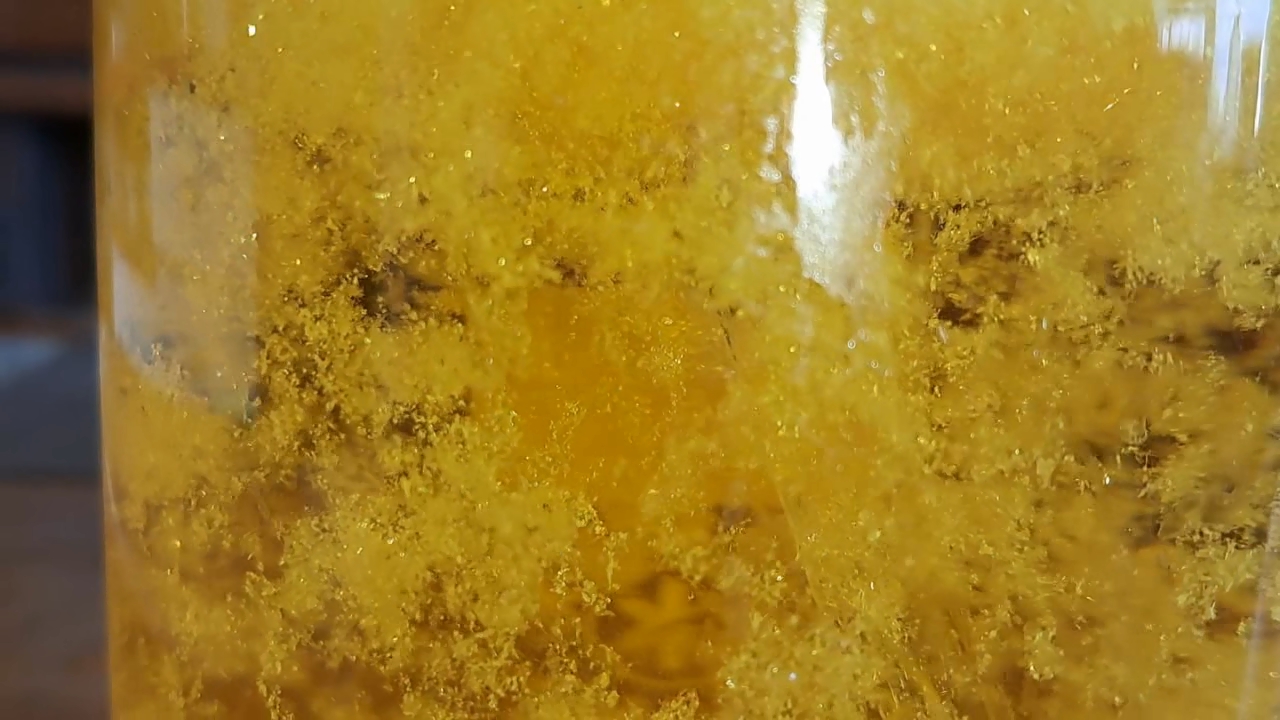
|
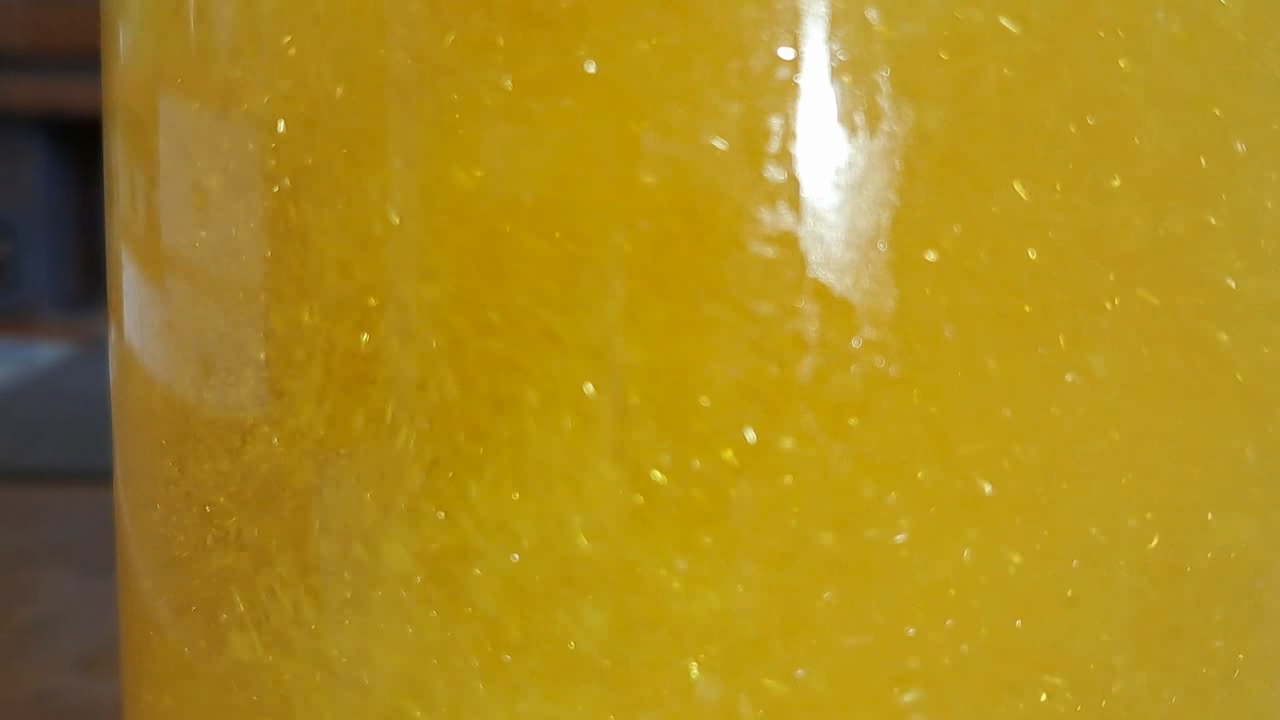
|
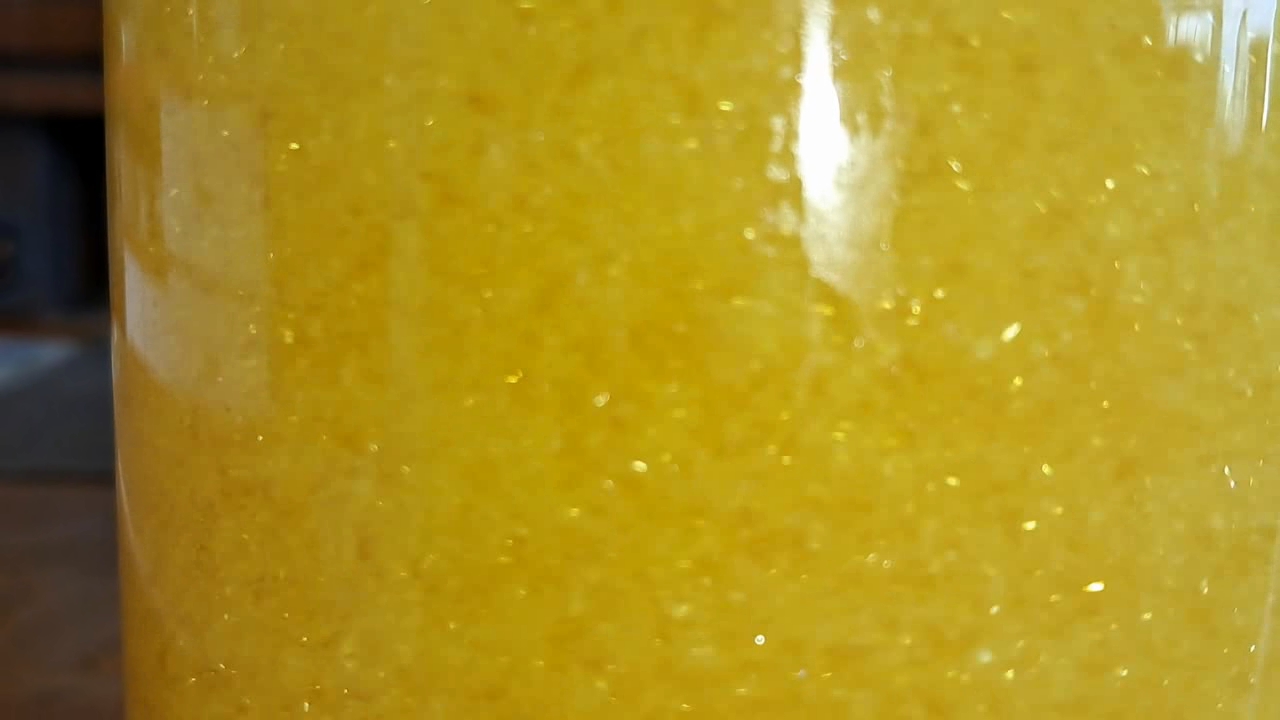
|
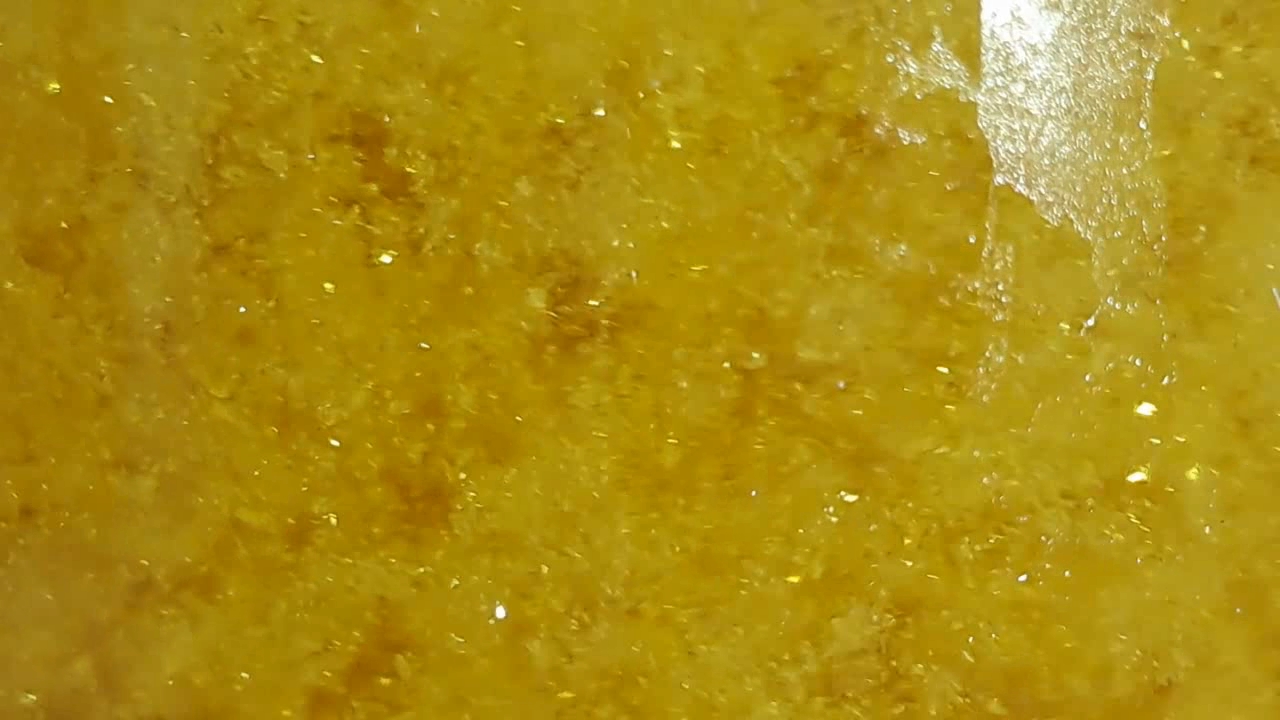
|
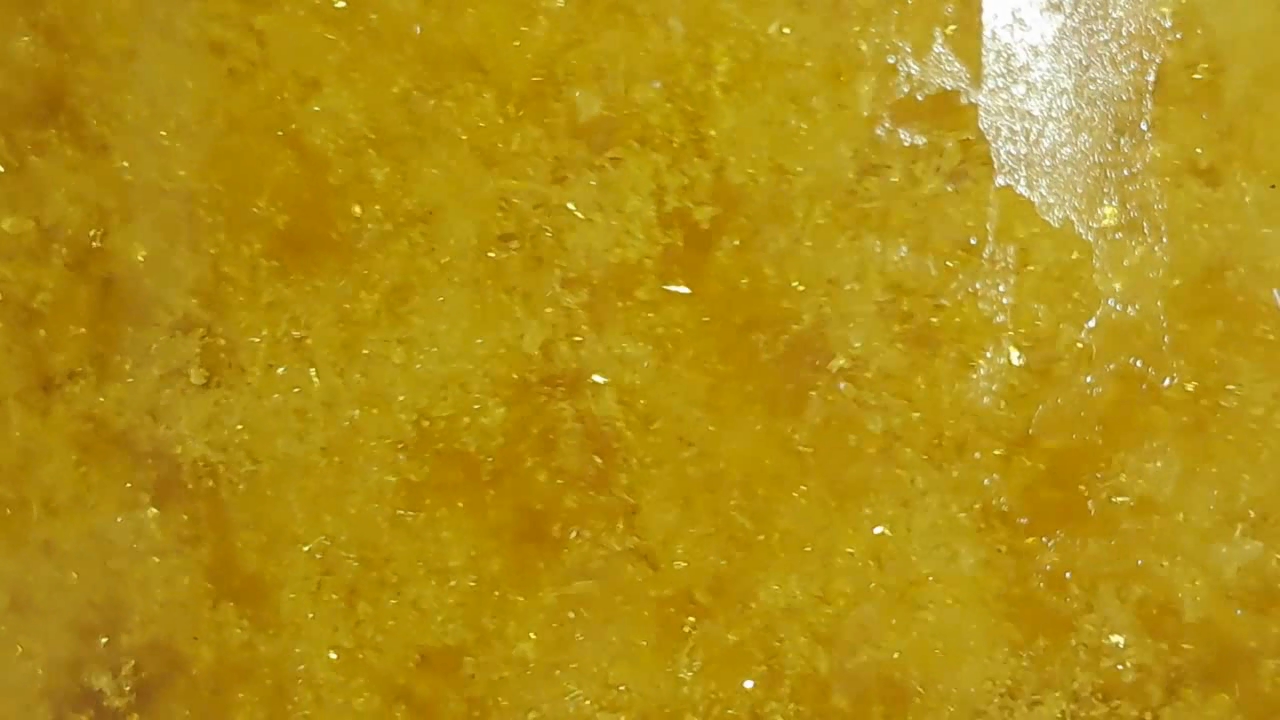
|
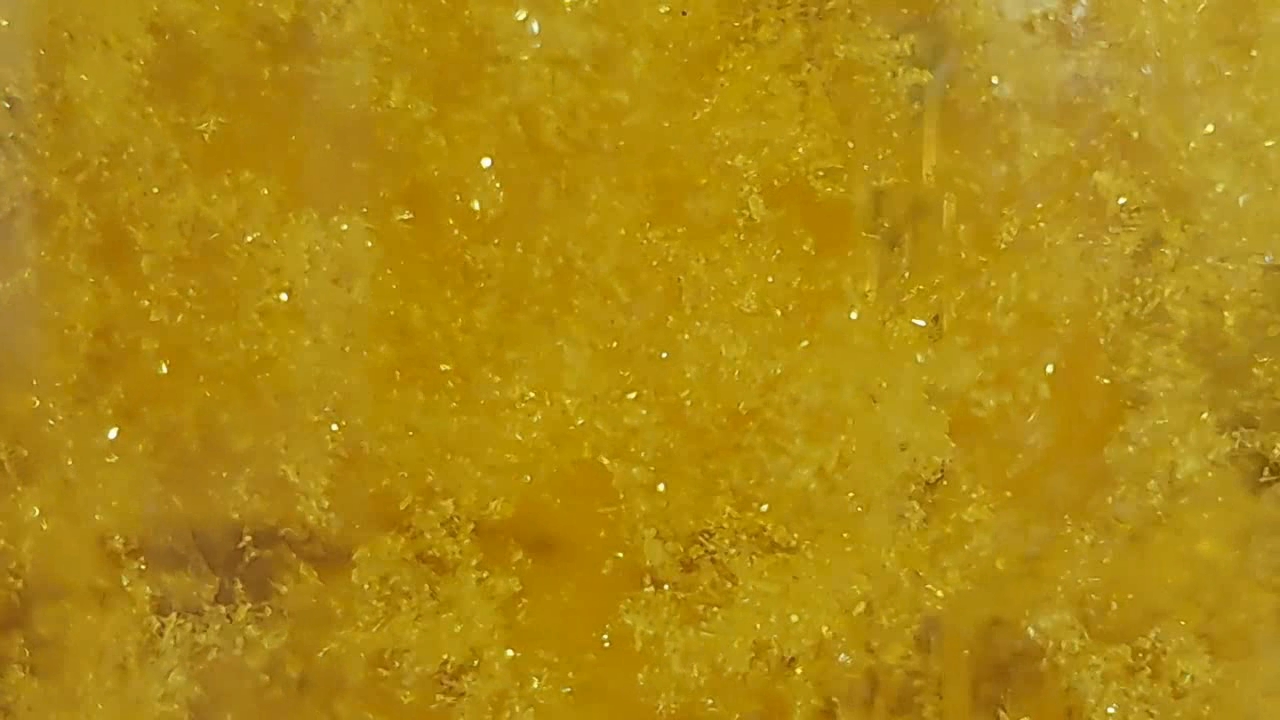
|
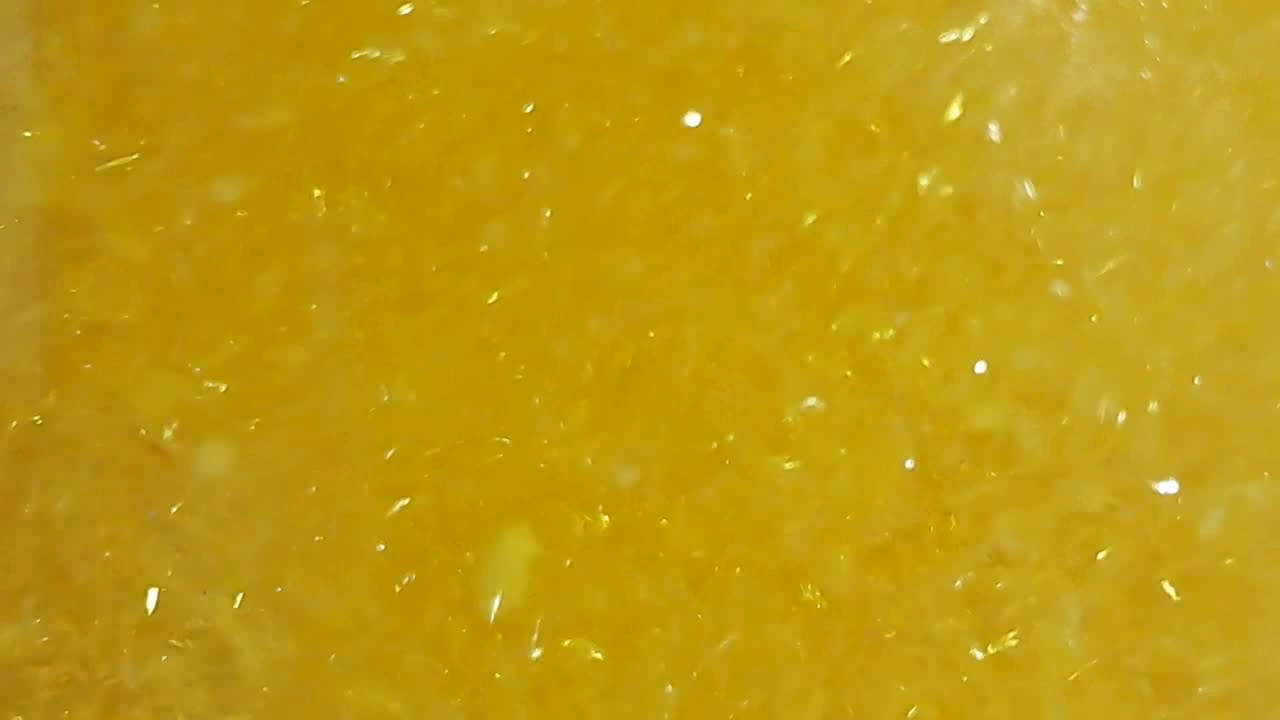
|
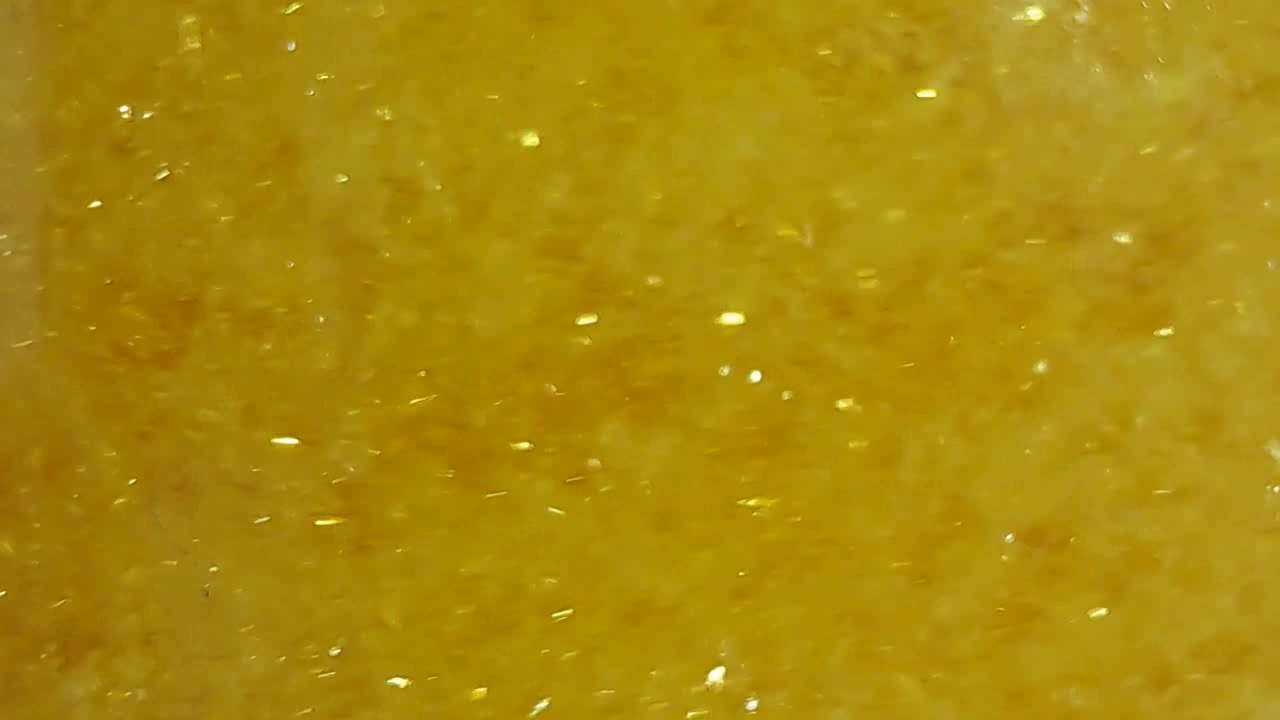
|
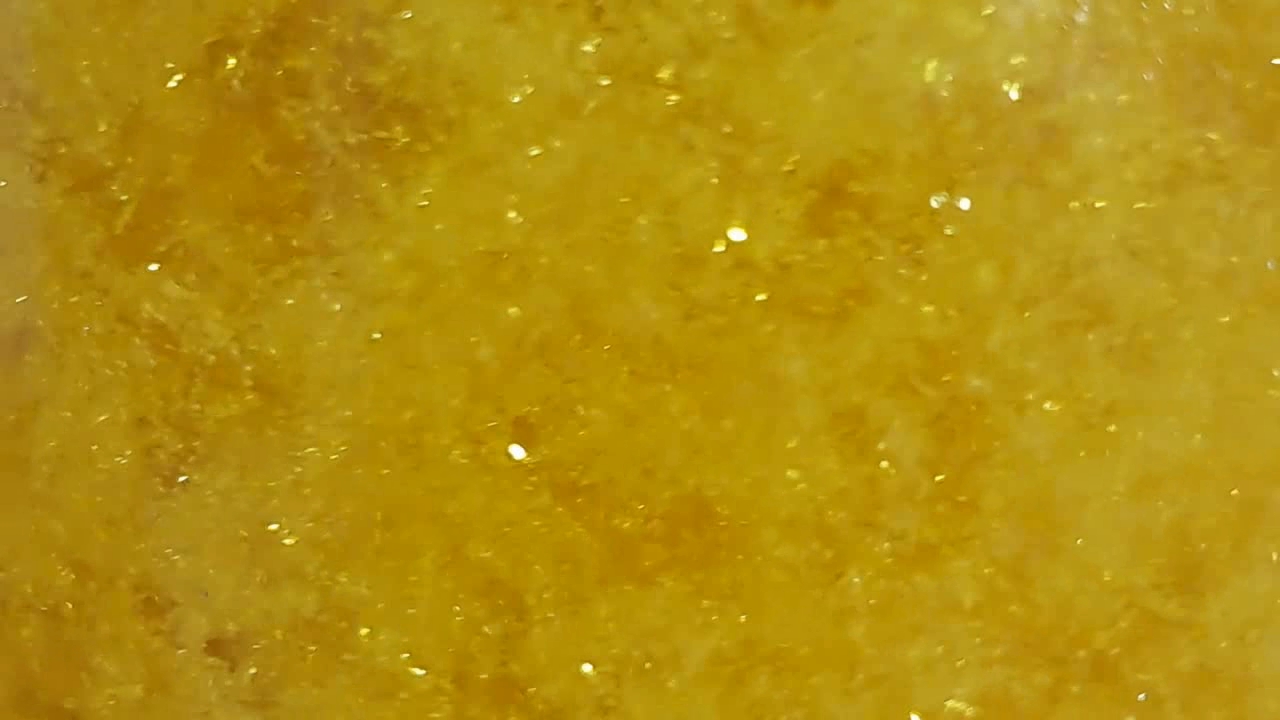
|
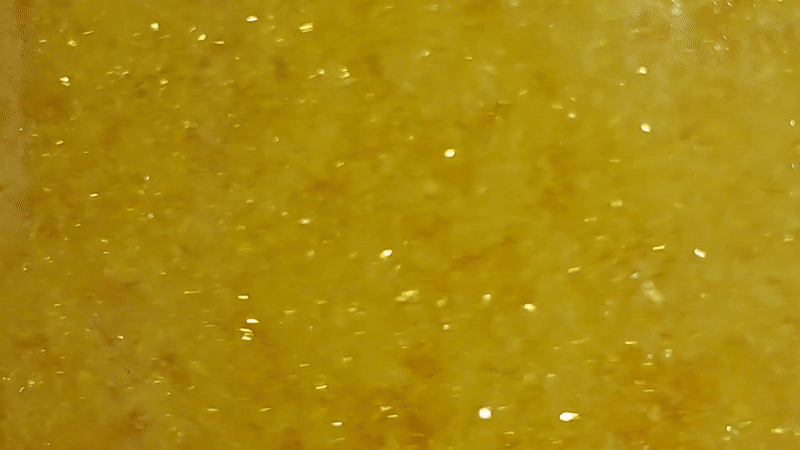
|
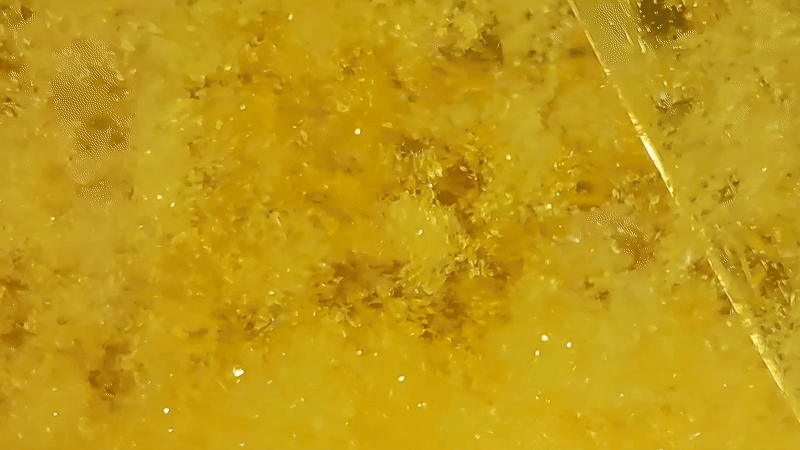
|
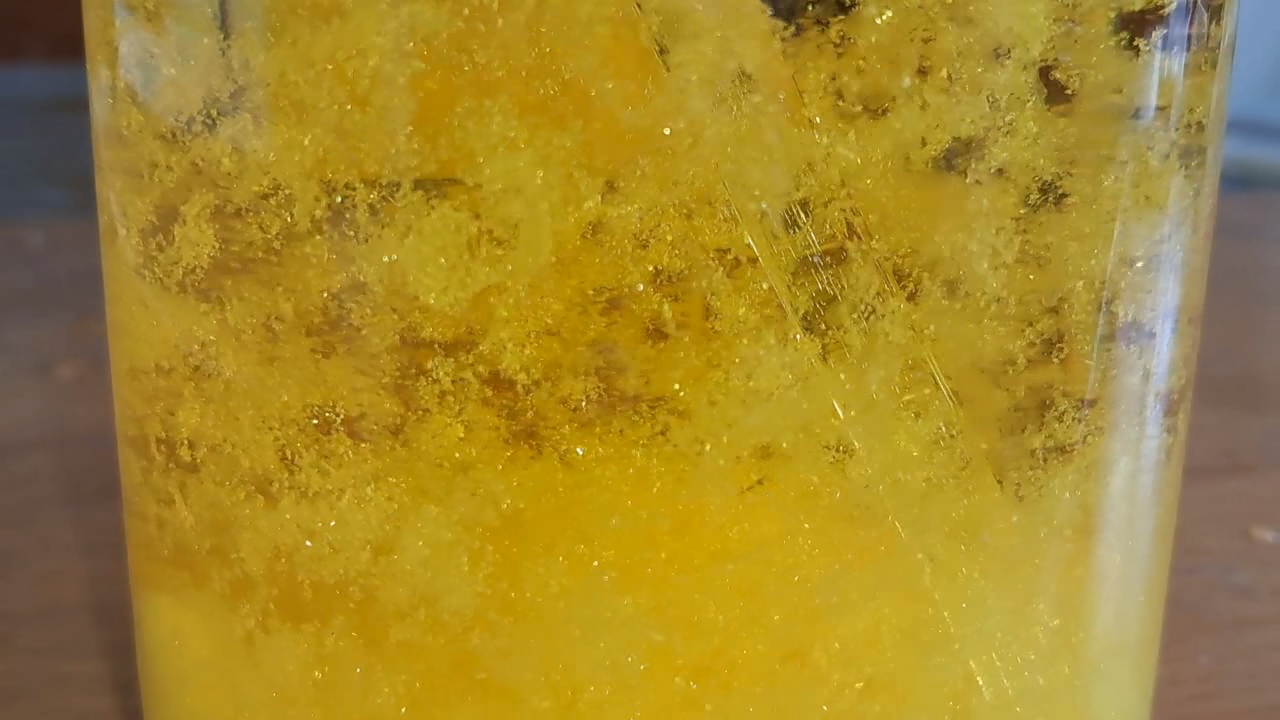
|
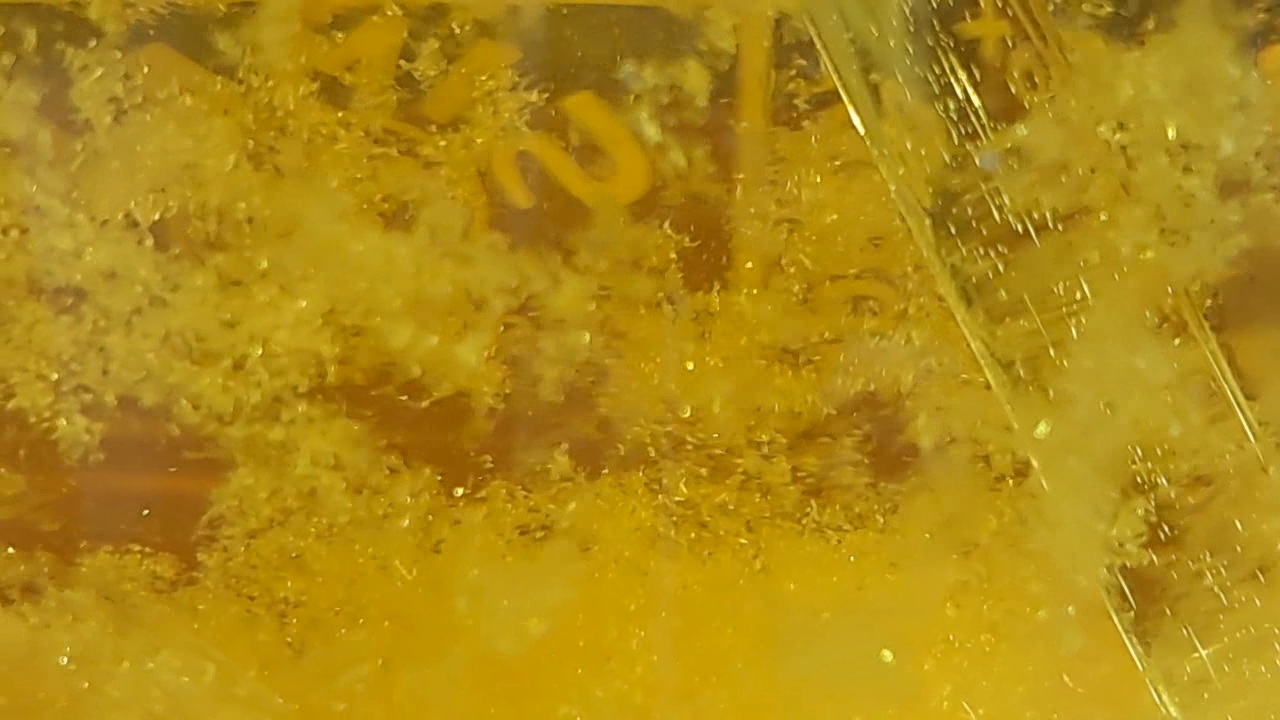
|
|
Комментарии
К1
Когда-то, ещё в школе, получал пикринку нитрованием аспирина. Сколько помню, там серная не нужна - не так он легко окисляется. В таблетках есть, кажется, немного крахмала - но он не мешает. Лишние группы по ходу нитрования отваливаются самостоятельно.
К1-1 В лаборатории ее чаще получают исходя из салициловой кислоты. Много лет назад я даже купил килограмм (хотя с деньгами тогда были проблемы) - хотел синтезировать пикриновую кислоту. Но руки так и не дошли. |